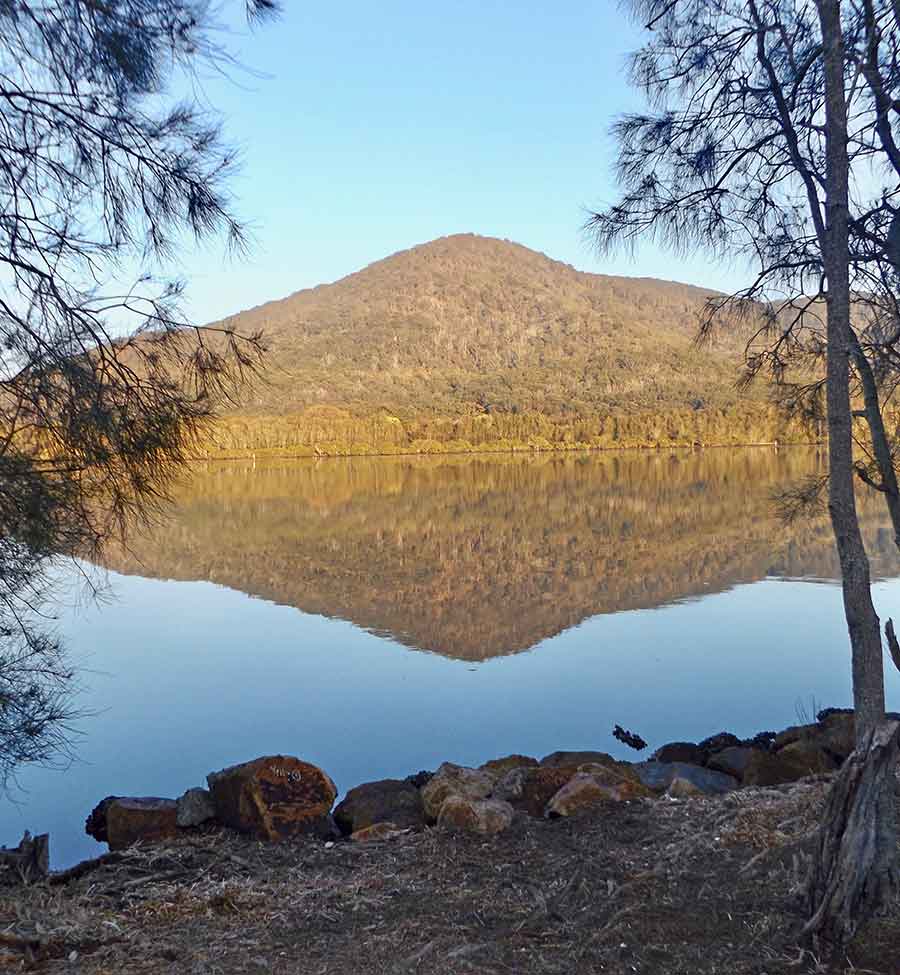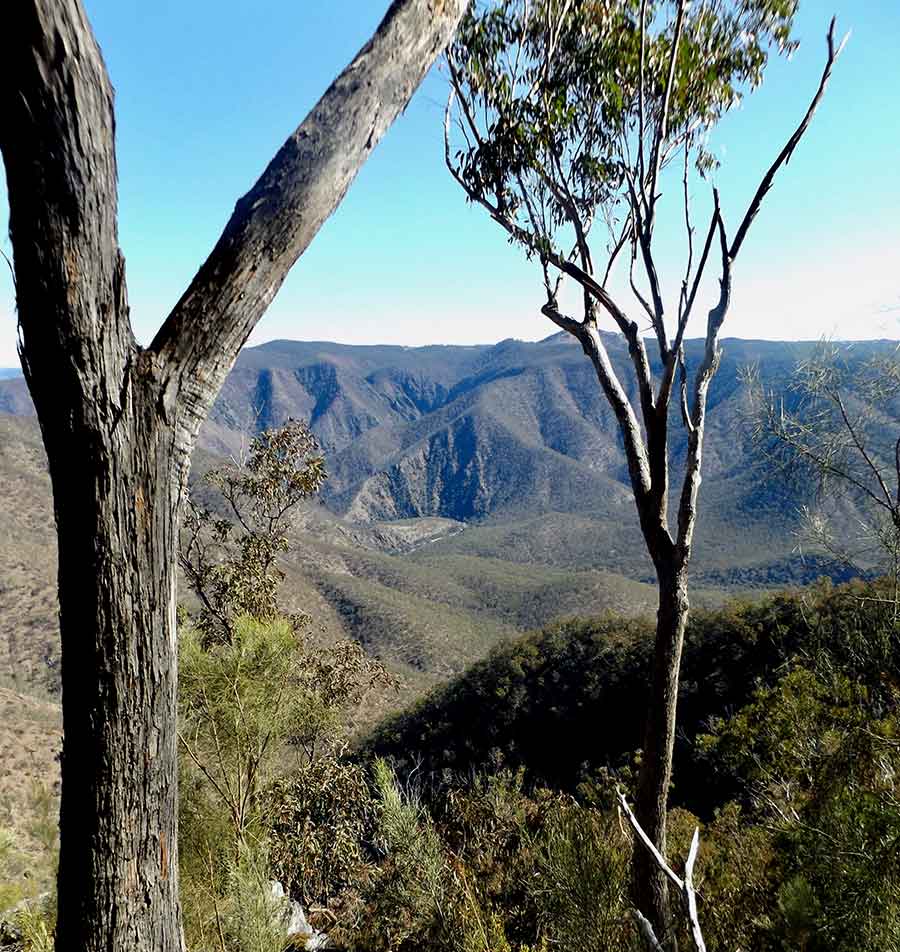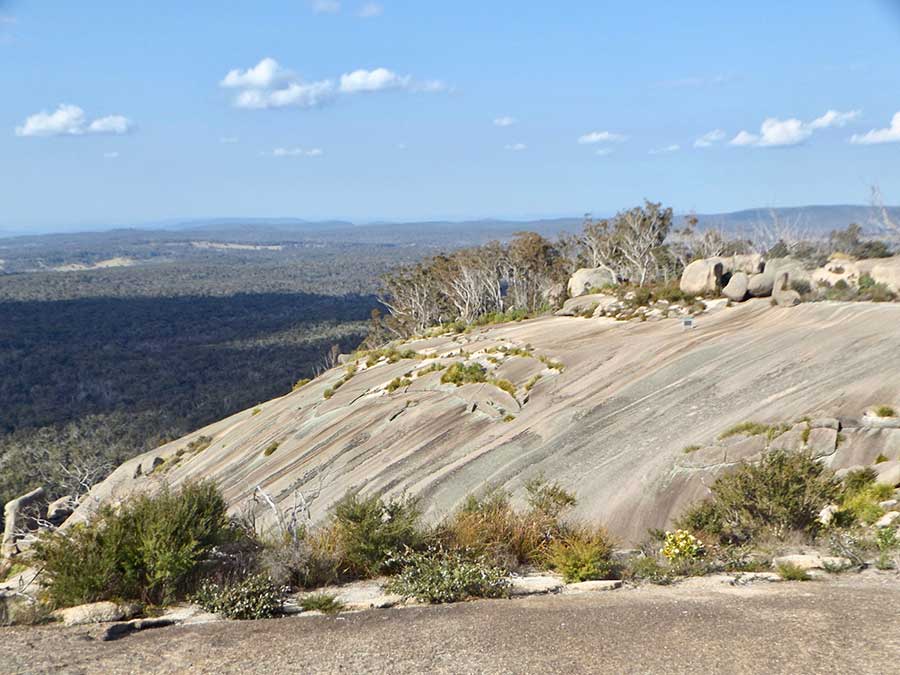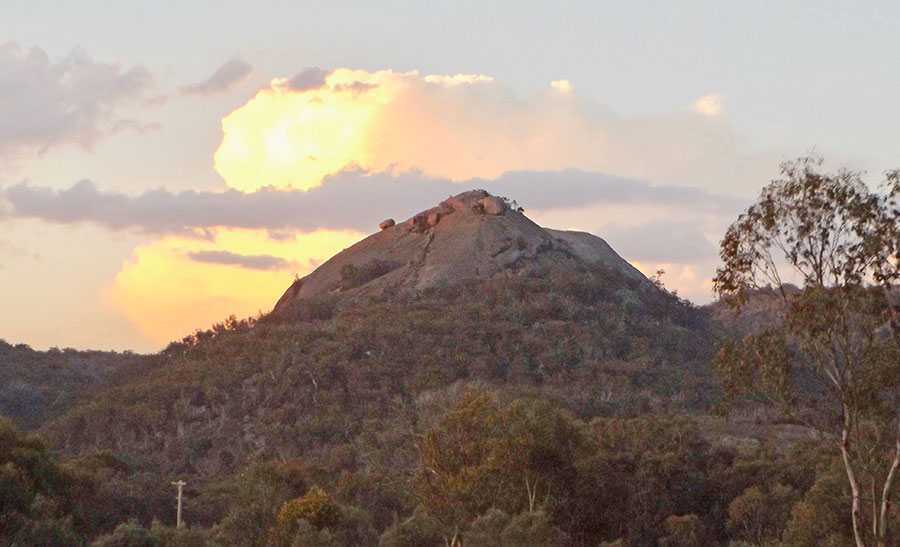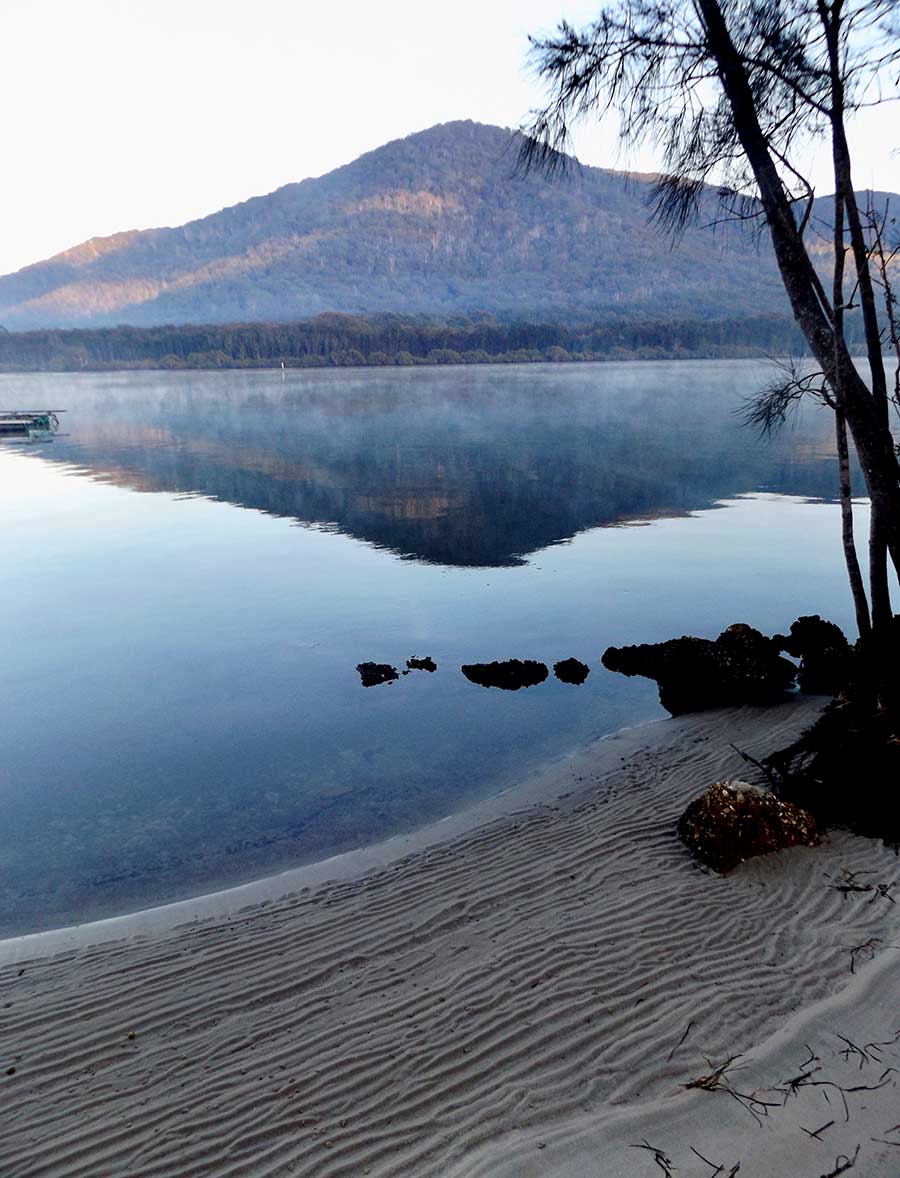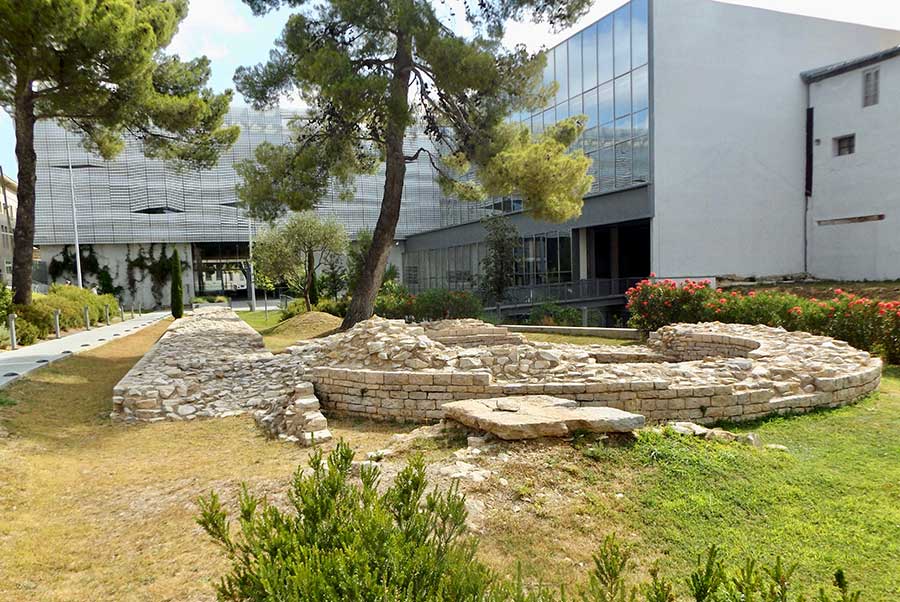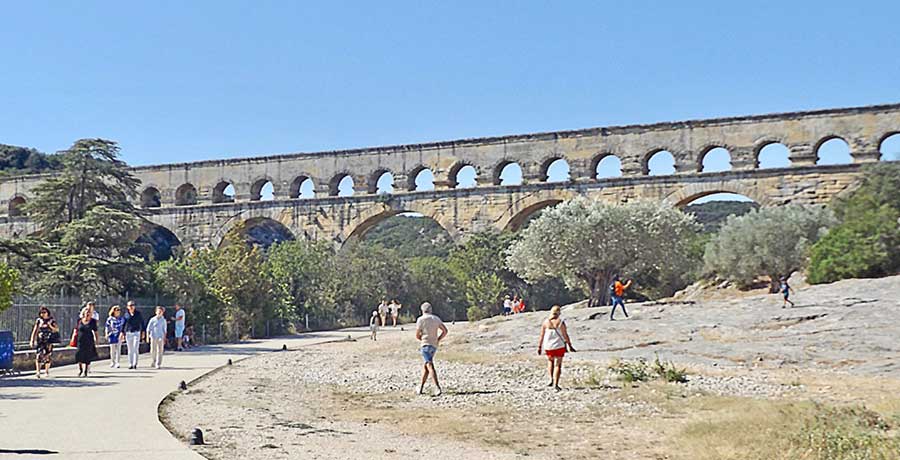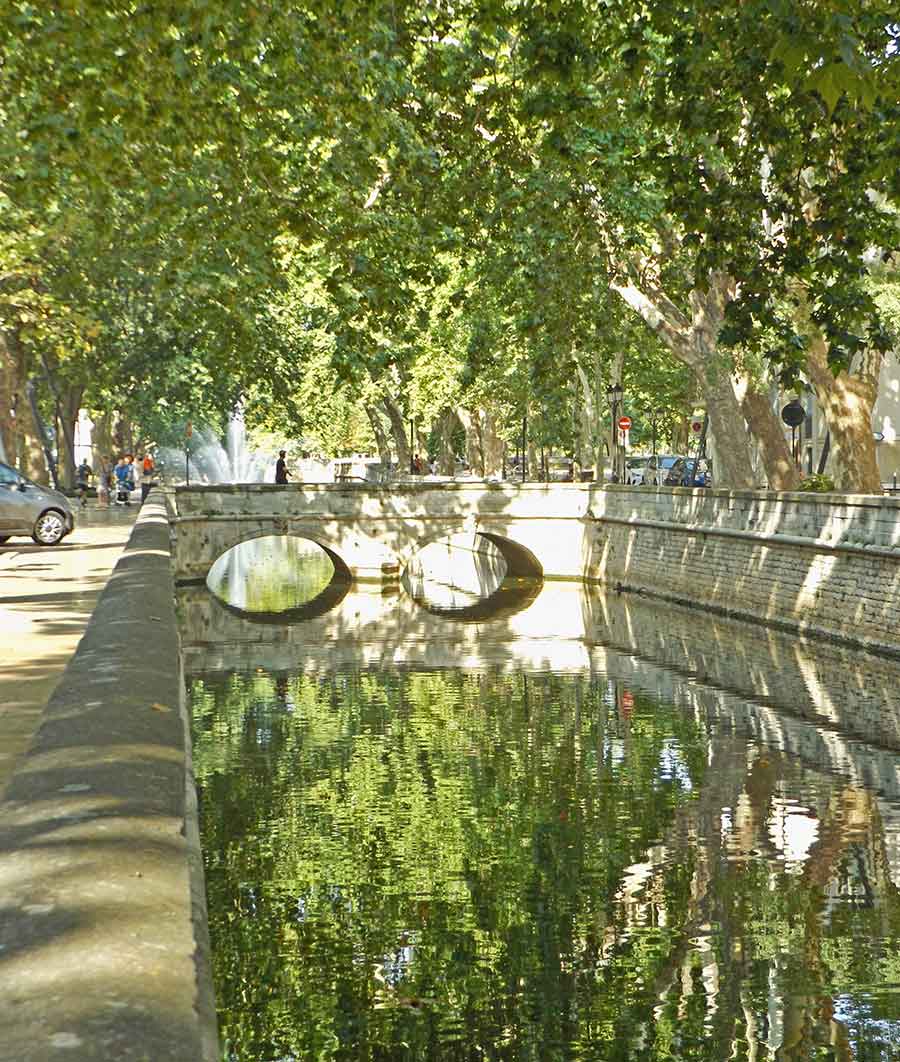Coastal offerings
Early mornings often catch the river near Dunbogan in its mirror-like state, with the seaside banks still dark but Dooragan lit up by the sun.
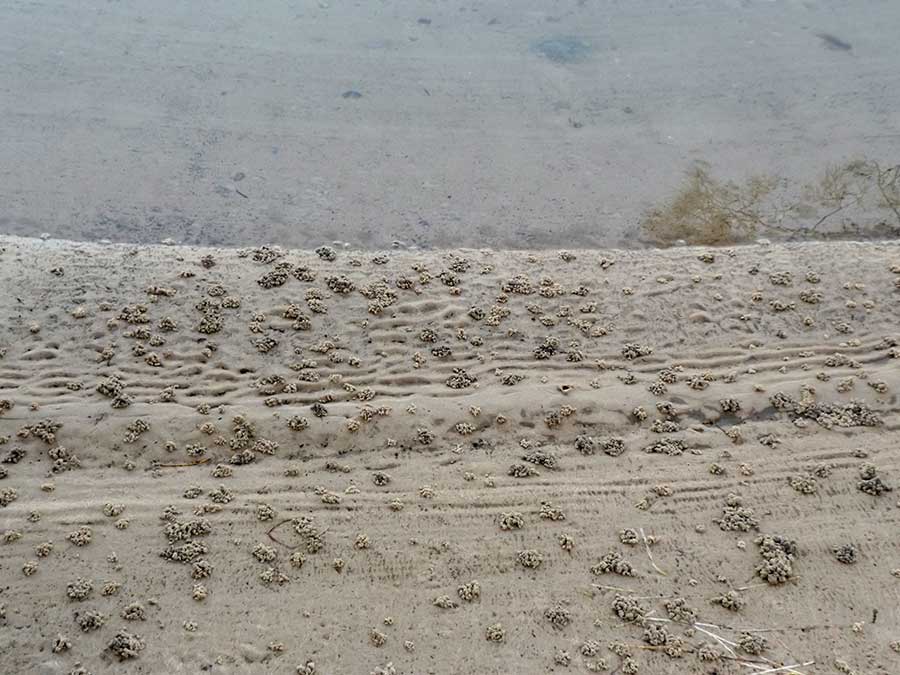
If it’s been a gently receding tide, the sandy shore shows how many residents have come up for air since.
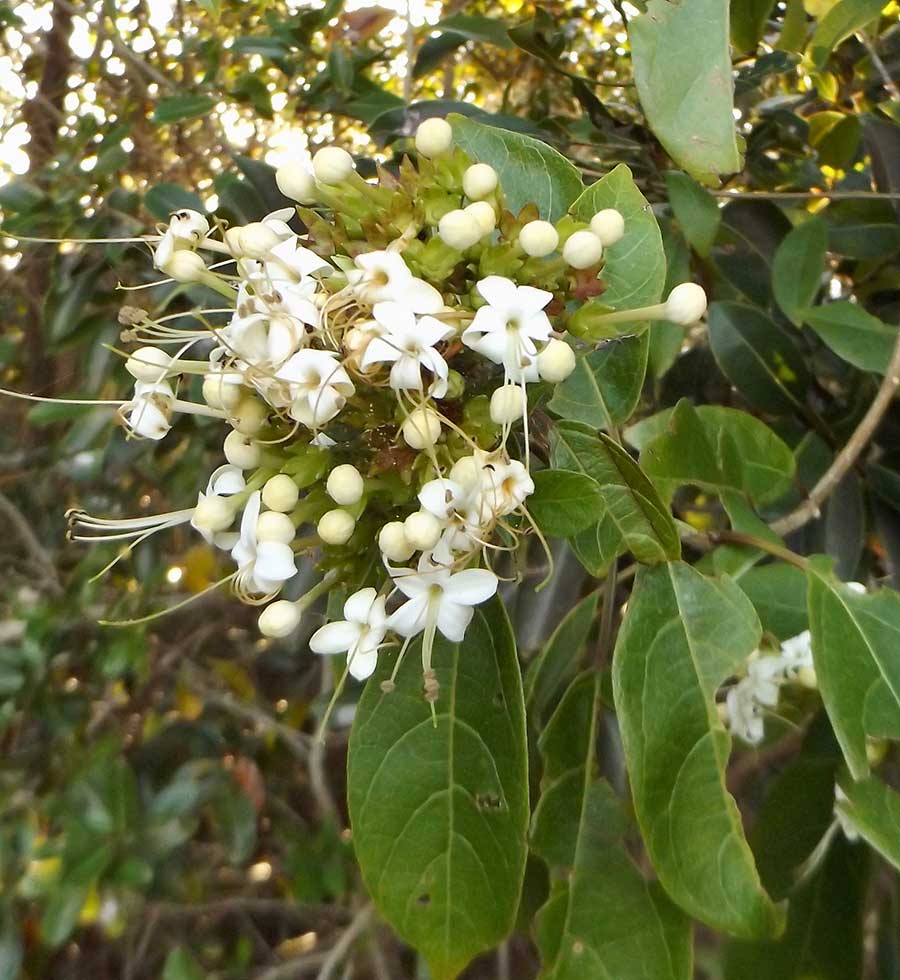
At Kattang Nature Reserve, on the clifftops, the showy yet virginal flowers of this small Clerodendrum floribundum tree flaunt their long stamens like antennae. Such flowers ought to be enough, but the fruit that follows is also stunning: black with fleshy red open collars or calyxes. No wonder it is also called Lolly Bush.
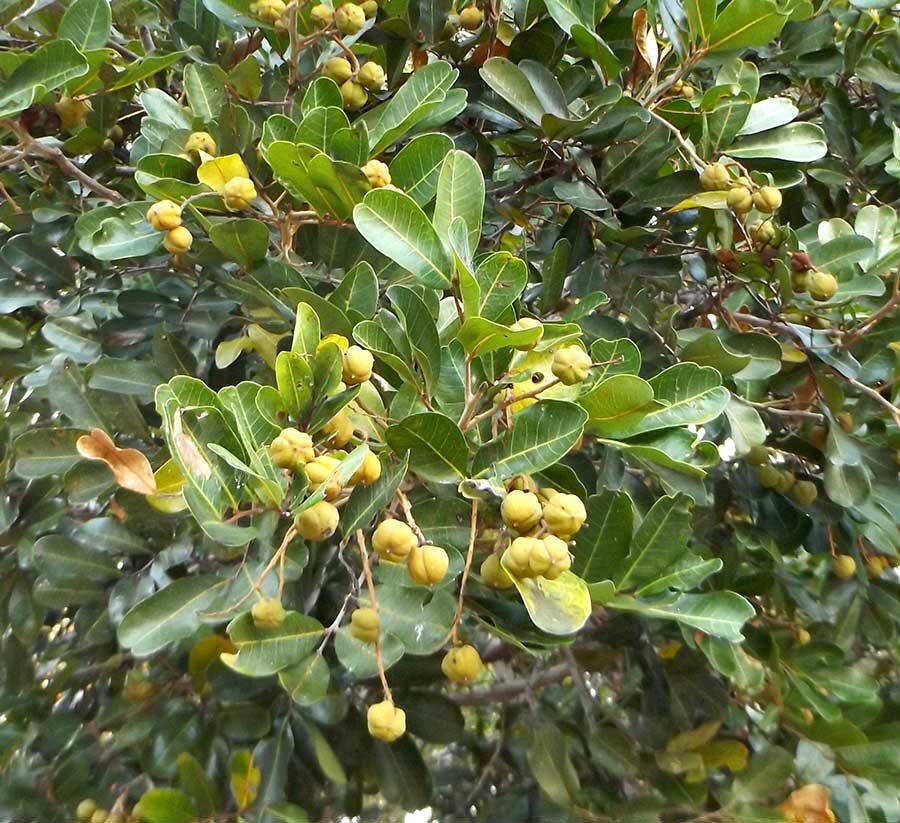
The Tuckeroo (Cupaniopsis anacardiodes) trees are fruiting now, although the ribbed balls are not yet the bright yellow they will become. Many birds like to eat the red seeds inside these.
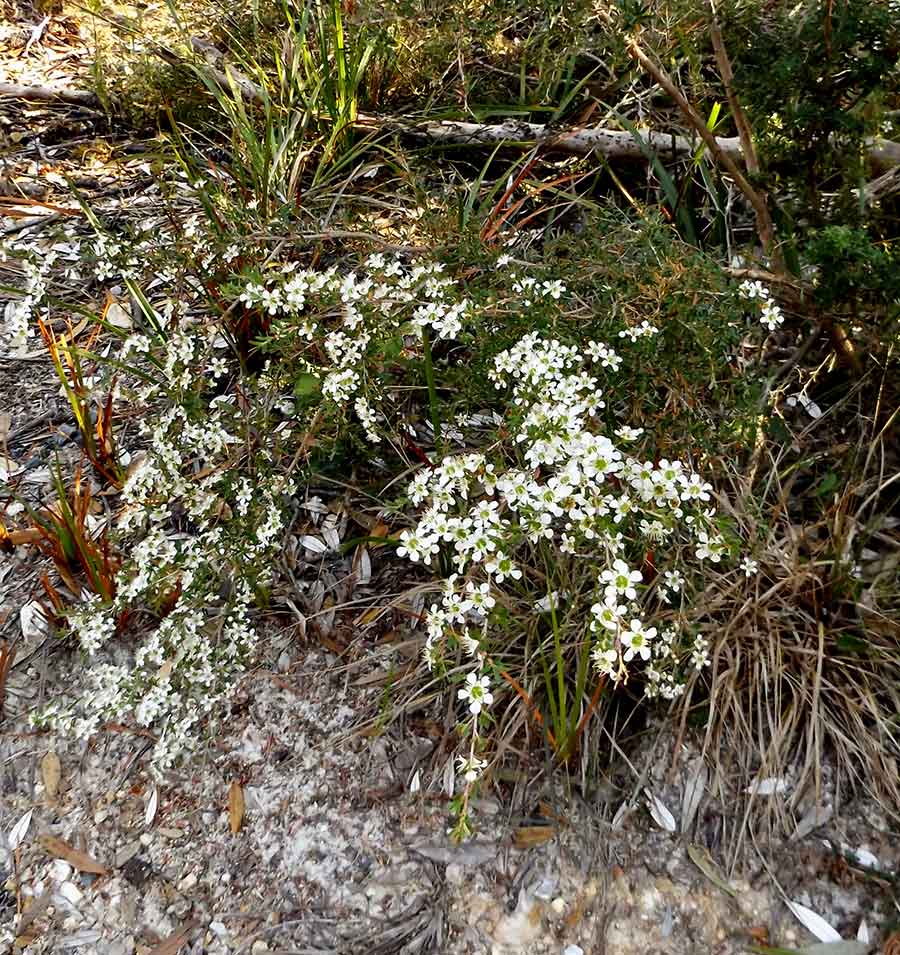
Common to the point of being over-abundant there, what I assume is the Coastal Tea Tree (Leptospermum laevigatum?) is displaying beautiful arching branches of its simple white flowers.
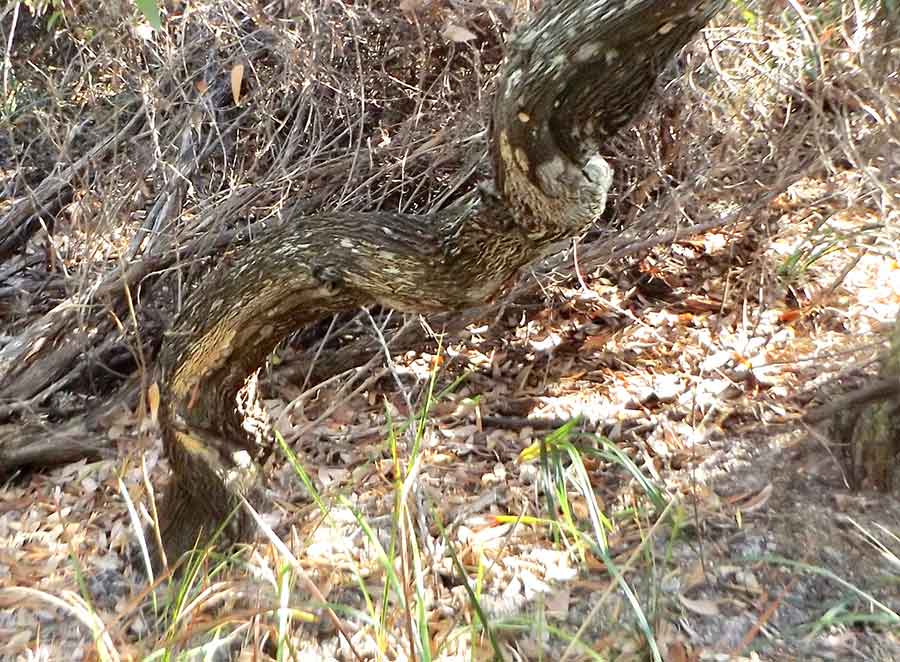
And my final treat from that walk at Kattang is this twisted and lichened trunk, almost reptilian. I always want to ask such unusual trees for their history: how and why did you grow like this?
Final Falls
Sightings of this Brushtailed Wallaby at Dangar Falls campground near Armidale was the best part of that visit. As elsewhere, the Falls themselves were suffering from the drought.
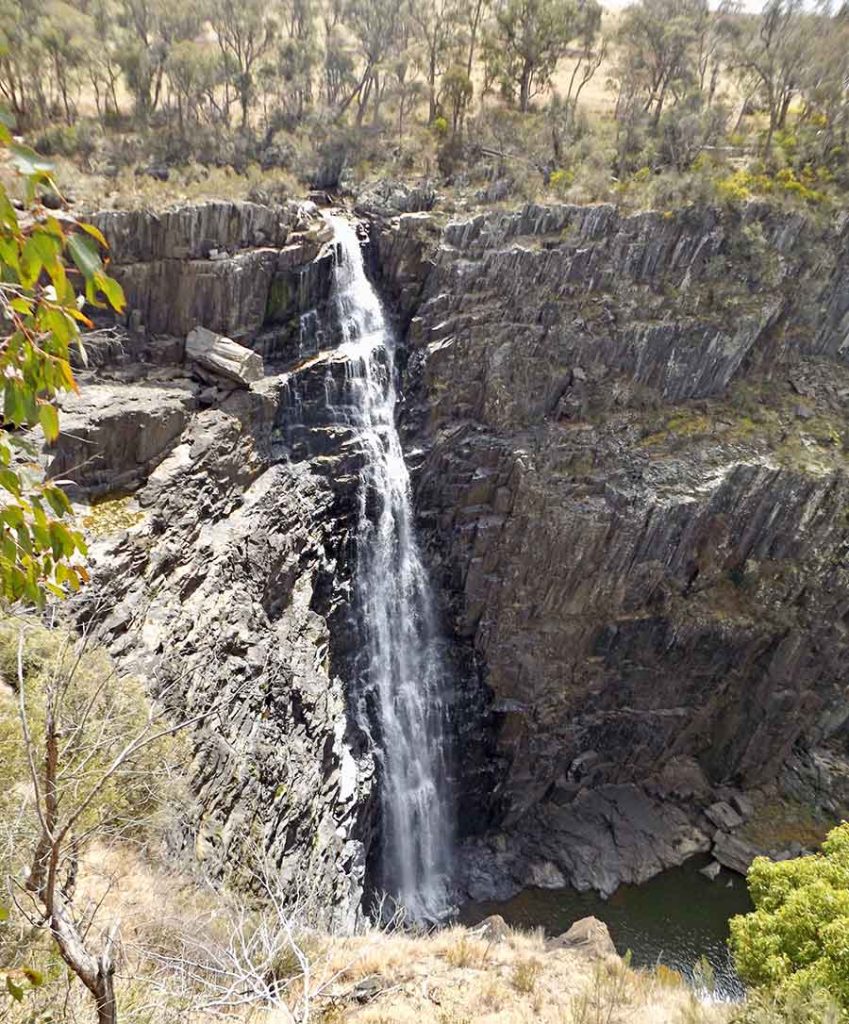
But at my final Gorge camp, at Apsley Falls near Walcha, there was an audible and visible waterfall. Perhaps because nearer to the coast, so more rain?
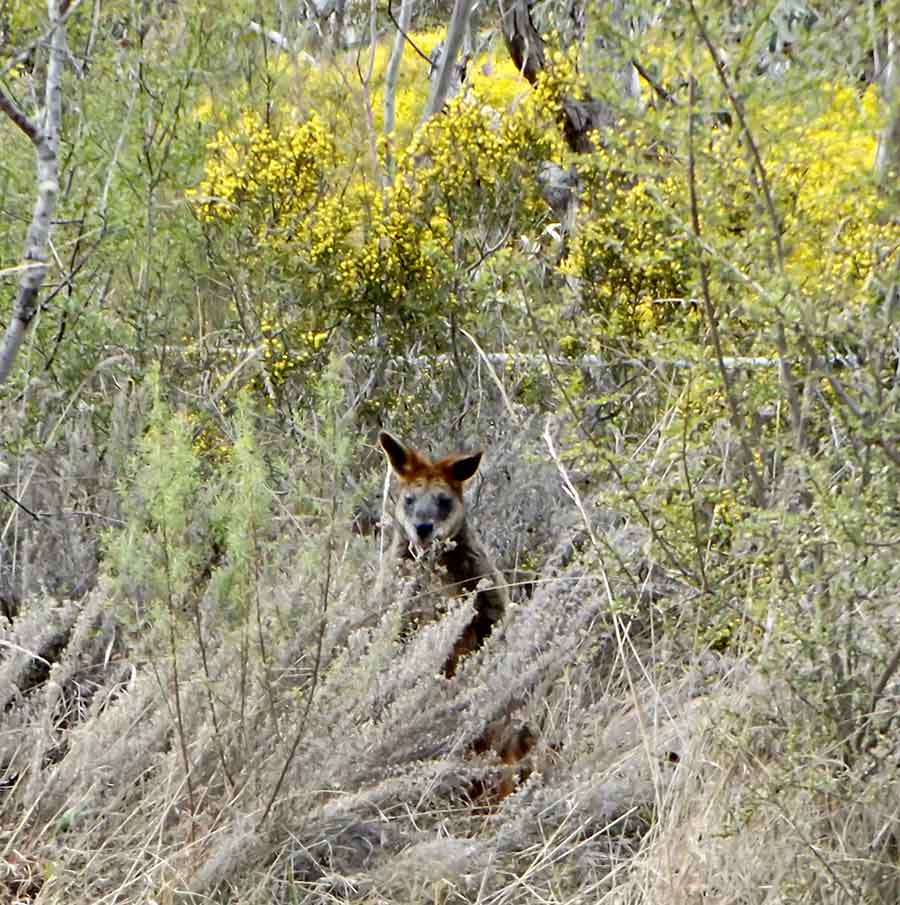
Plus there was another Brushtailed Wallaby!

The view of the Gorge was tainted forever for me when I read that from the 1830s increasing settler numbers caused much grief to the indigenous people. I know, that happened everywhere; but here a party of settlers on horseback chased a group of Aboriginal people to the edge of that cliff… and over, to their deaths.
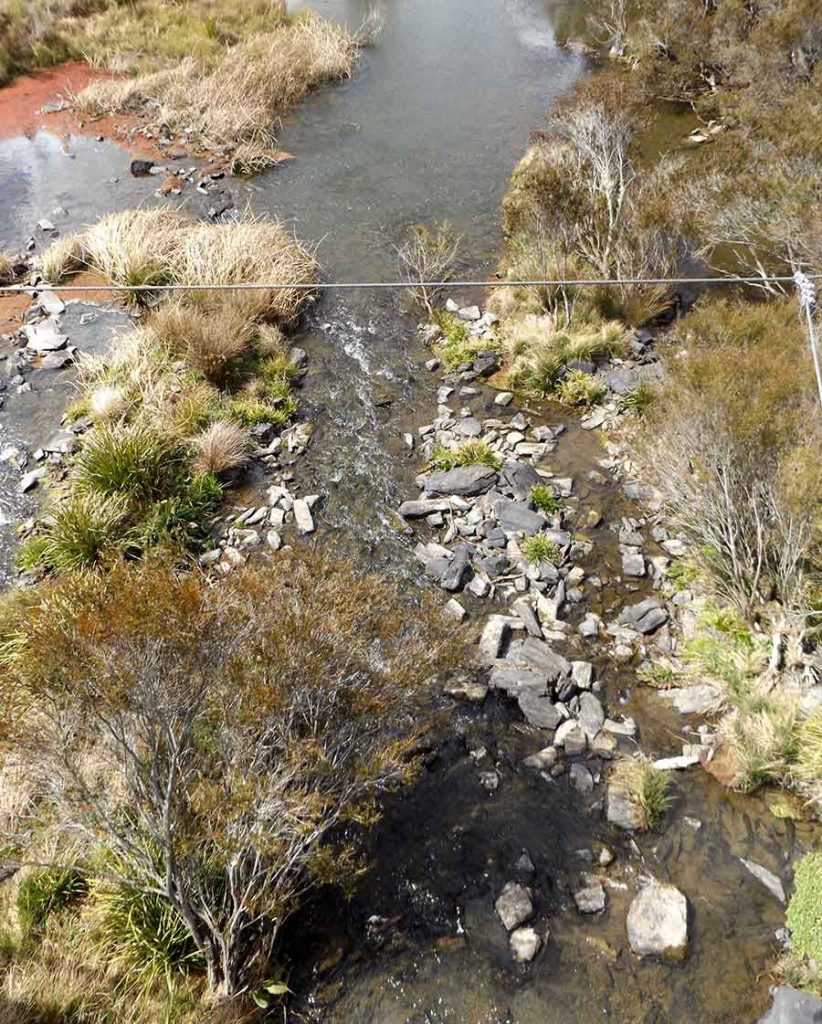
After that, the plunging steep sides filled me with horror and I had to turn back to the land above the Gorge, to the relatively healthy creek that feeds those falls.
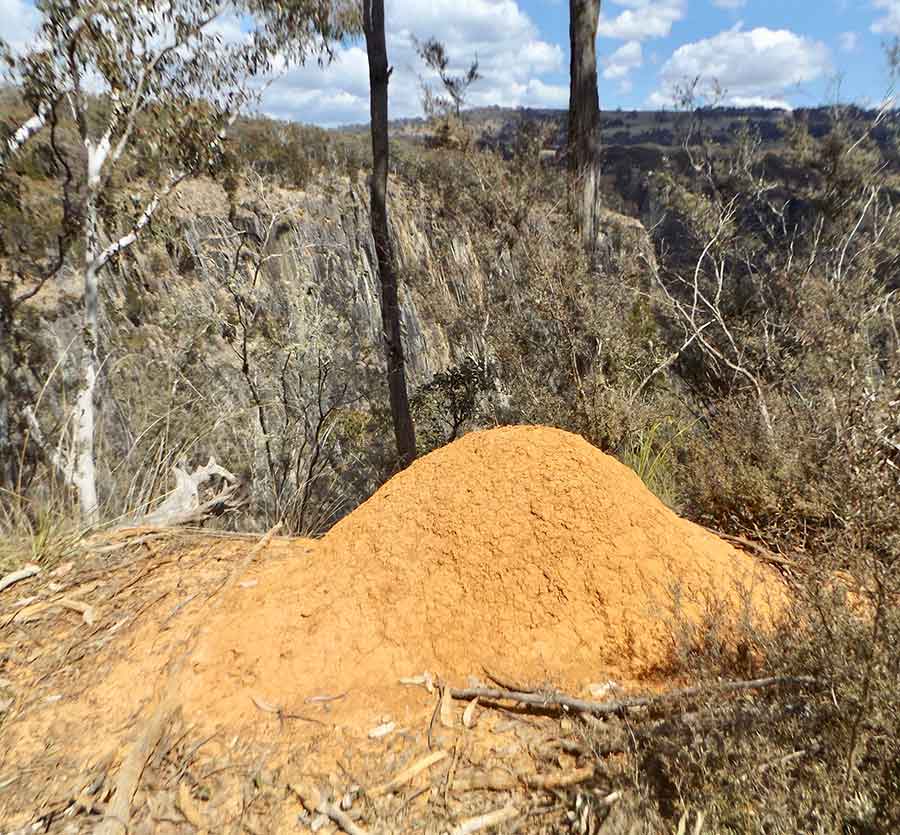
And to allow the bush to soothe and surprise me again.
Unlike at Bimblebox, termite mounds are not common in this country, but especially in this vivid colour, so unlike the soil here generally.
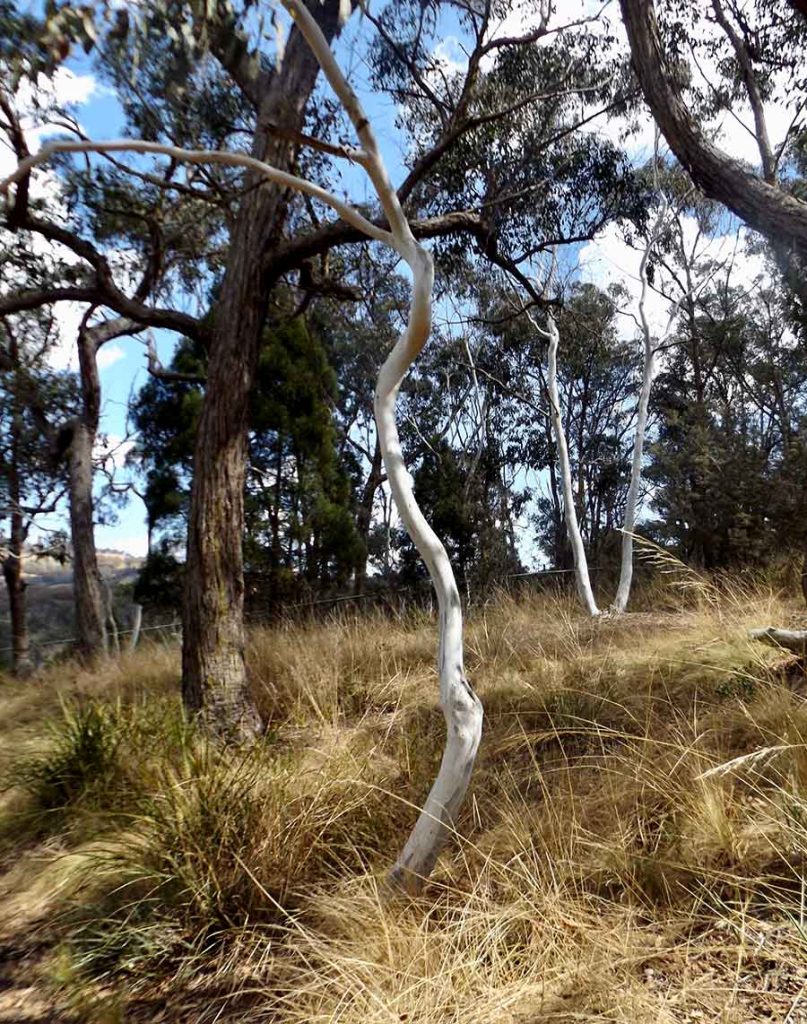
The slim sinuous white gums kept catching my eye. Snow Gums are found here; is that what these glowing beauties are?
Grand Gorge country
The Oxley Wild Rivers National Park on our tablelands has spectacular gorges, and usually equally spectacular waterfalls, although the drought has rendered most of the latter mere long narrow threads of water, if even visible.
My first glimpse was from Long Point campground, a small and satisfyingly empty one at the end of a long dirt road.
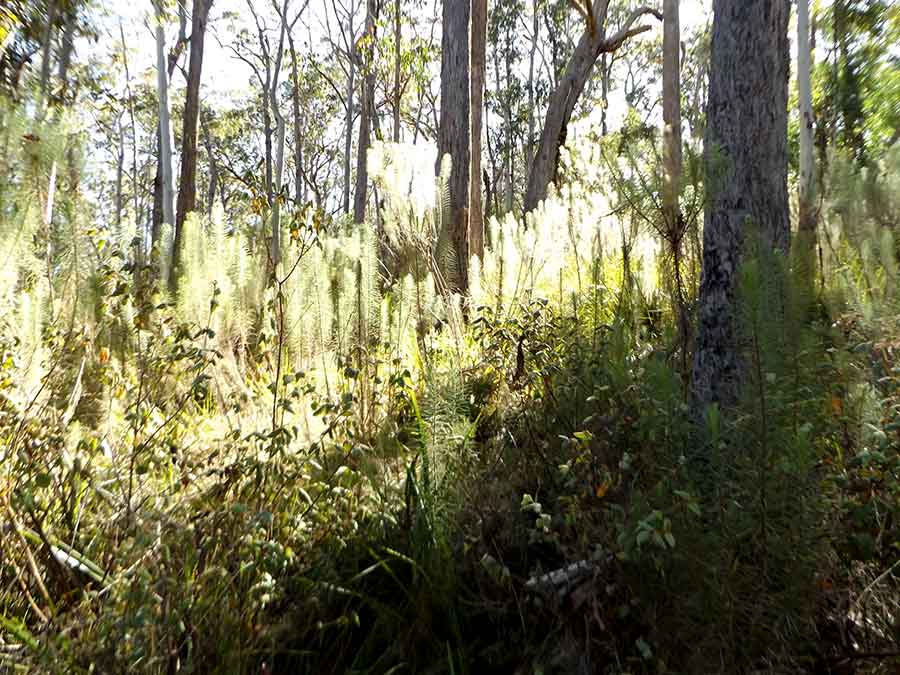
The Cassinia Walk passed along the edge of the gorge, through a literal forest of these tall plants, which were mostly not flowering yet. I don’t know which Cassinia they are, as the ranger I asked said they were weeds…
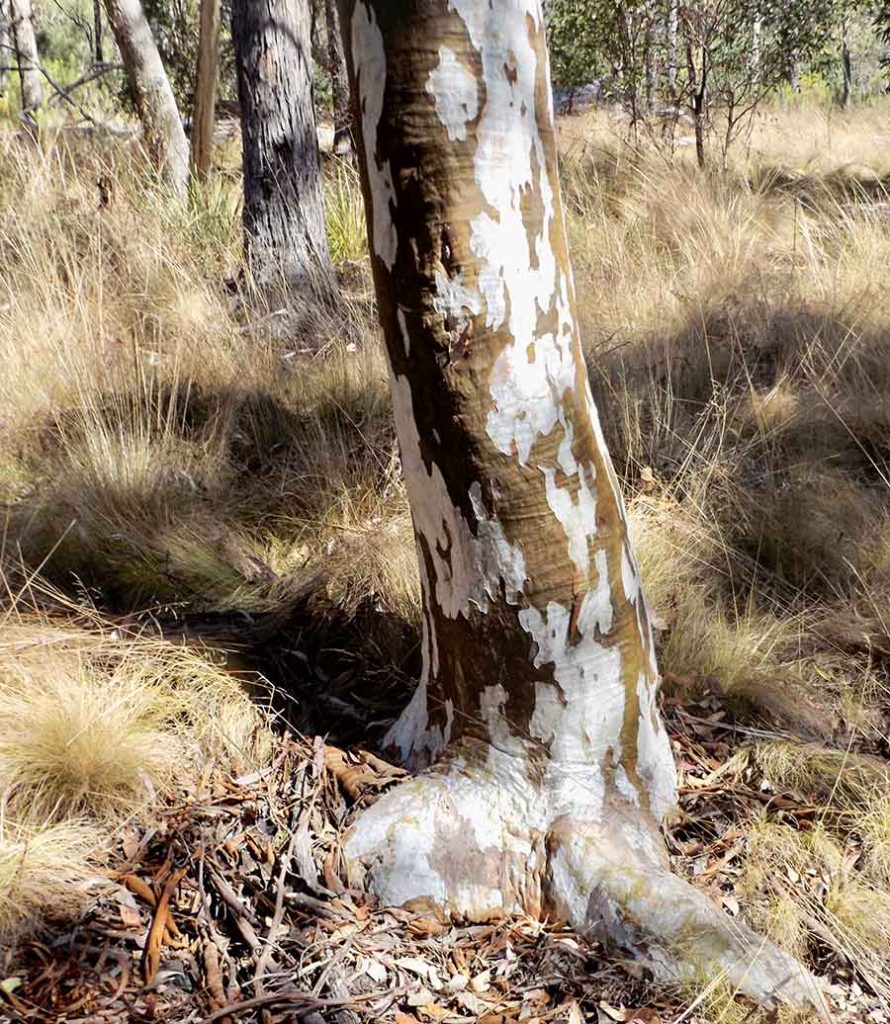
The other thing I asked about was the name of these trees, with their dramatically mottled bark. I was told they were Spotted Blue Gum, which I can’t find, and, given the Cassinia mislead, I can’t trust. But it would seem that Spotted Gums themselves do sometimes have such large blotches.
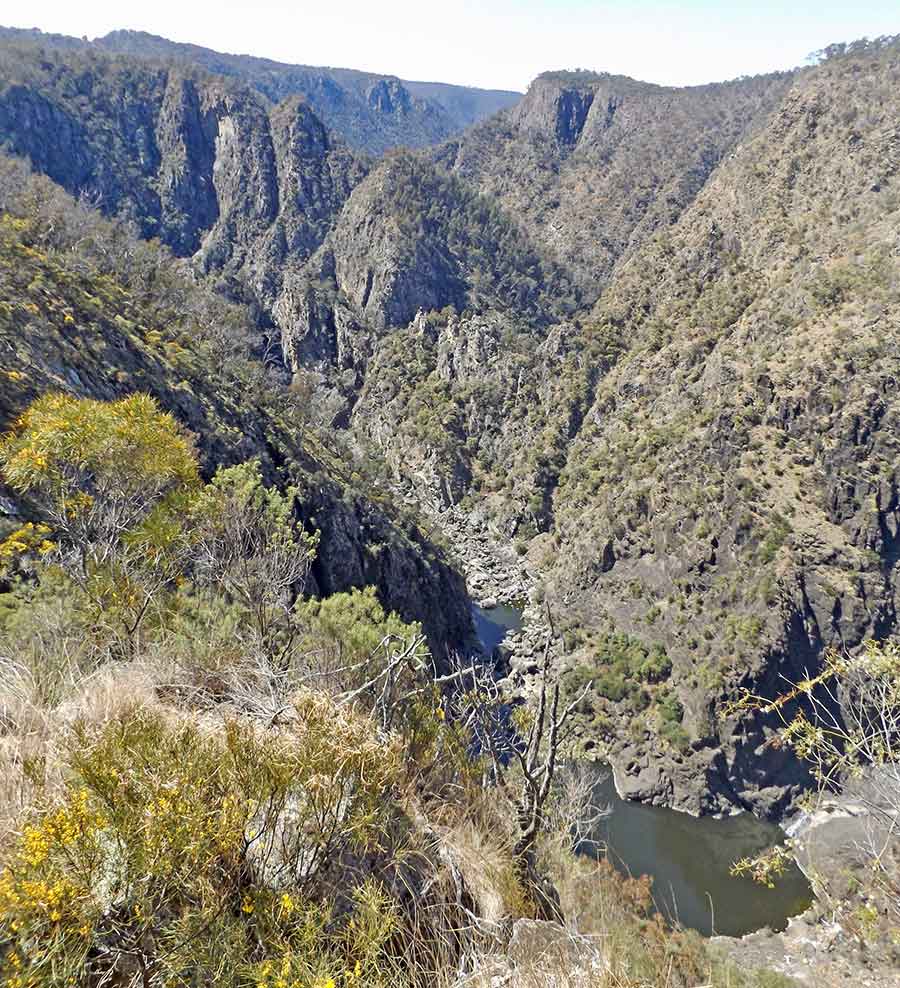
My next camp was at Wollomombi Falls. Stranded pools could be seen way down below.
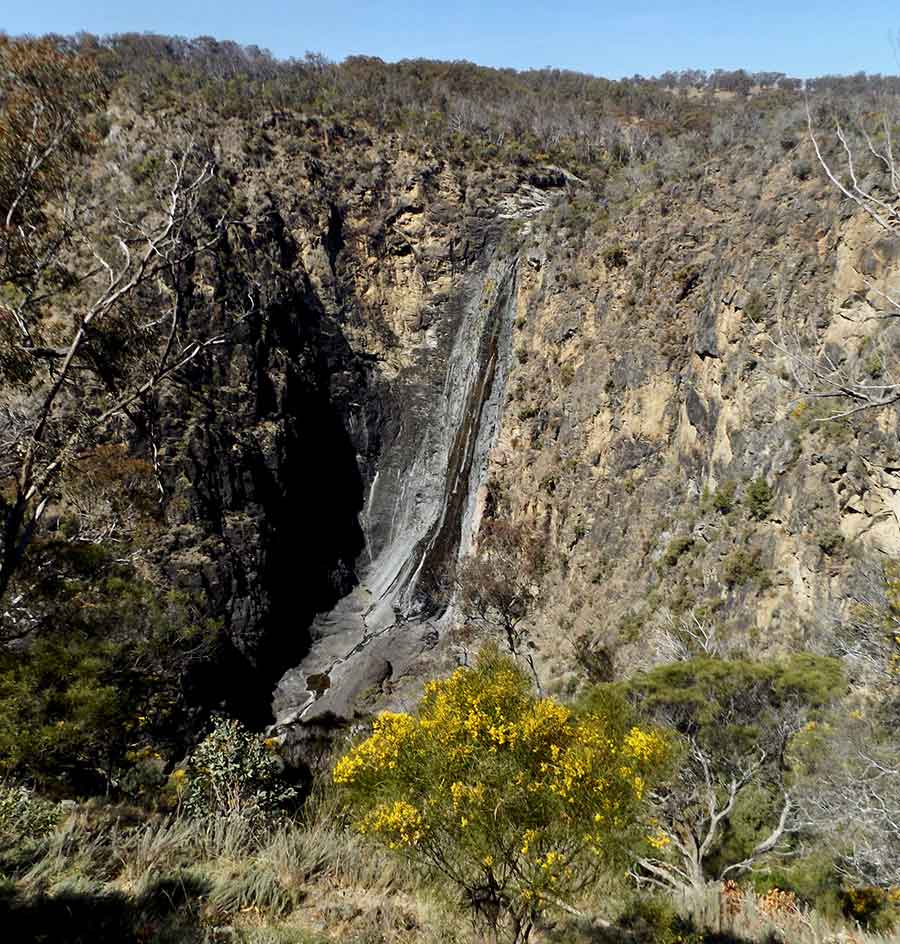
The ‘Falls’ were barely running enough to fall.
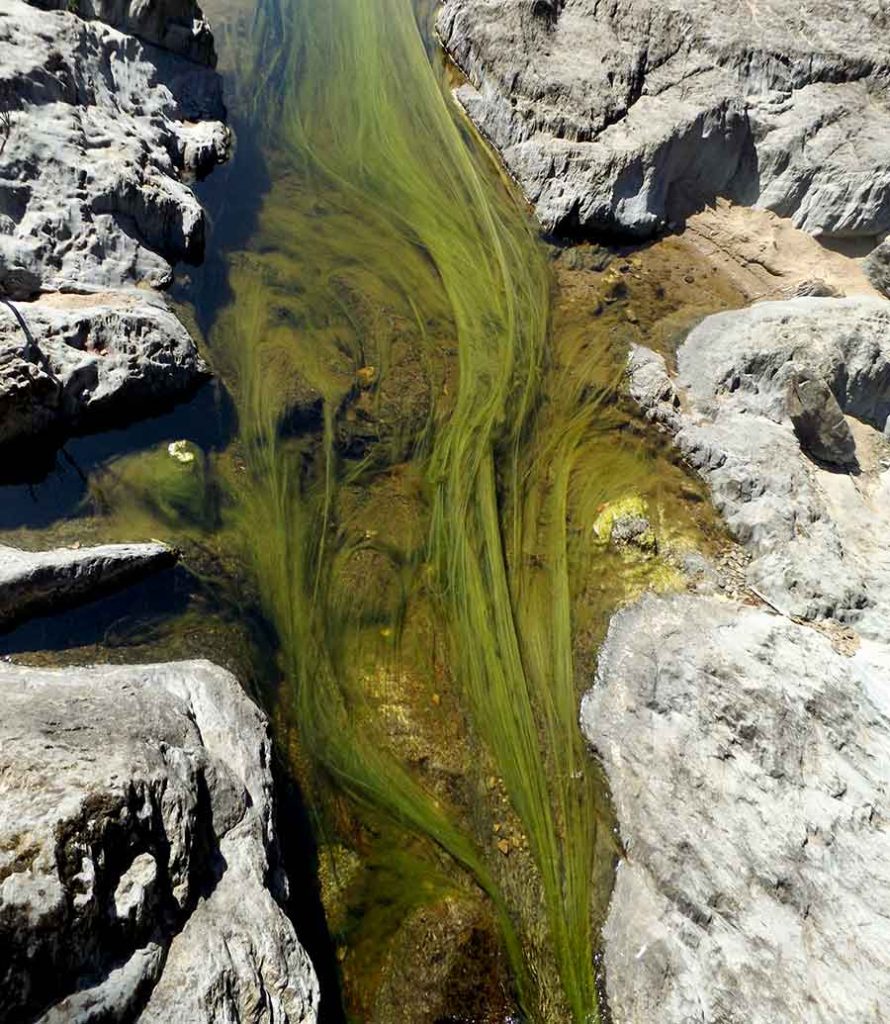
The creek that fed them was as weedy as watery.
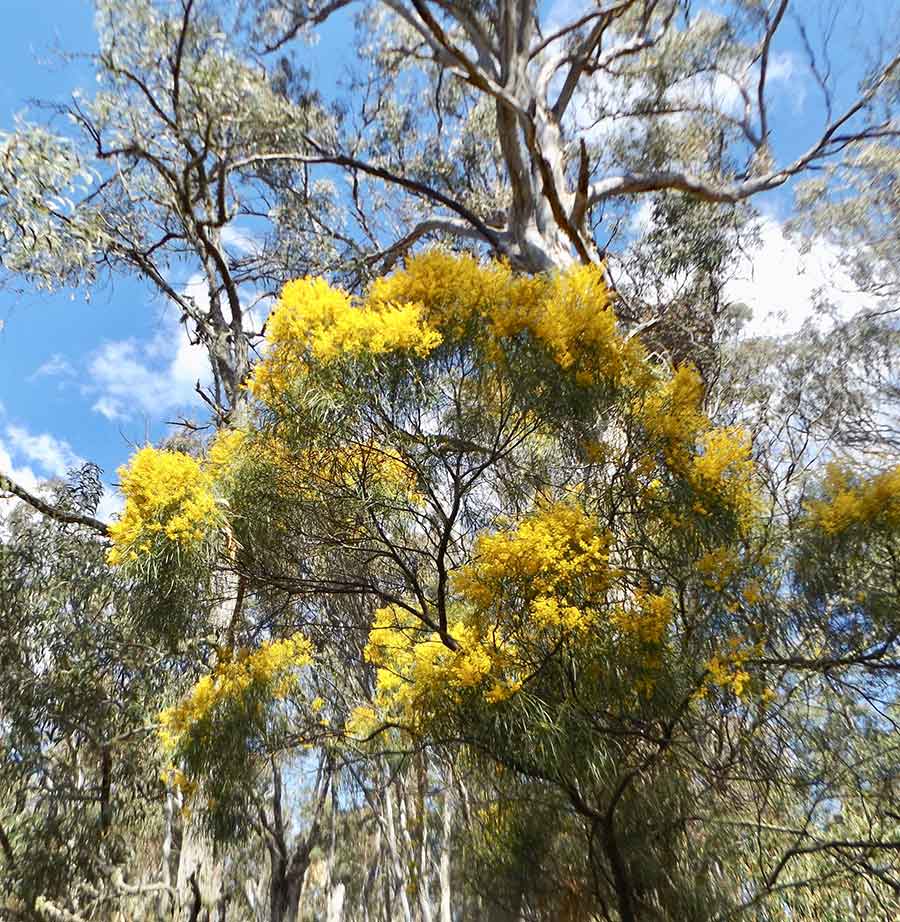
A very beautiful wattle, indigenous to these gorges, was in bloom everywhere here: Gorge Wattle, (Acacia ingramii).
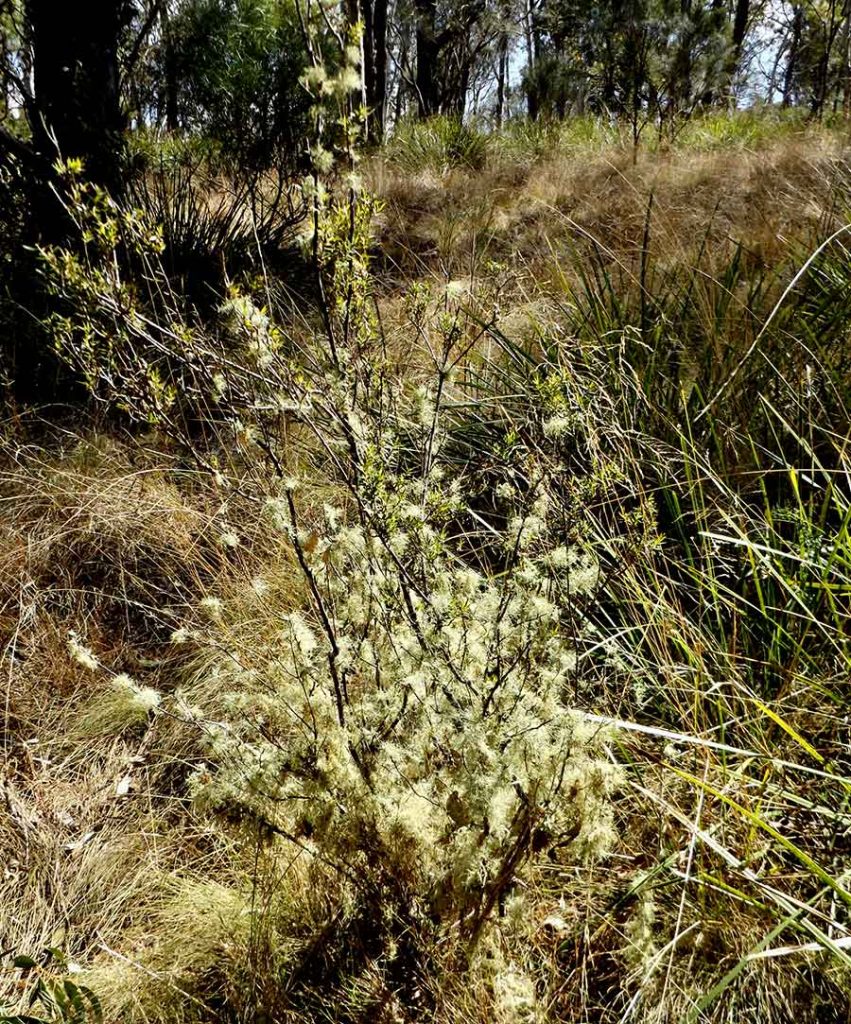
As always, I found the lichen bedecking dead shrubs to be as attractive as any flowers.
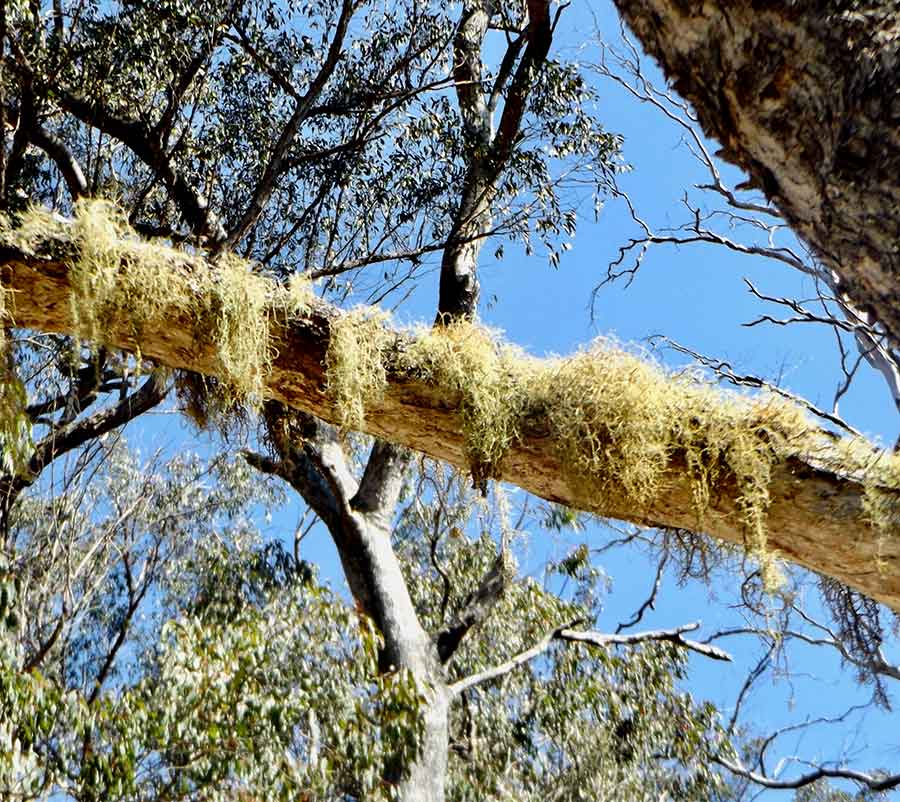
When lichen lies along a branch like a hoary basking lizard, I am entranced…
Amazing Bald Rock
Bald Rock National Park is near Tenterfield and this mightiest of the many mighty granite domes in our tablelands region is truly impressive. In fact, it is the largest granite dome in the southern hemisphere.
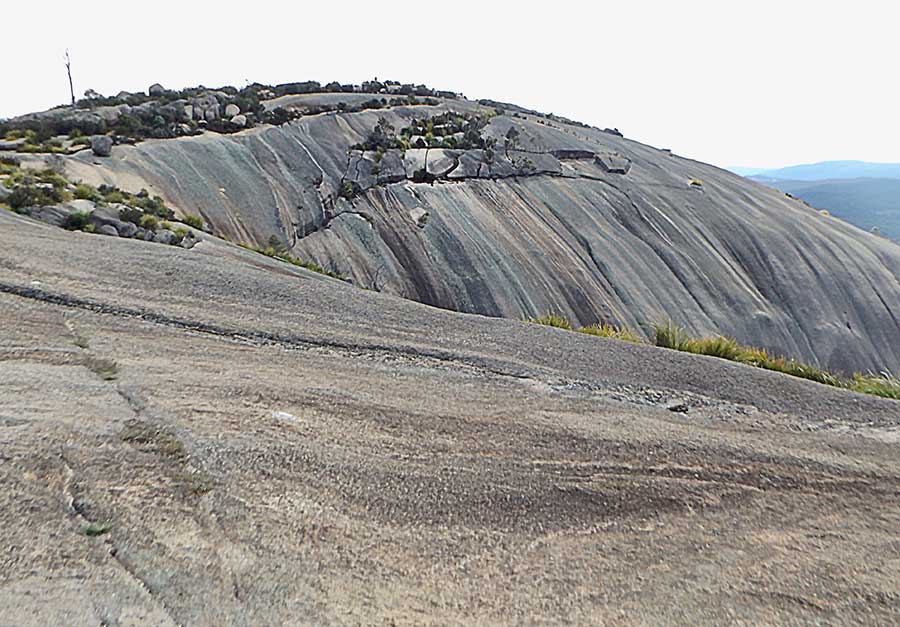
For once I was able to screw up my courage and brave the slanted walk across the top surfaces, leaning uphill and trying hard to ignore the downwards pull I always feel. White dots tell you where is safe to walk, but they don’t know my imagination…
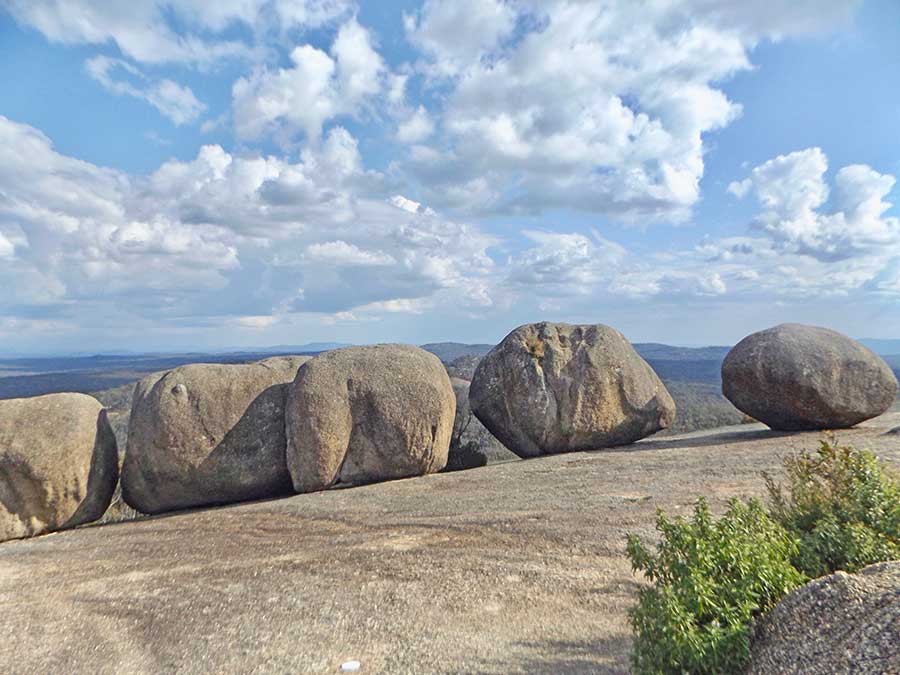
Yes, the view is 360 degrees, but for me more fascinating is that these huge boulders are ranged in a neat row on top — by whom and how?
Or that in sheltered cracks and dips, surprising plants manage to grow up here.
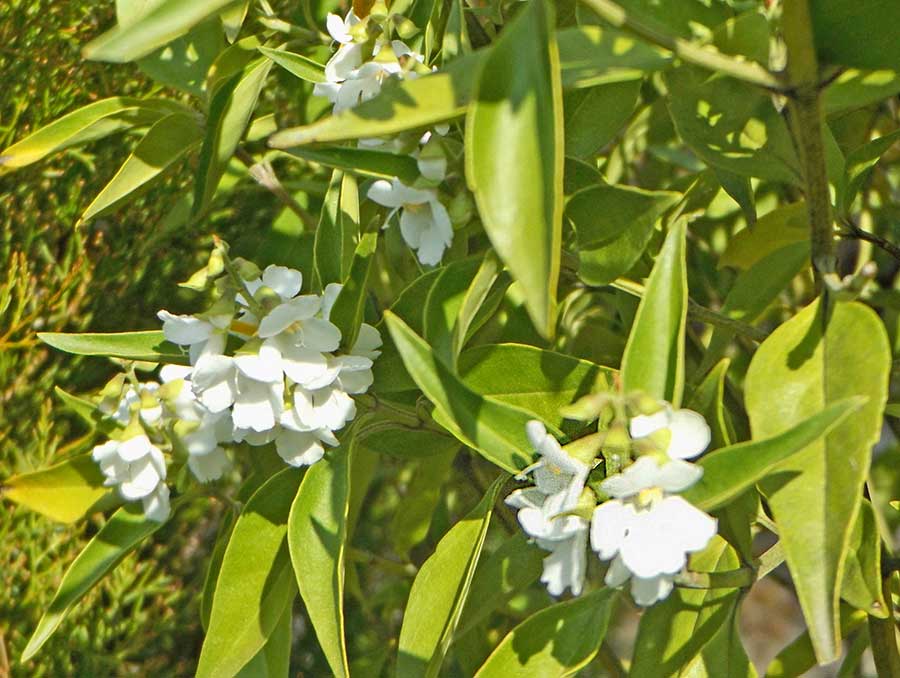
Like these aromatic shrubs of Prostanthera petraea, White-flowering Mint Bush, as delicate in appearance as any pampered garden plant; only found in such granite pockets in this region.
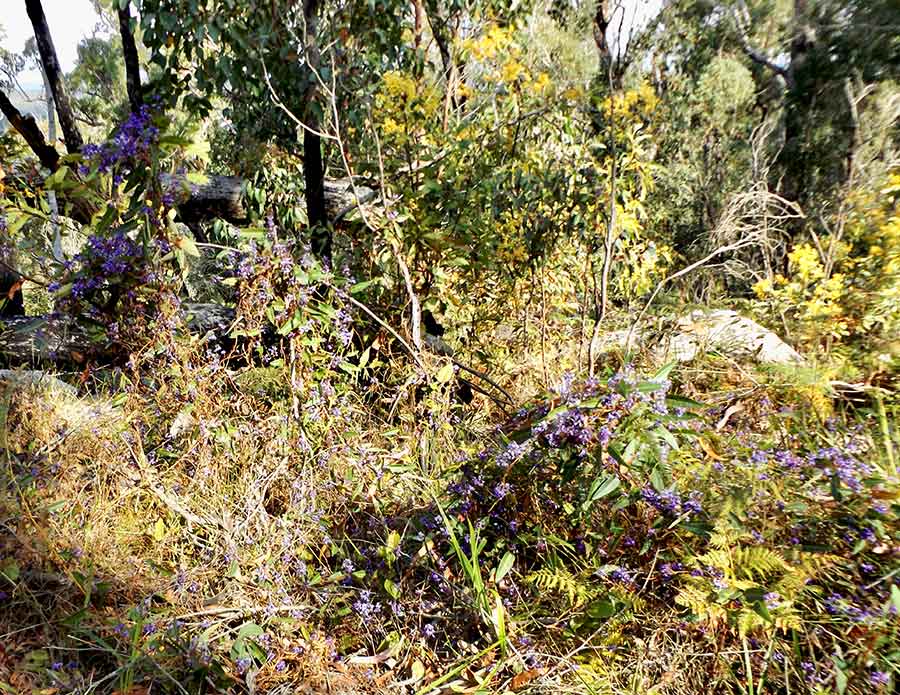
I admit I took the easier option of getting to the Rock, taking the Bungoona Walk which was gentle and extremely varied. While wallowing in the scent of masses of wattles, I loved the dominance of purple Hardenbergia, climbing shrubs and sticks or rambling over the ground.
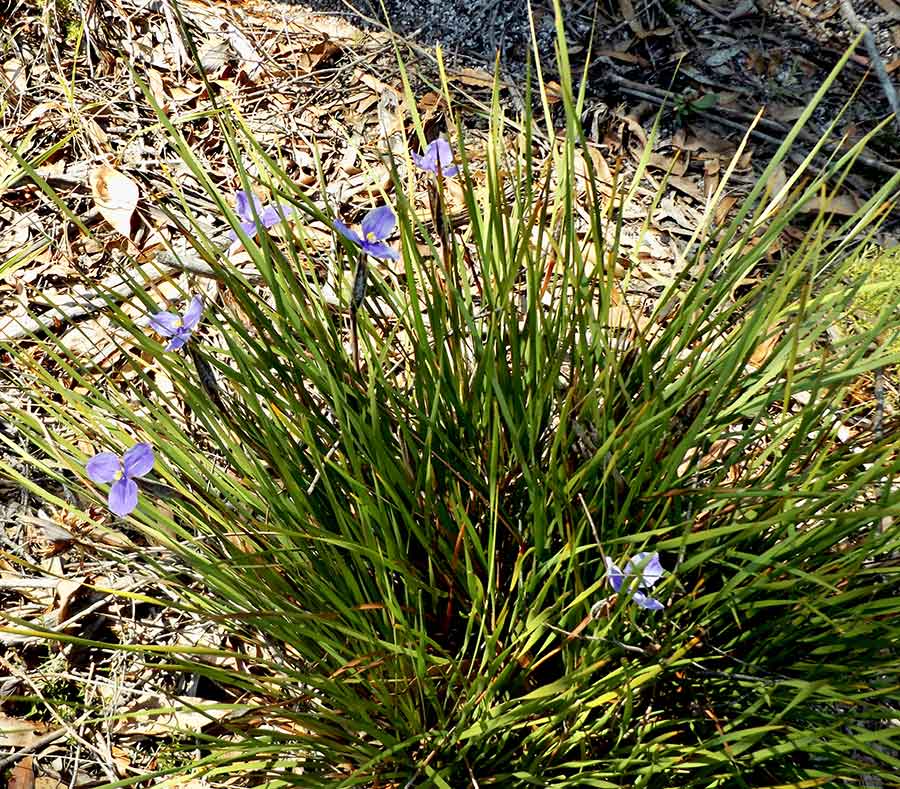
Clumps of Flag, from pale lilac to deep purple, appeared now and then. Shouldn’t our national colours be purple and gold instead of green and gold?
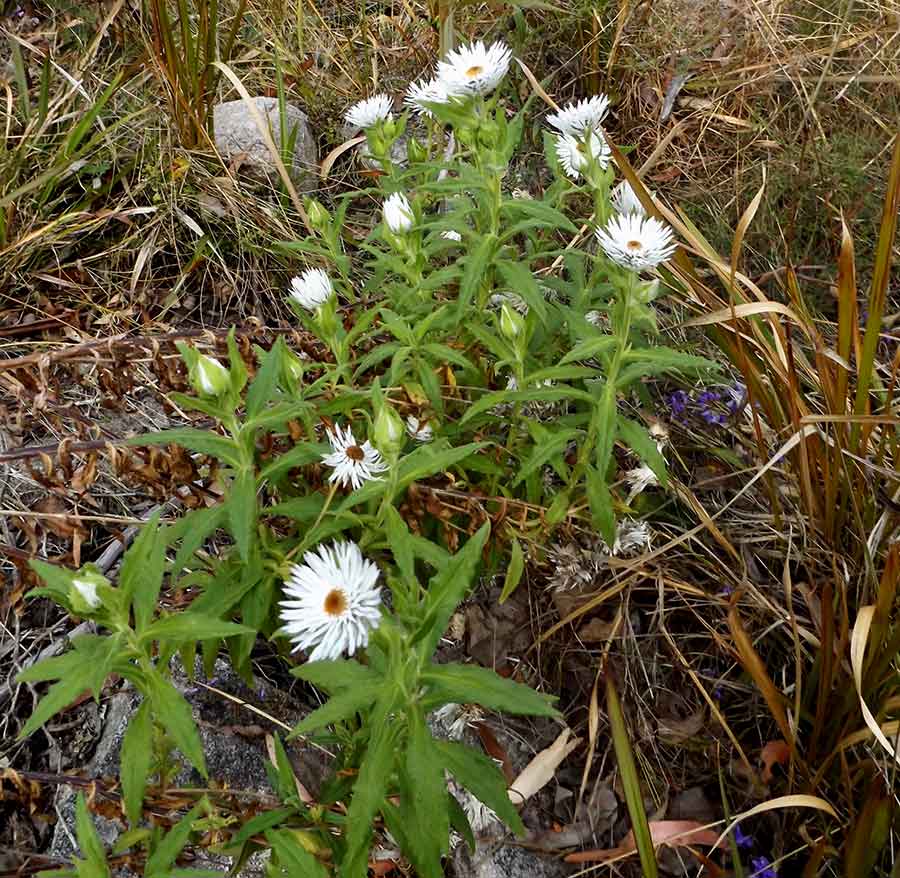
Another special regional plant I spotted on the way was the perennial Coronidium boormanii.
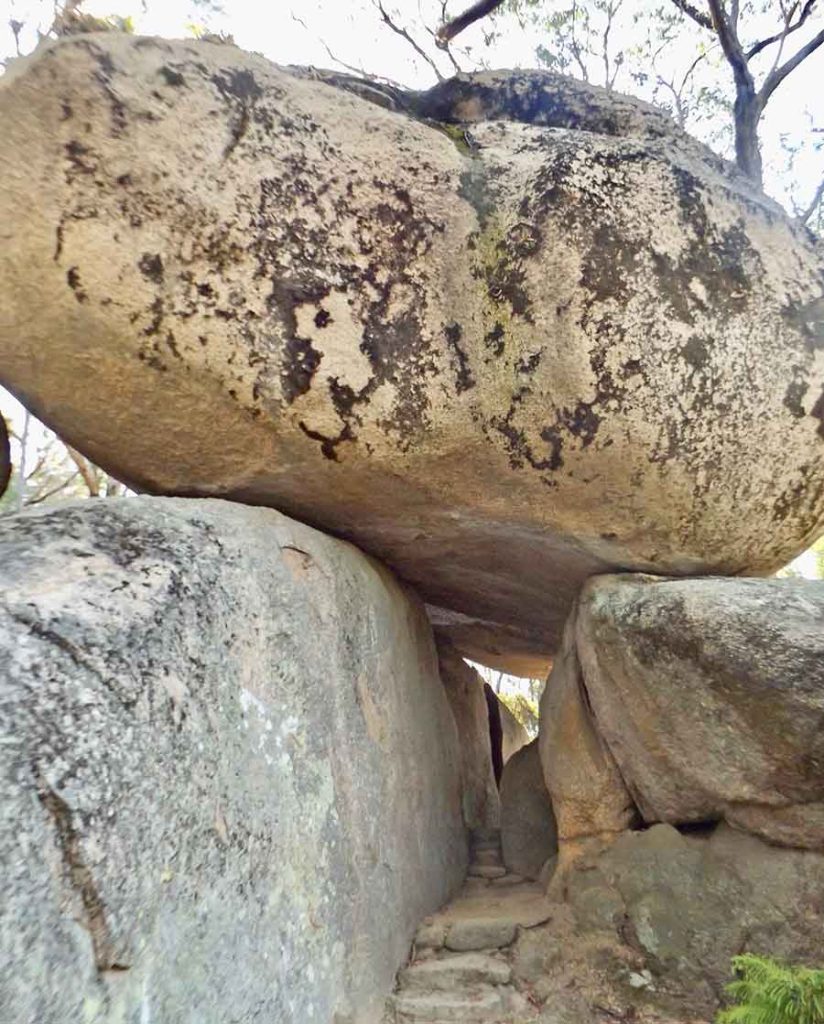
Of course the track eventually had to encounter these Granite Titans, tossed like marbles to balance at the foot of Bald Rock itself.
I not only fear and avoid heights, but caves and looming overhead rocks, and yet the track leads you through many tight spaces like this.
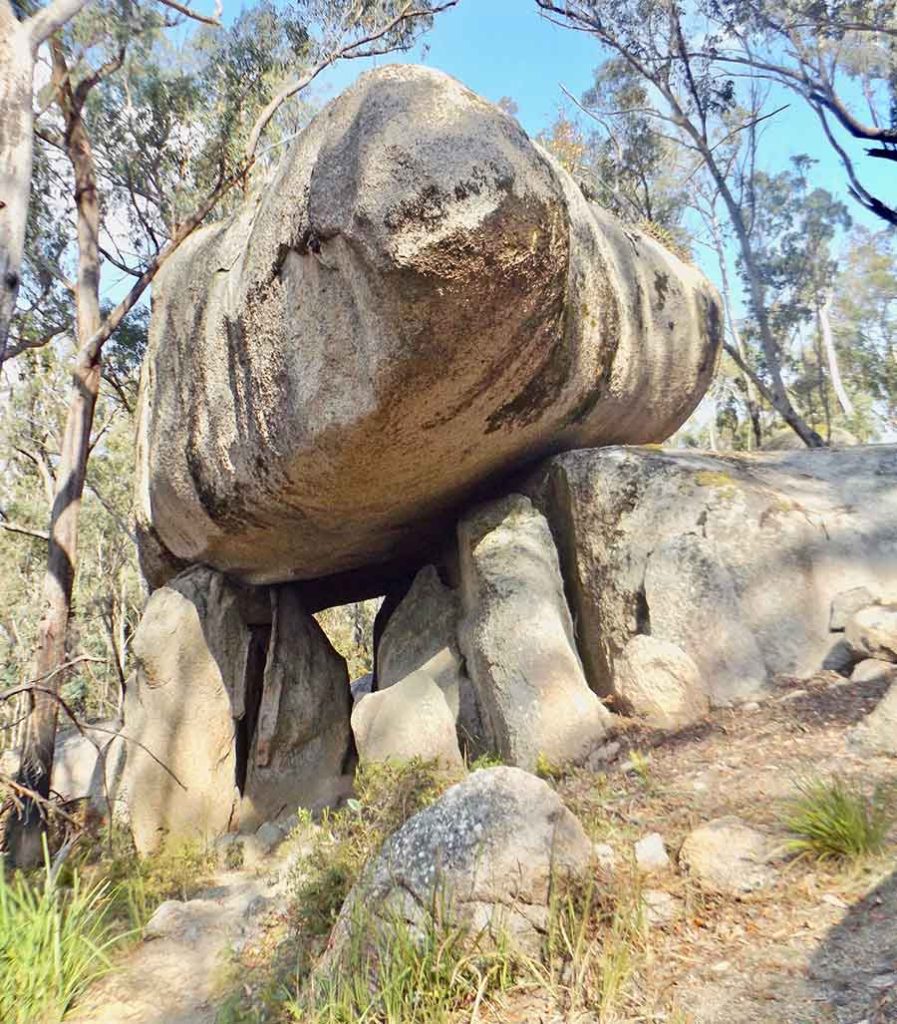
I know they have poised like these for eons, but still I duck and scurry through, hoping they do not choose to move at last… not right now.
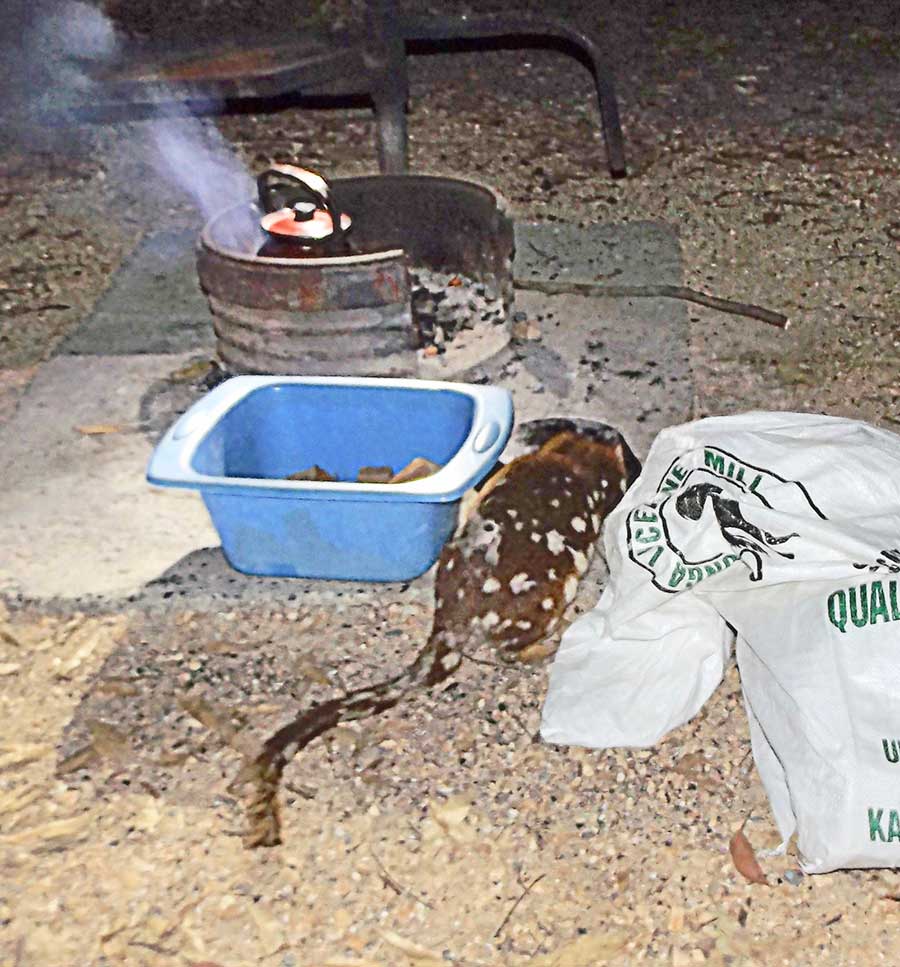
I found Bald Rock National Park one of the most interesting for me. The campground was good, apart from the sad sight of a very ill quoll, probably blind and perhaps dying, (once rescued, likely from a dog attack, and released here) who came nosing around.
Survival at Girraween
Girraween National Park, just over the border into Queensland, is all about rocks, large and small, in domes and sheets. From the camping area, the Pyramid looms large and challenging.
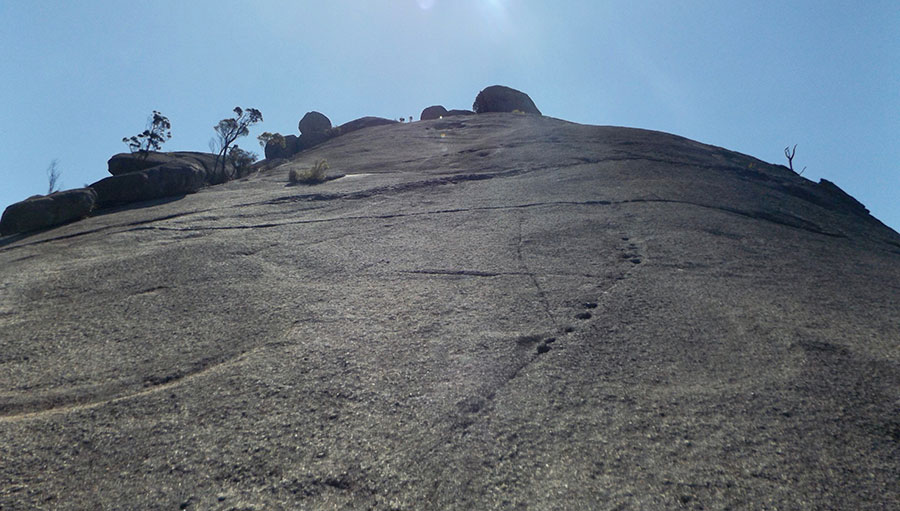
Nobody will be surprised that I did not make it to the top; instead I got to a point where I felt I could see enough of a view and the clamber ahead felt too scary for me. I’d have had to crawl…
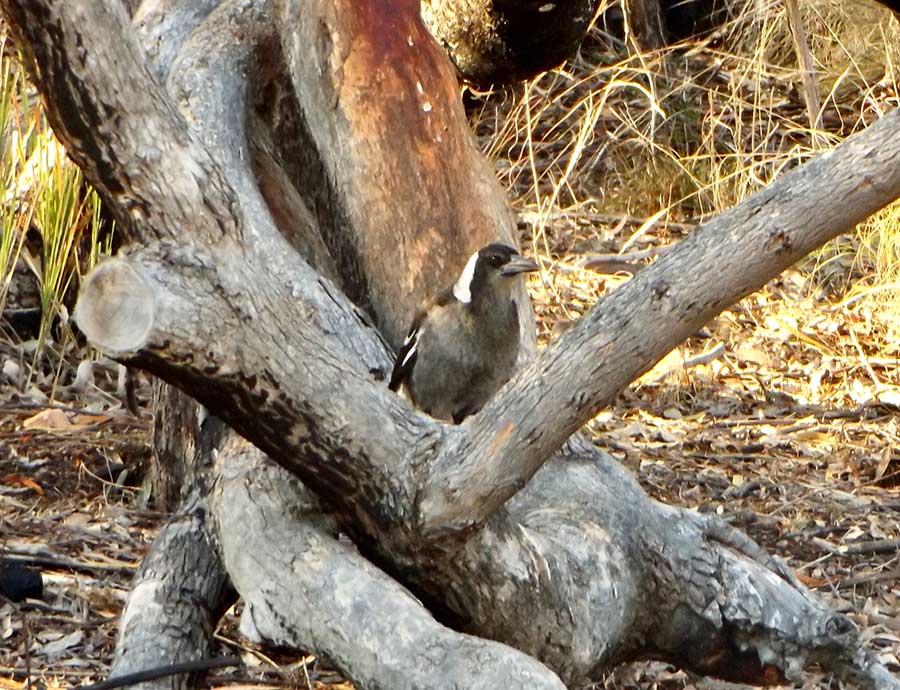
Each morning this young magpie would wake me with its full throttle joyous carolling. Eastern Grey kangaroos grazed heedlessly all around the campgrounds, but I considered them almost domesticated. In general, I found that there were too many people and not enough wildlife. Maybe flush toilets should be my indication…
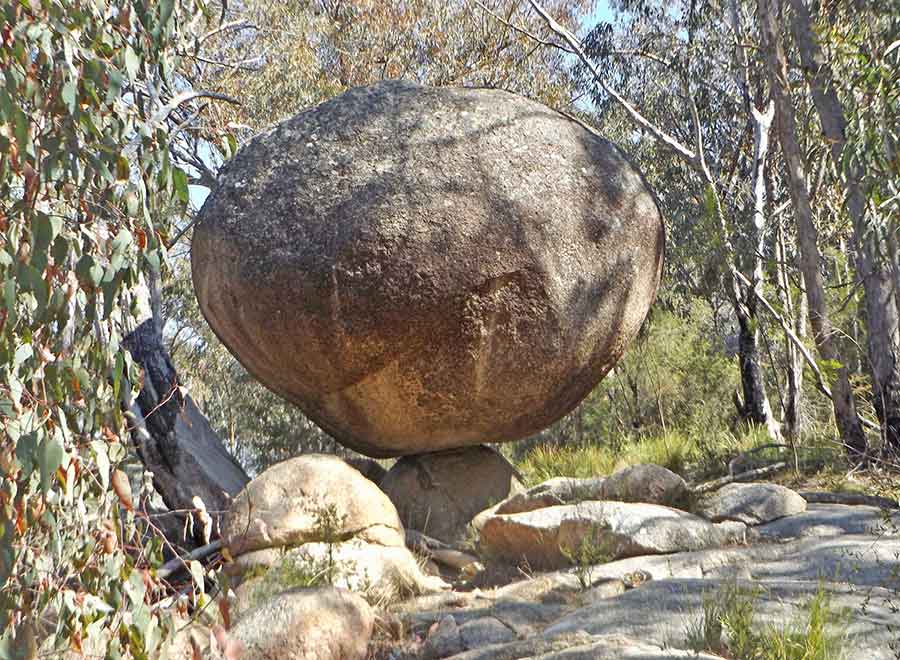
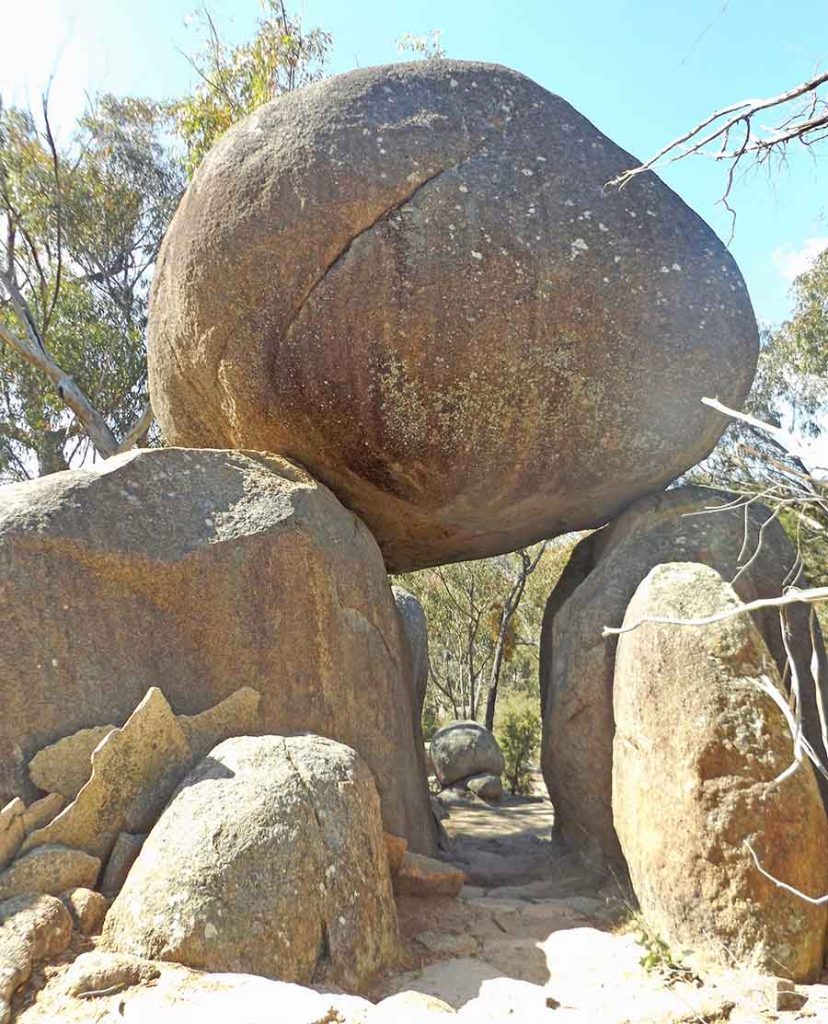
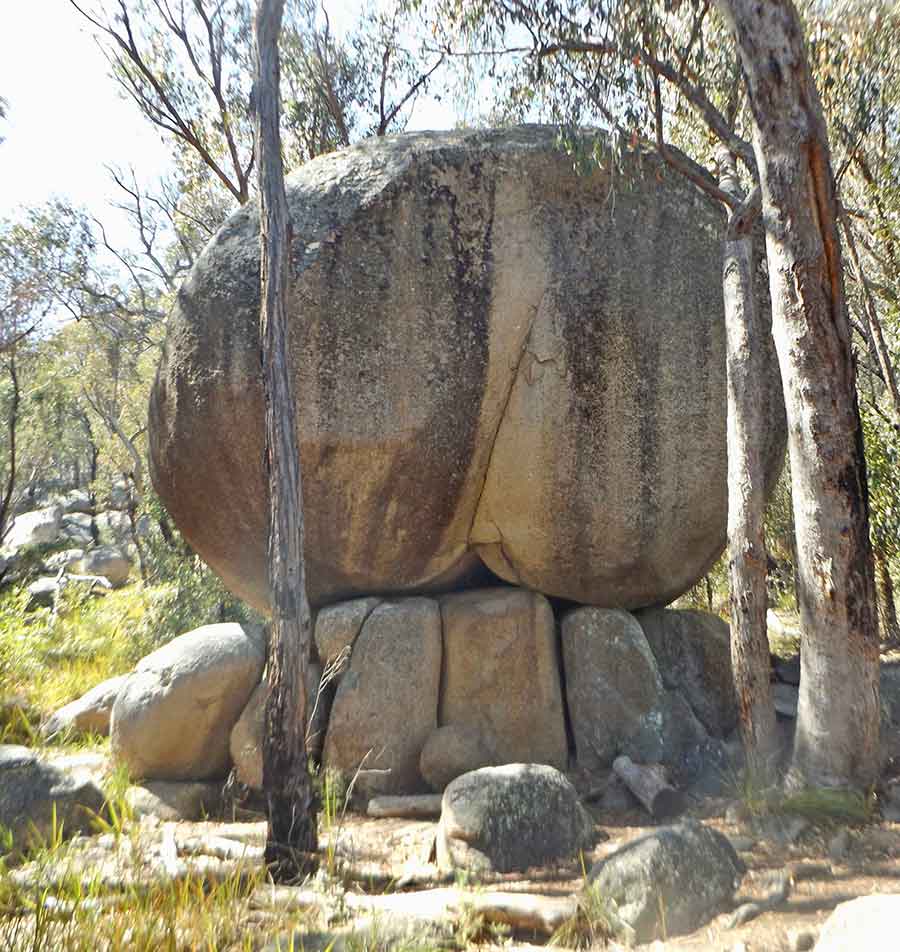
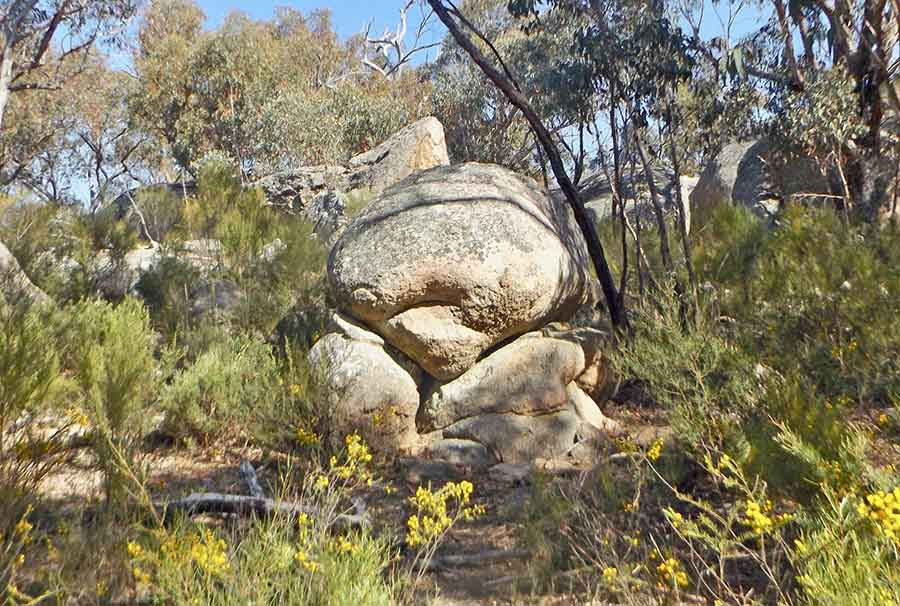
Yes, there were incredibly huge boulders balanced in preposterous positions, and many evocatively shaped and fissured rocks.
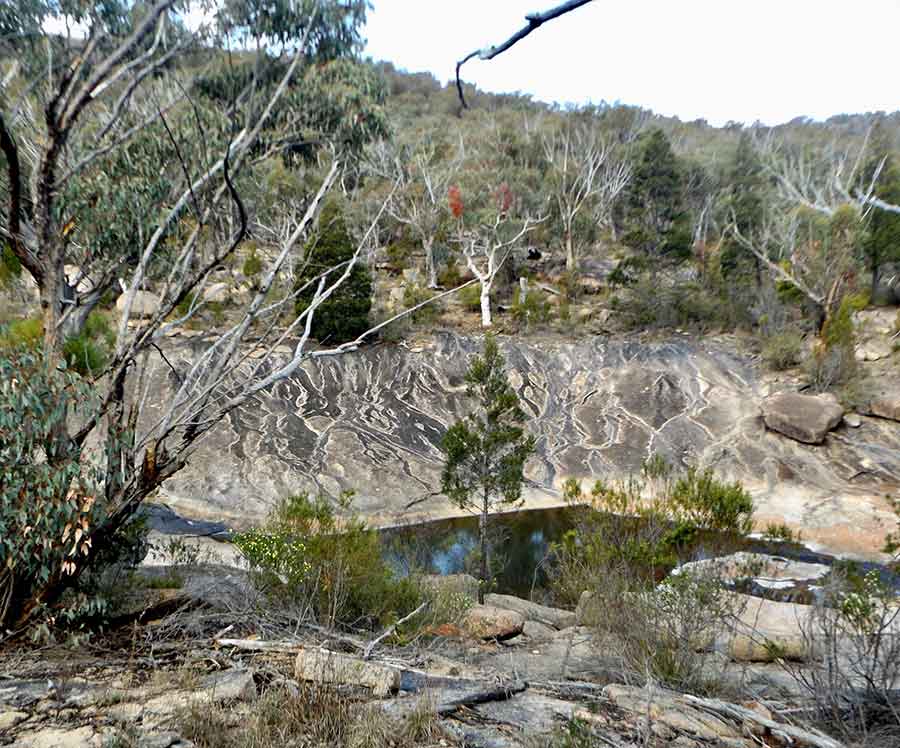
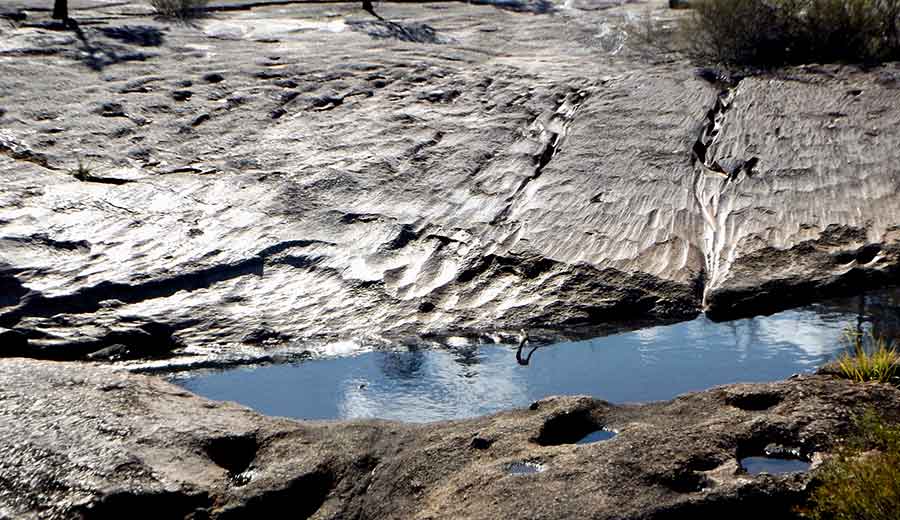
I was more taken with the many effects water has had on the rocks, in waved patterns as it had run over sheets of rock or down the sculpted sides of the creeks.
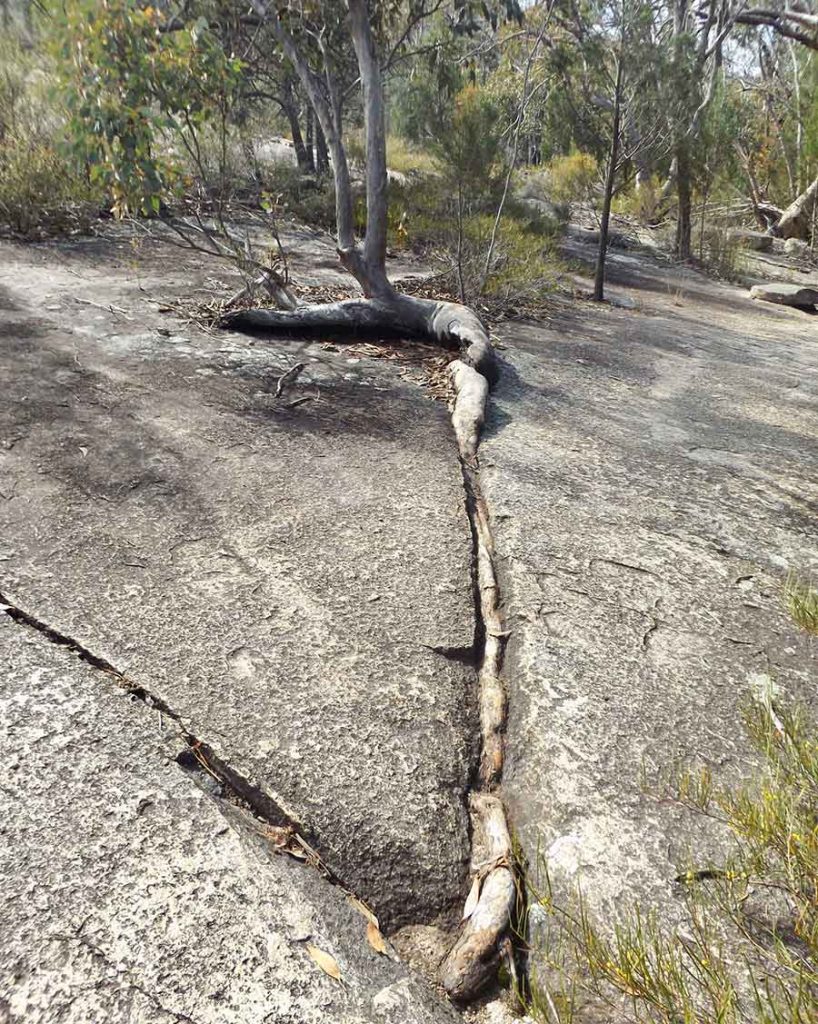
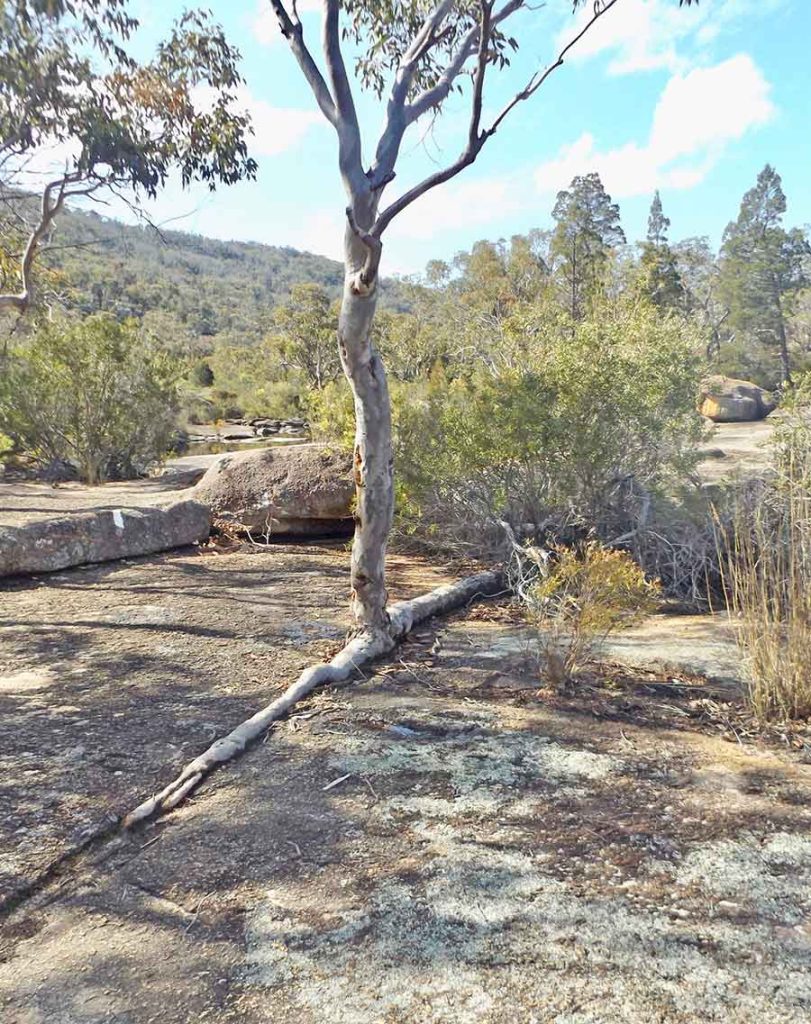
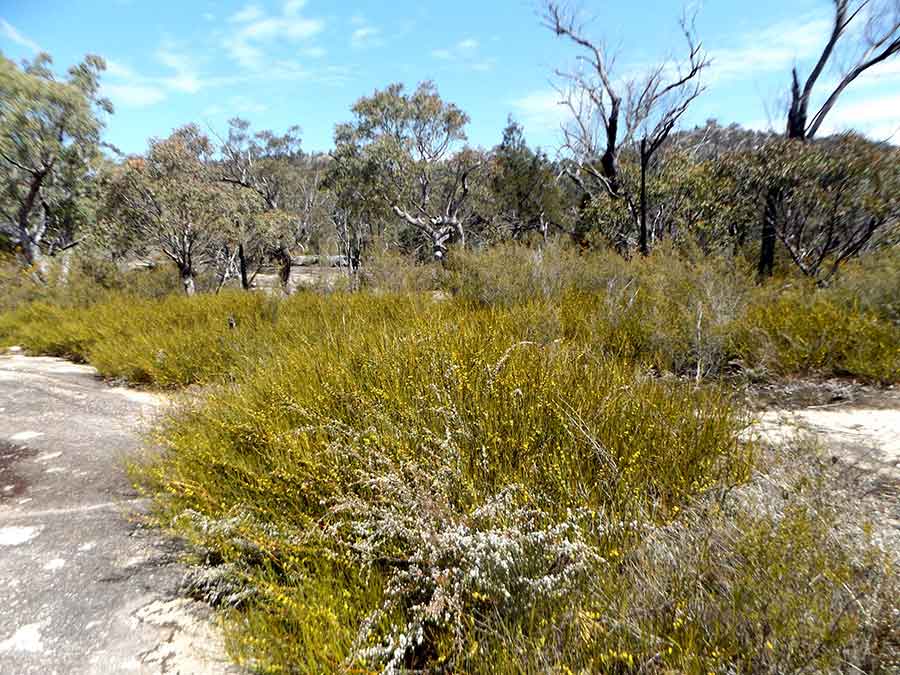
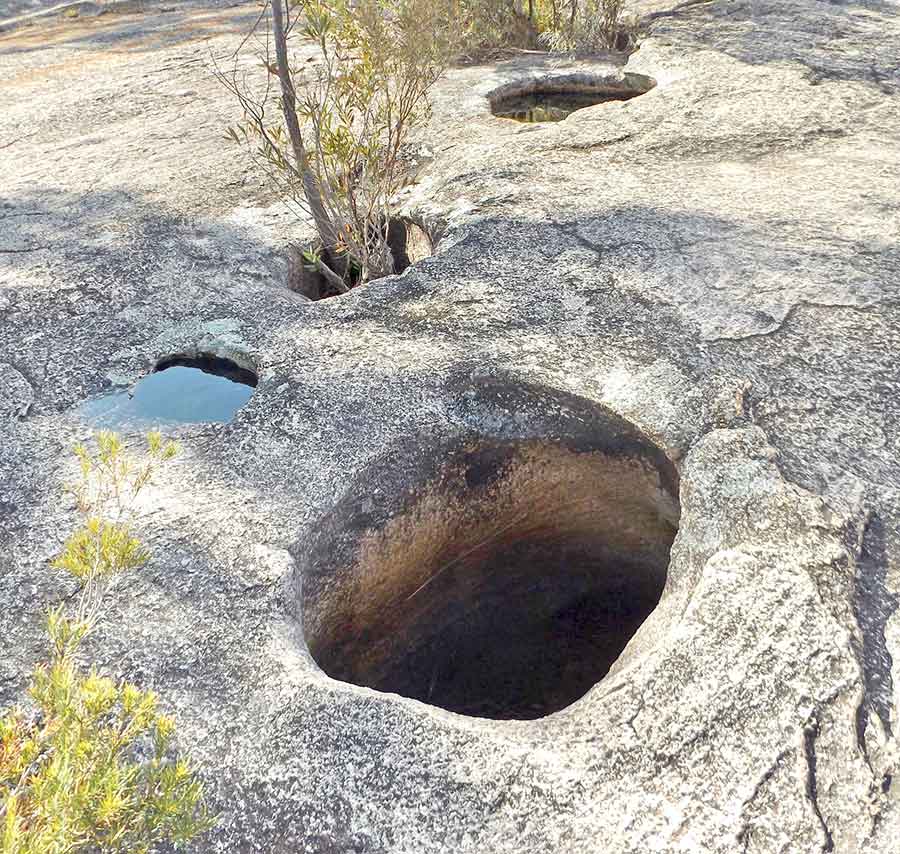
Trees and shrubs here seem to grow as best they can, taking advantage of any crack where soil or water might accumulate, their roots snaking along until they find easier purchase. One was doing the splits to achieve this.
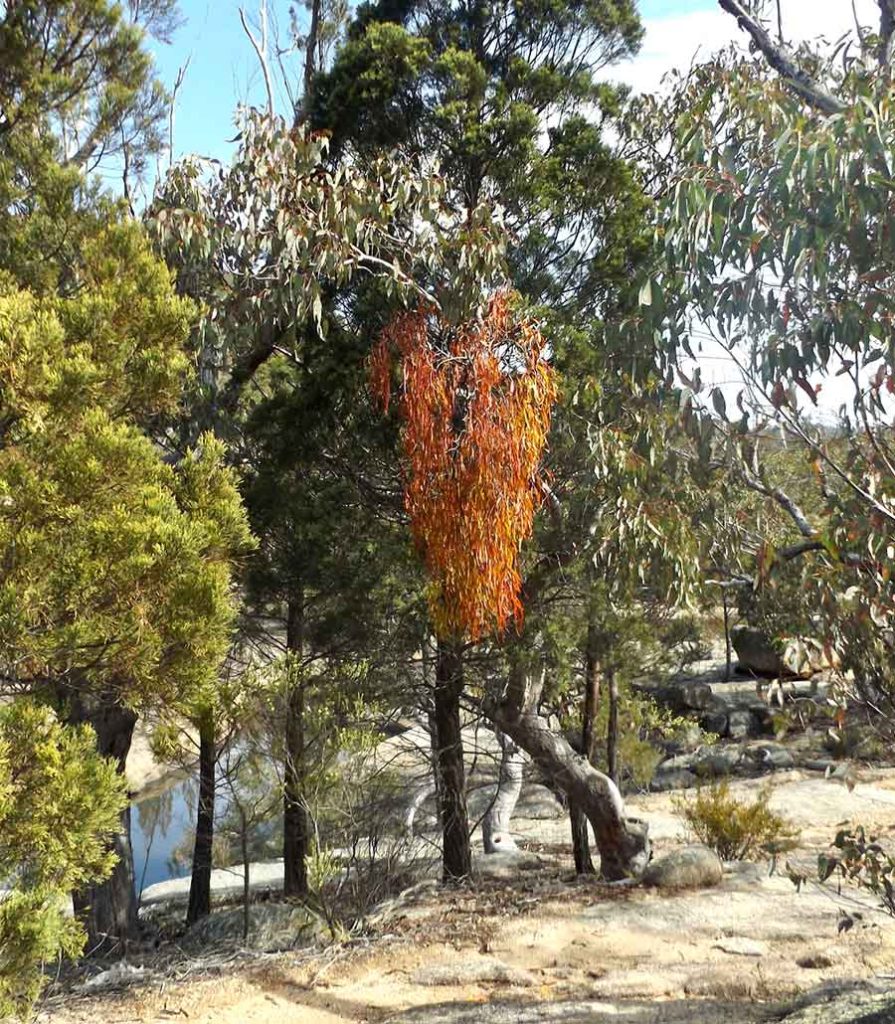
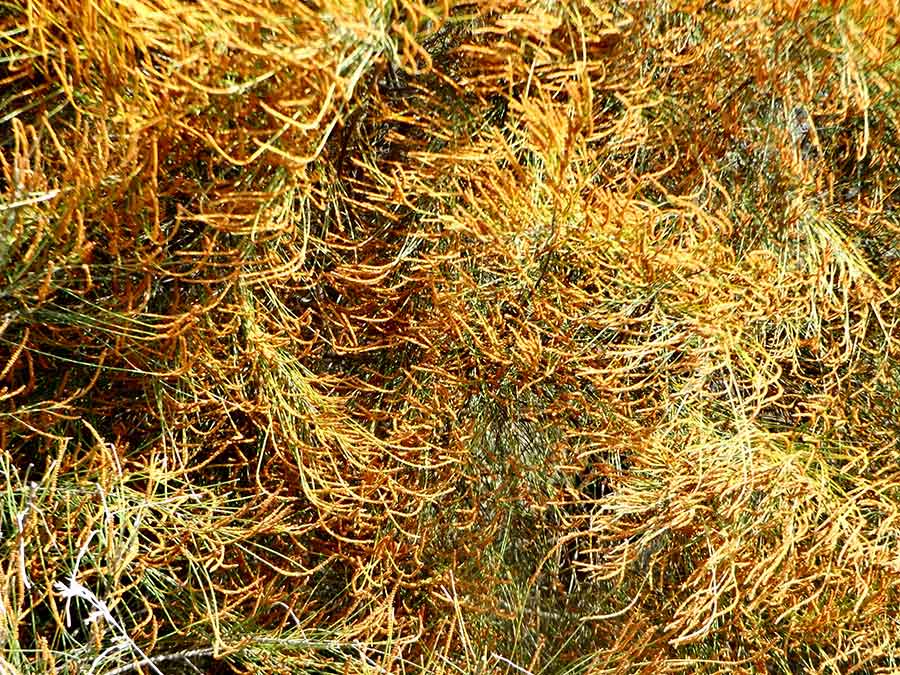
I certainly fulfilled my need for grey-green, but also was drawn to the strange bright orange and red shades of the many hanging bunches of mistletoe and the honey-gold flowers on the low growing casuarinas.
Wattles were blooming everywhere and some wildflowers were out, but this time my attention was elsewhere.
At Bald Rock National Park, my next stay, everything competed for attention, as you will see…!
Coastal cornucopia
This Camden Haven area keeps on surprising me with fresh natural visual treats. Like this early morning view across the river as the sun began to streak light across Dooragan. The outgoing tide impacts on the riverside ‘beach’ drew me closer.
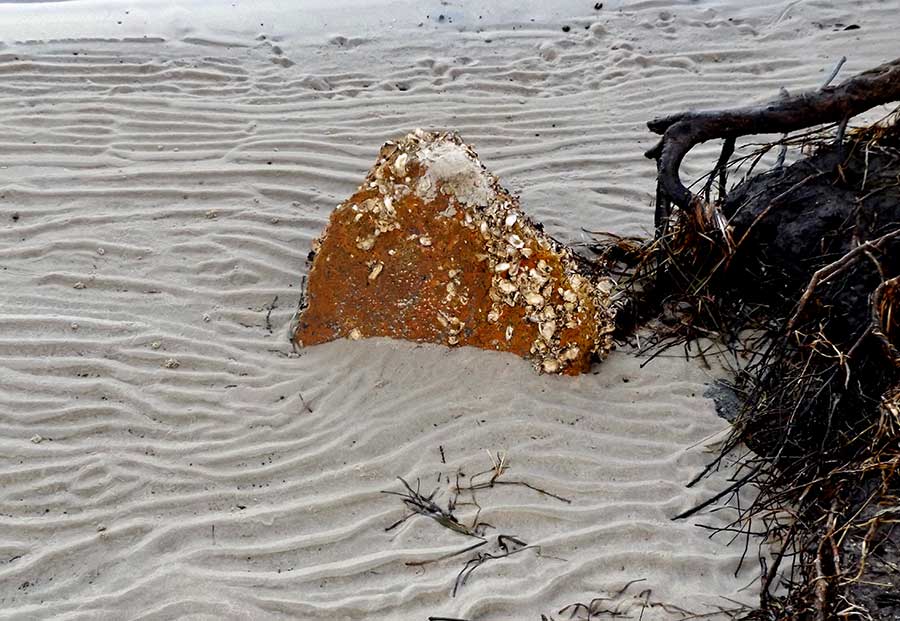
It was as perfectly rippled as a raked Japanese garden.
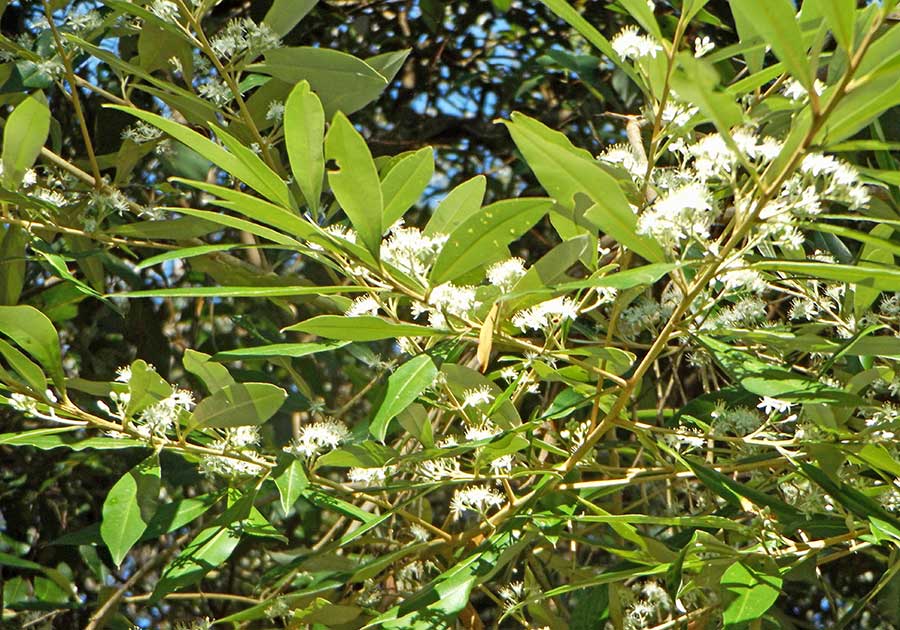
In Kattang Nature Reserve, these small trees were covered in starry blossoms.
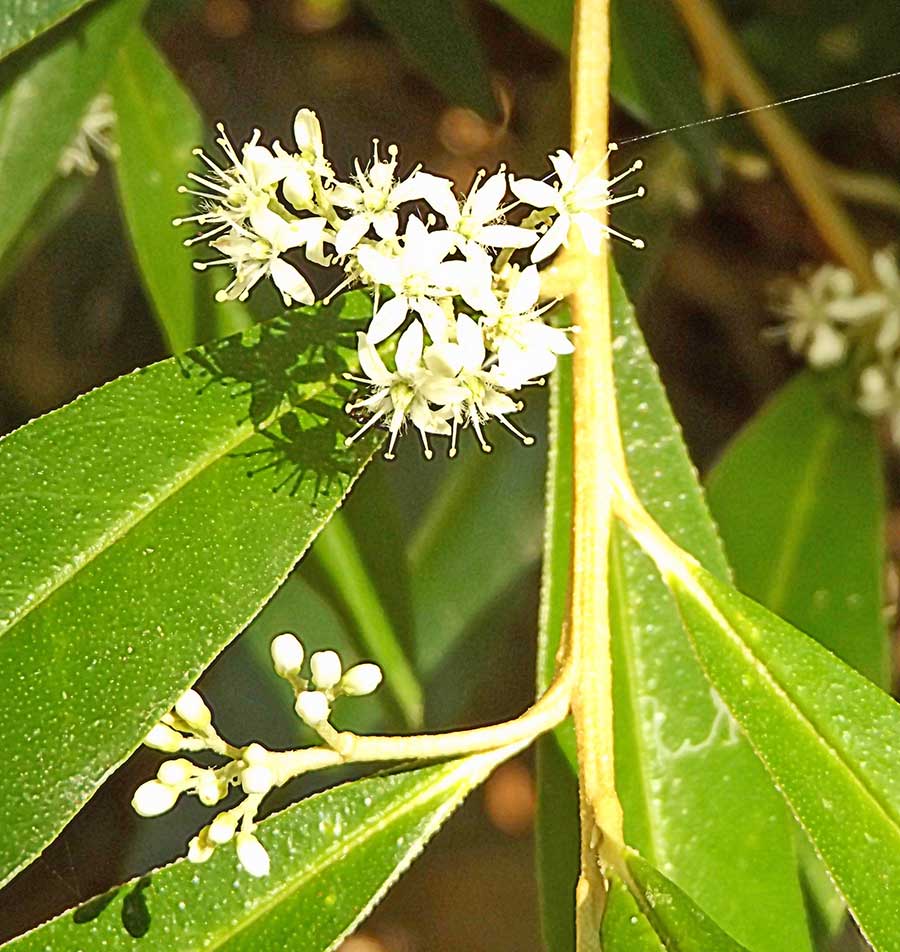
It is Nematolepis squamea, I am told (ex-Phebalium). Such a dainty and graceful blossom to gather in clusters like this.
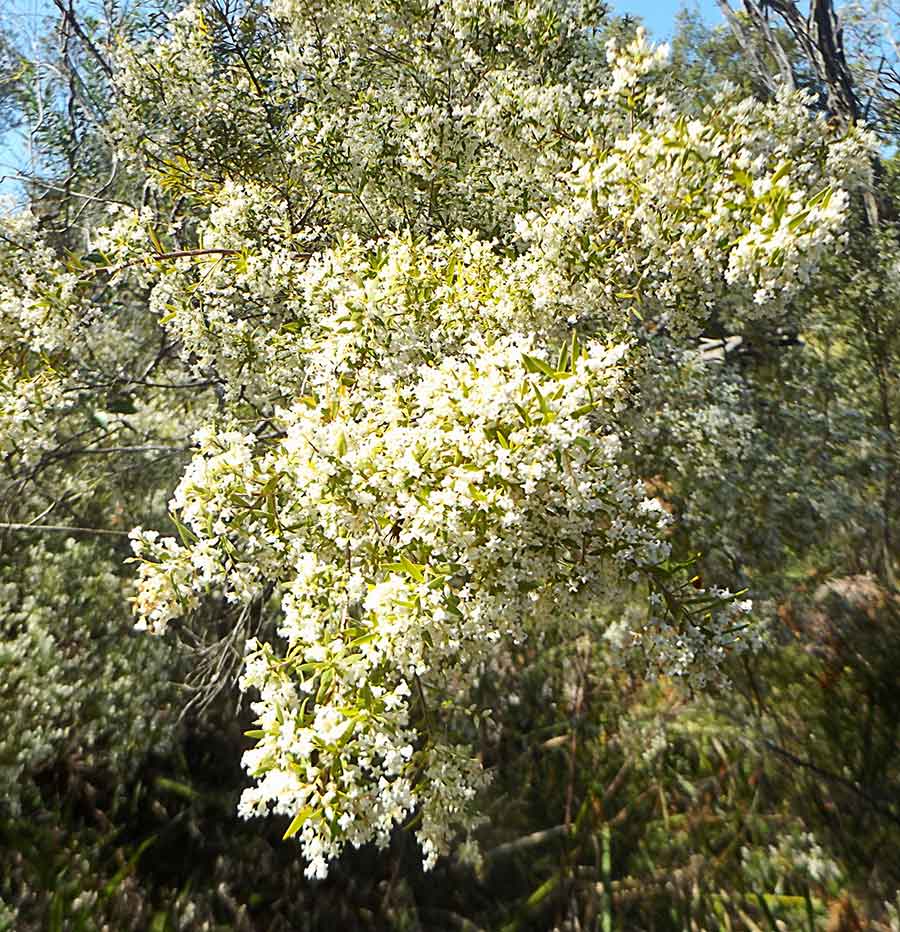
On a different, low and sandy coastal walk, there was an extraordinary variety of white-flowering shrubs.
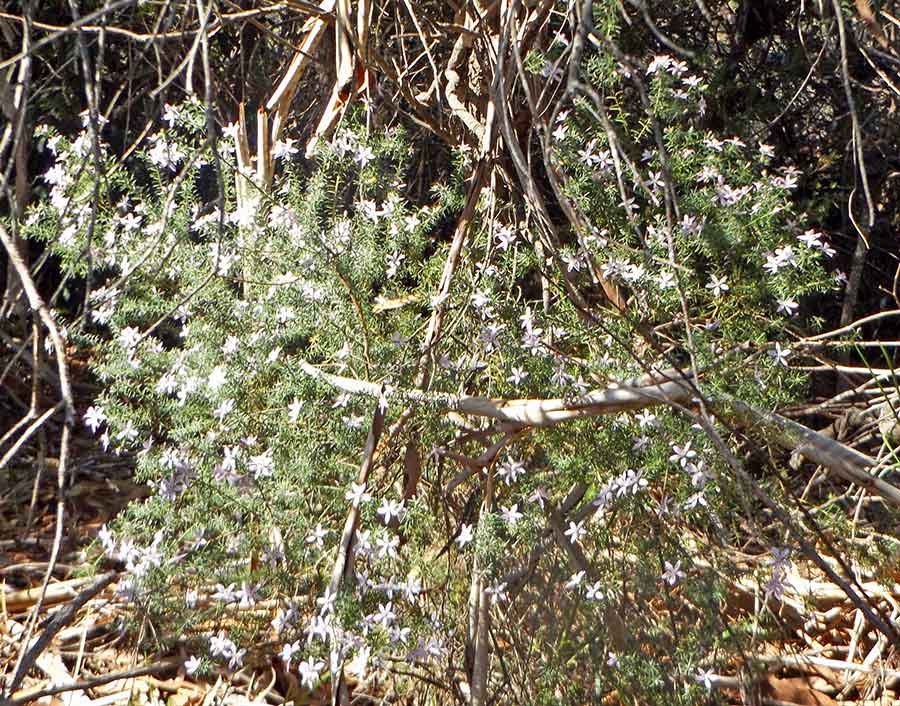
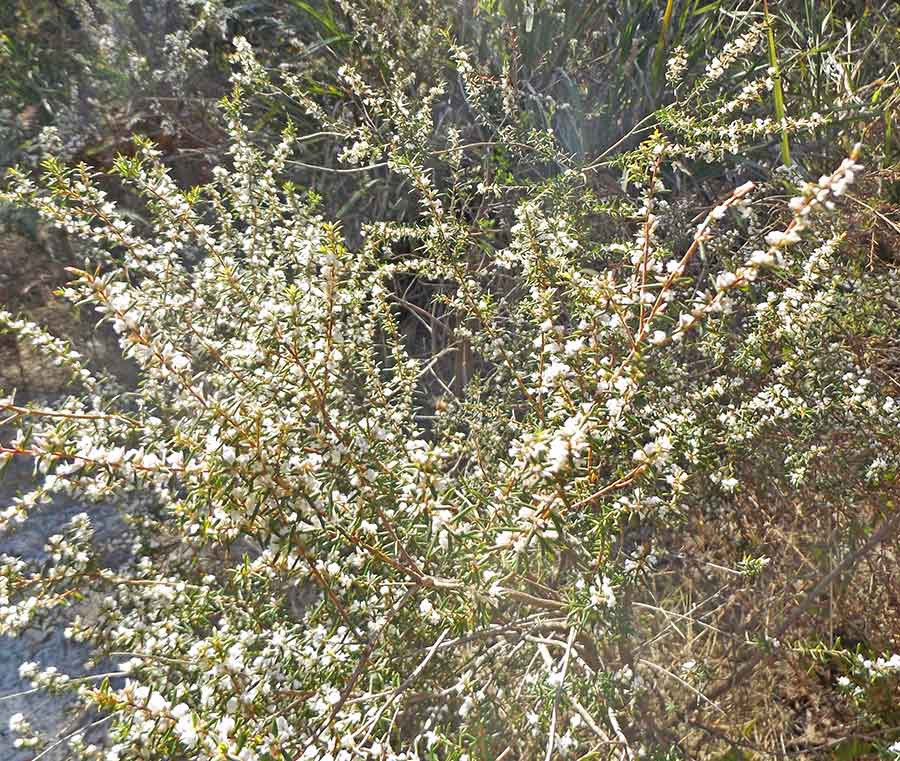
Too many for me to identify, but the many flannel flowers were in bud, so those will clearly dominate when they bloom.
I am off camping for a few weeks, to colder, higher, rockier inland national parks, so the next posts will depict very different aspects of nature. There will likely be longer gaps between posts as reception will be rare.
Stay tuned!
Dooragan
Most people go up to the Lookout on North Brother Mountain, in Dooragan National Park, for the views. The wealth held in its short rainforest walk is often missed — like these pencil orchids. I saw some on rocks and high up on trees.
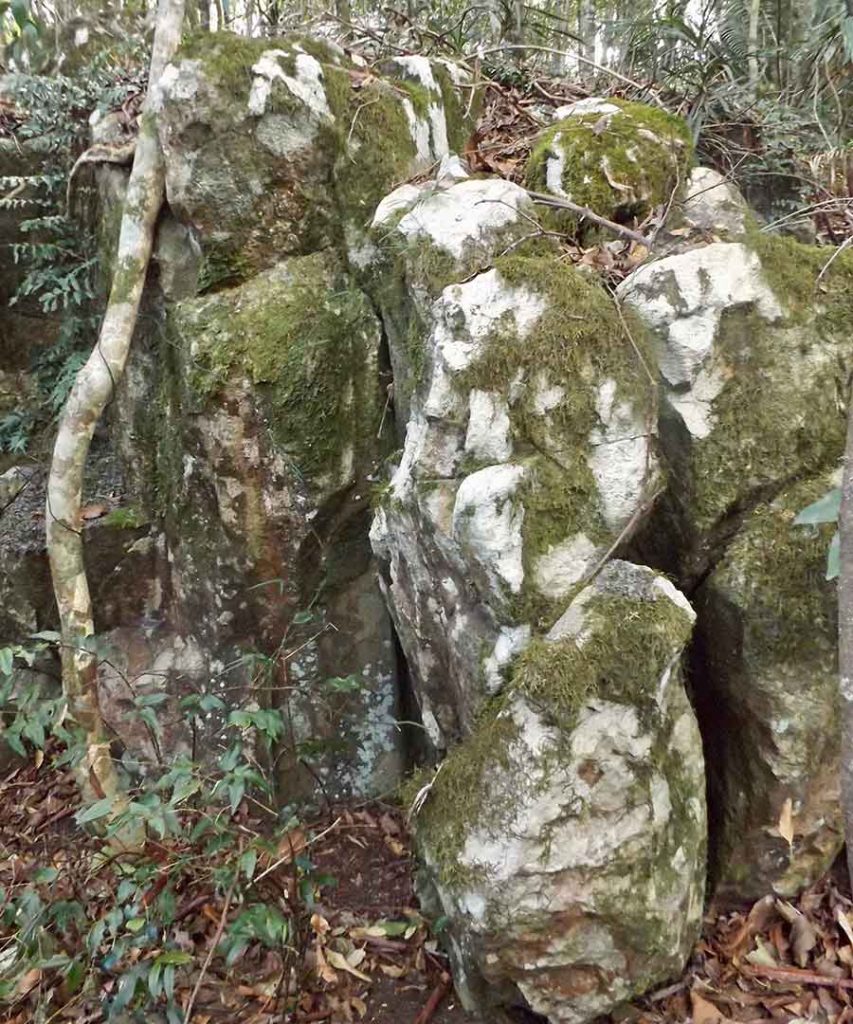
It has great rocks, mossed green and lichened white, caught in mid-tumble.
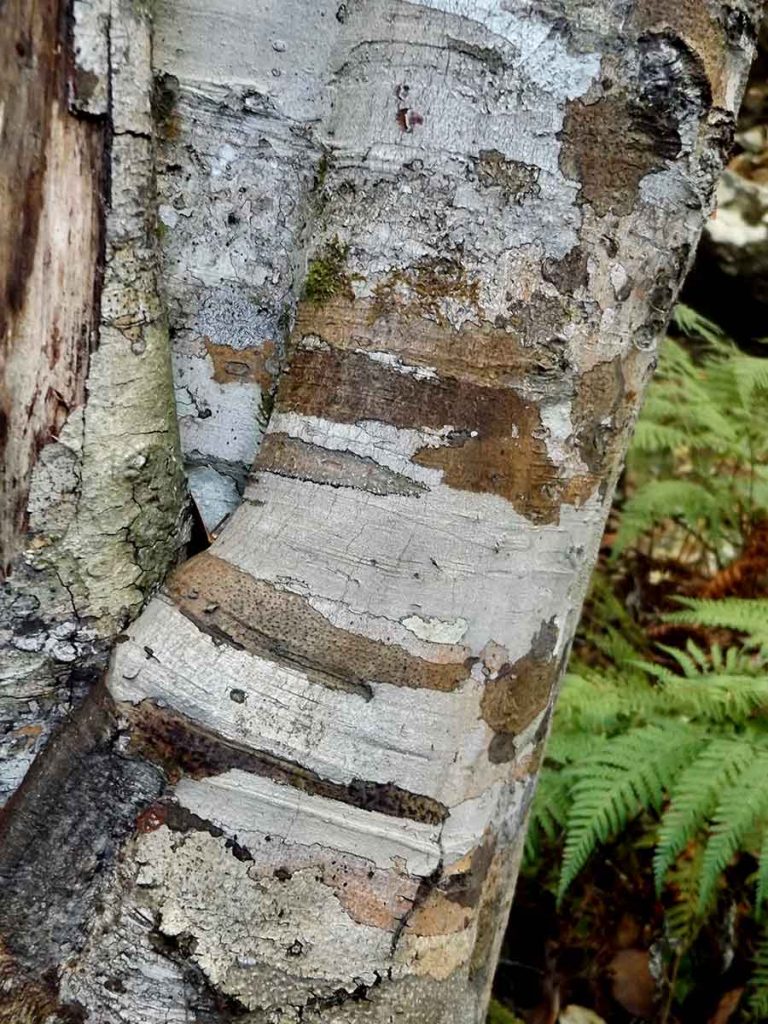
The lichens here could not decide to go with stripes or splotches, so did both.
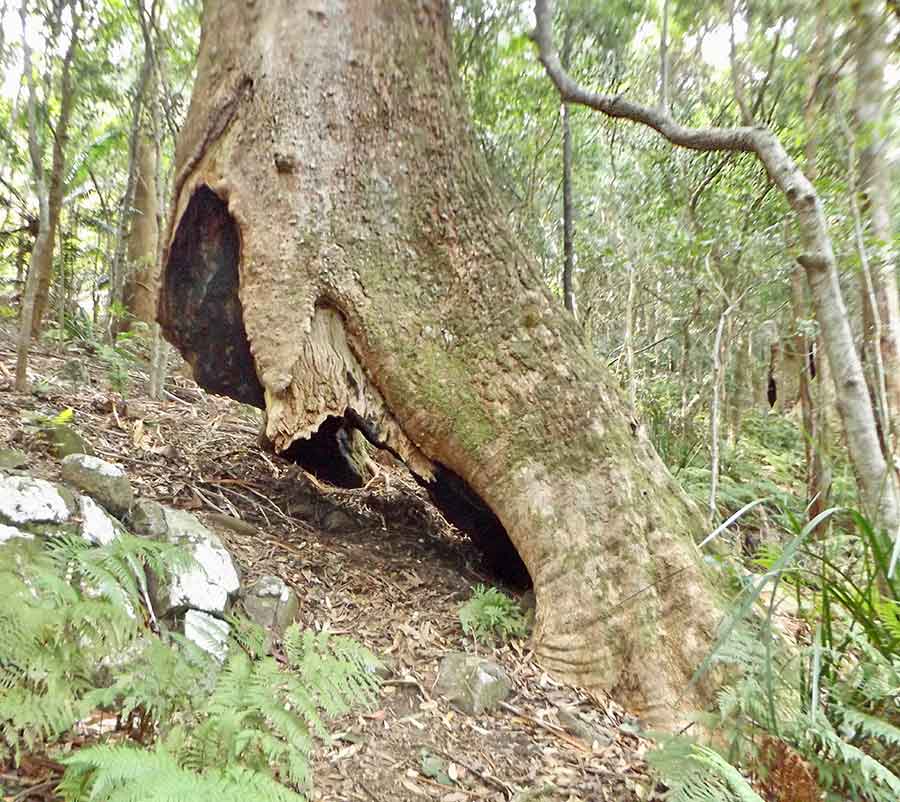
Long ago fires must have left this ancient tree with such a perilous hold on the slope… and on life, but alive it is.
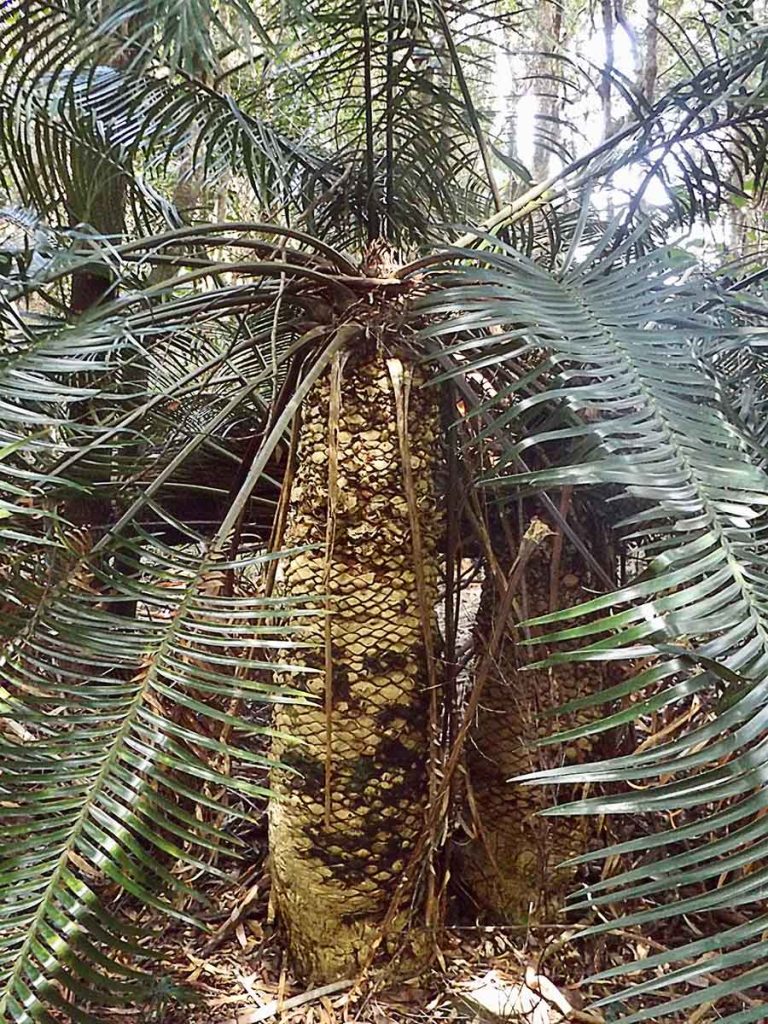
Most of the lower greenery in this forest was provided by vines, but these stubby cycads also collected moss in their geometrically patterned trunks. I am told it is Lepidozamia peroffskyana.
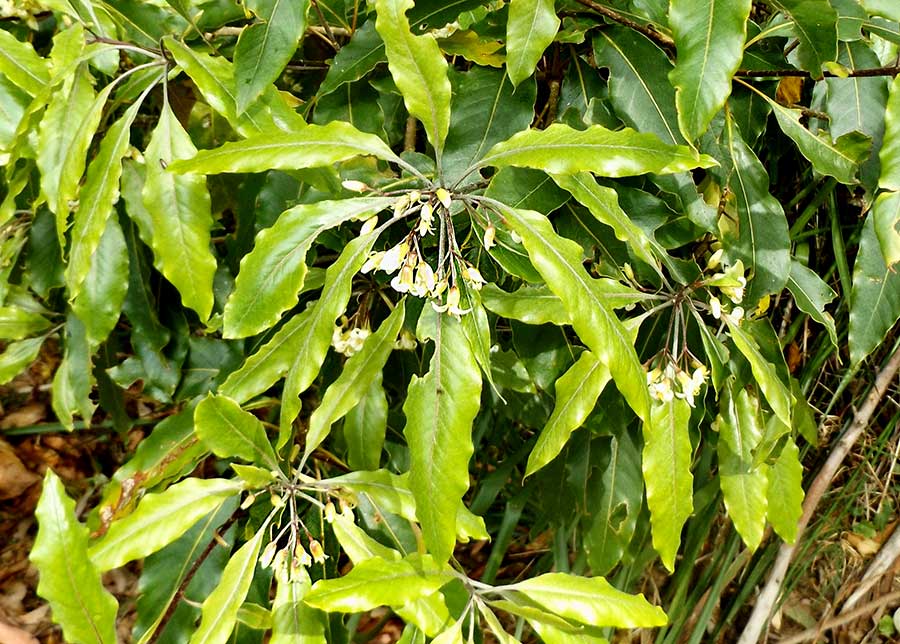
Walking back to the actual lookout, I was assailed by a strong perfume. Looking around, I realised there were many Sweet Pittosporum (undulatum) trees full of the tiny blossoms that gave out so much scent.
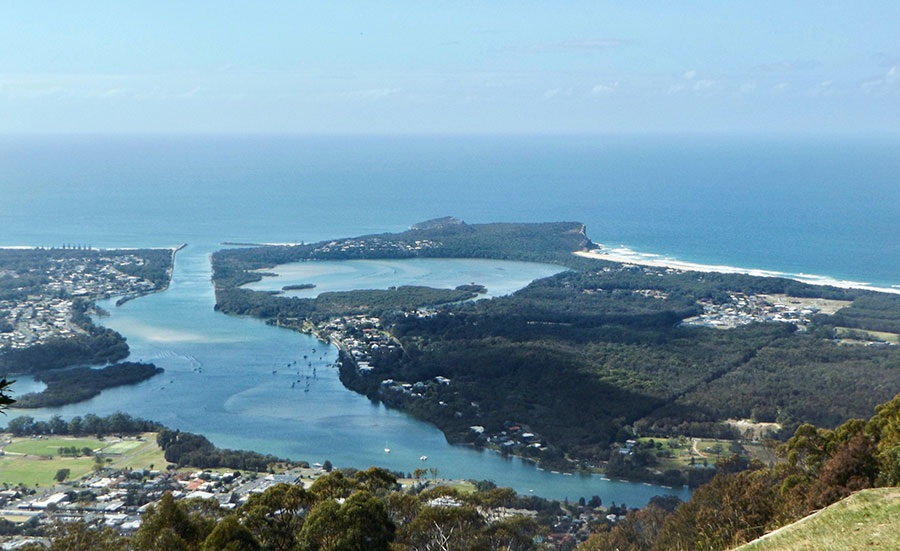
And yes, the view is wonderful. So many waterways! I can see Camden Head, where I often walk in the fabulous Kattang Reserve, It is the northern end of the long Dunbogan Beach, where I also often walk — when I can bear the 4WD tracks.
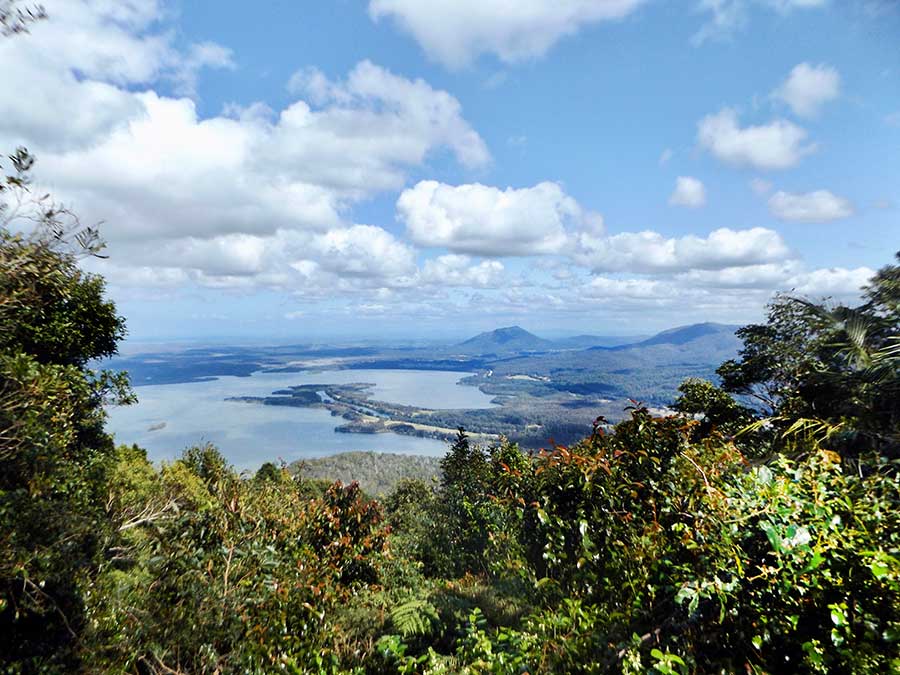
From another lookout, I can see South Brother and Watson Taylor Lane and Crowdy Head. What an area to live in; it has it all…
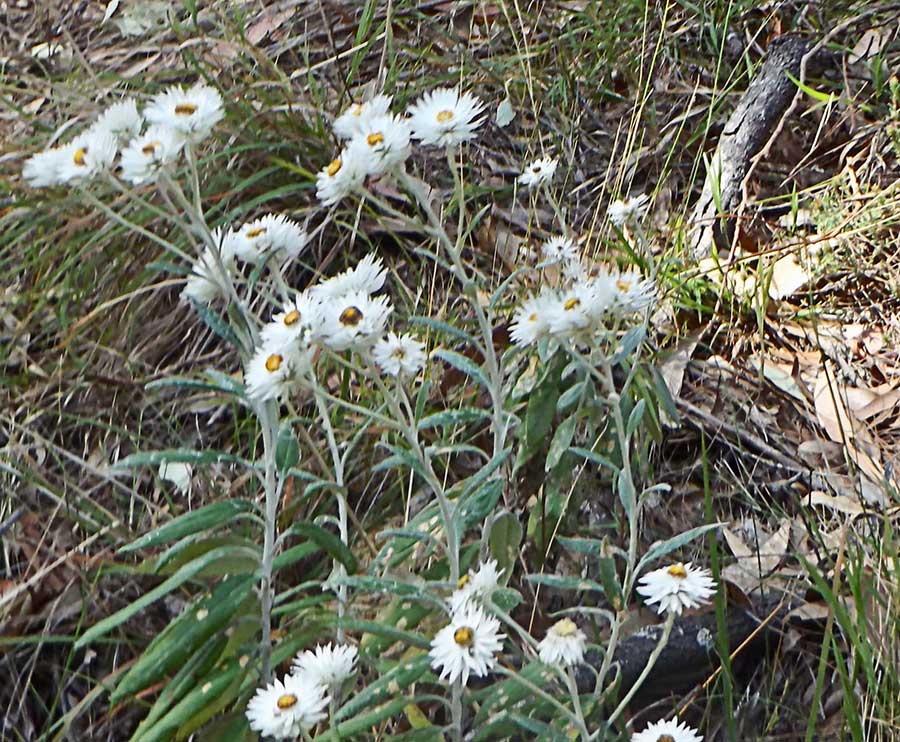
On the steep winding road down, what I at first mistook for early flannel flowers prove to be masses of what I call Everlasting Daisies, identified for me as Cononidium elatum, thriving on the drier slopes.
Reassessing home
With distant snow-capped Alps in my mind’s memory, I have just revisited a few of my most often visited local nature spots.
I found no Alps, but mythical cloud mountains over a pewter sea. The ephemeral will have to do.

Sun-splashed, that sea butts as restlessly as ever against the rugged cliffs that guard the Camden Haven.
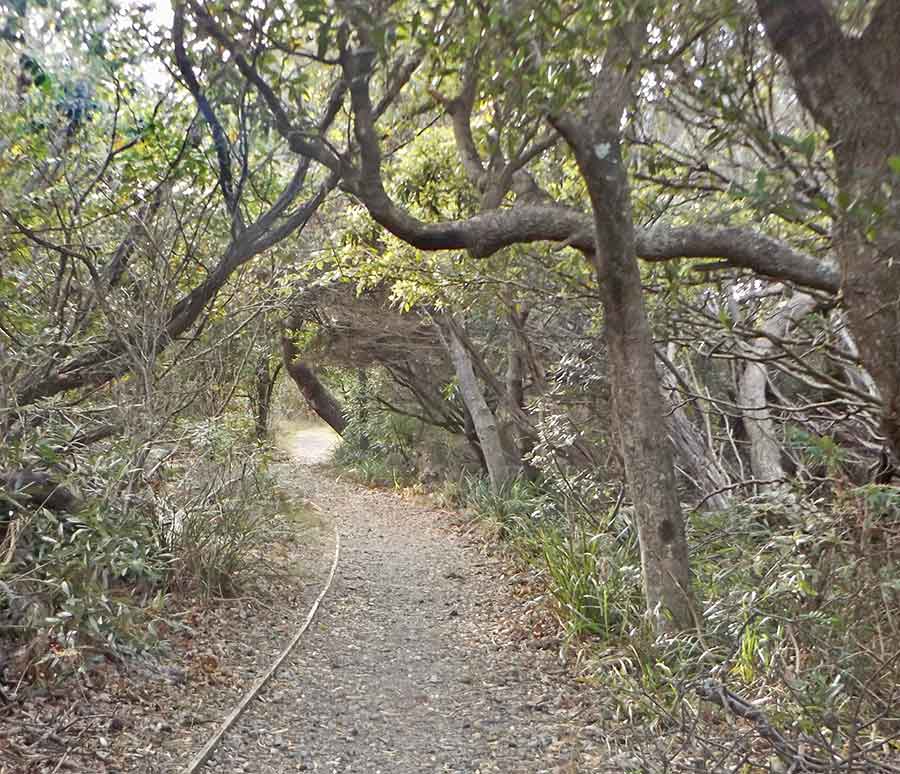
The bush above the cliffs is equally buffeted by the sea winds, so grow low, and bend to survive. It is nothing like the bright verdant forests of Northern Italy, but I have been thirsting for this greyish-brownish-green, quite ‘verde’ enough for me. After all, as Kermit almost said, ‘it’s not simple being green’.
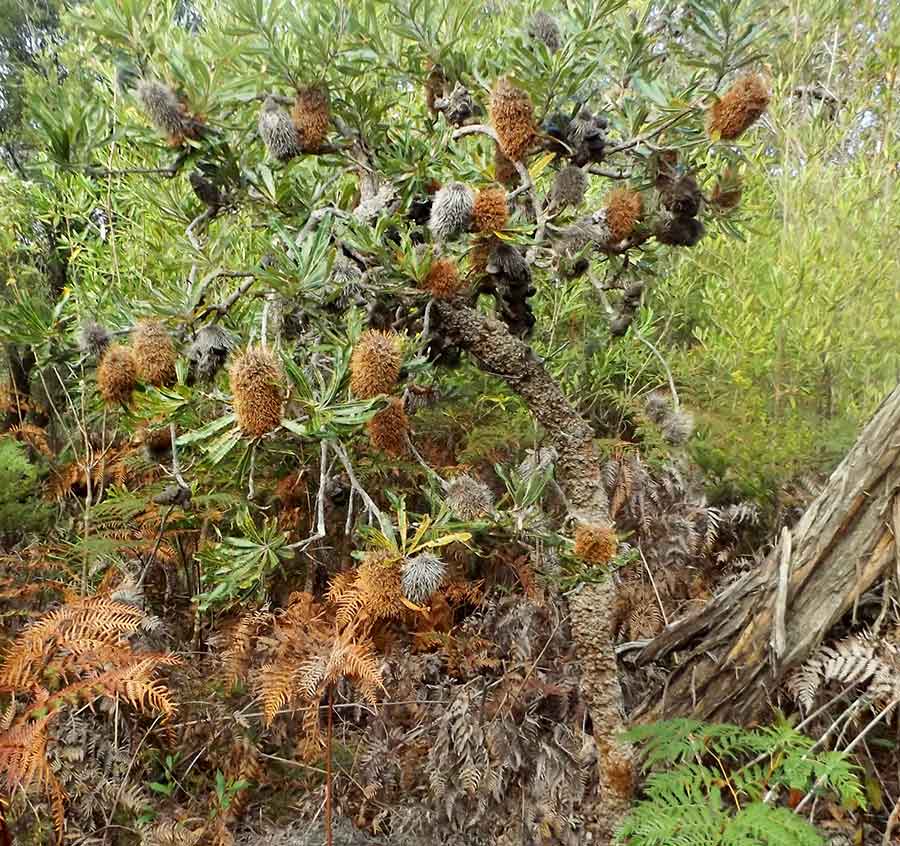
I marvel anew at the uniquely grotesque beauty and bounty of the banksia trees.
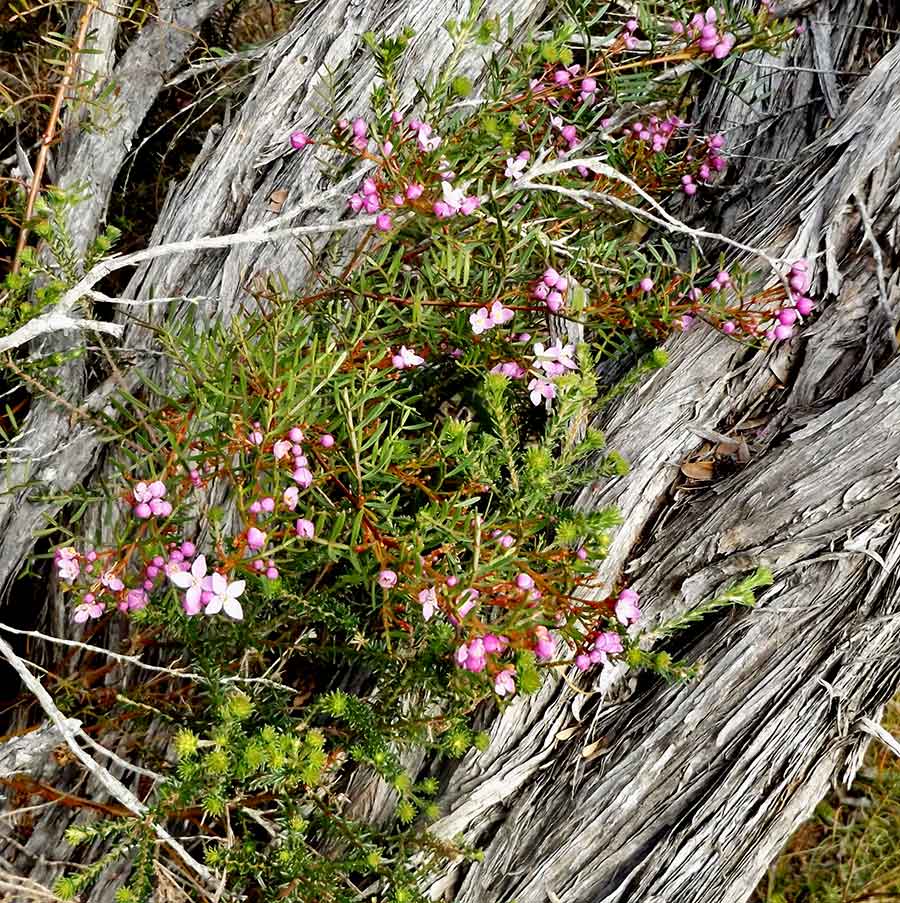
Being almost Spring, there are many small patches of colour already amongst the greys of the fallen trees. Flowers like the pink Boronia, many yellows, whites like the perfumed Pittosporum, the bright lime winged seed cases of Dodonea, or the striking berries of the Blueberry Ash.
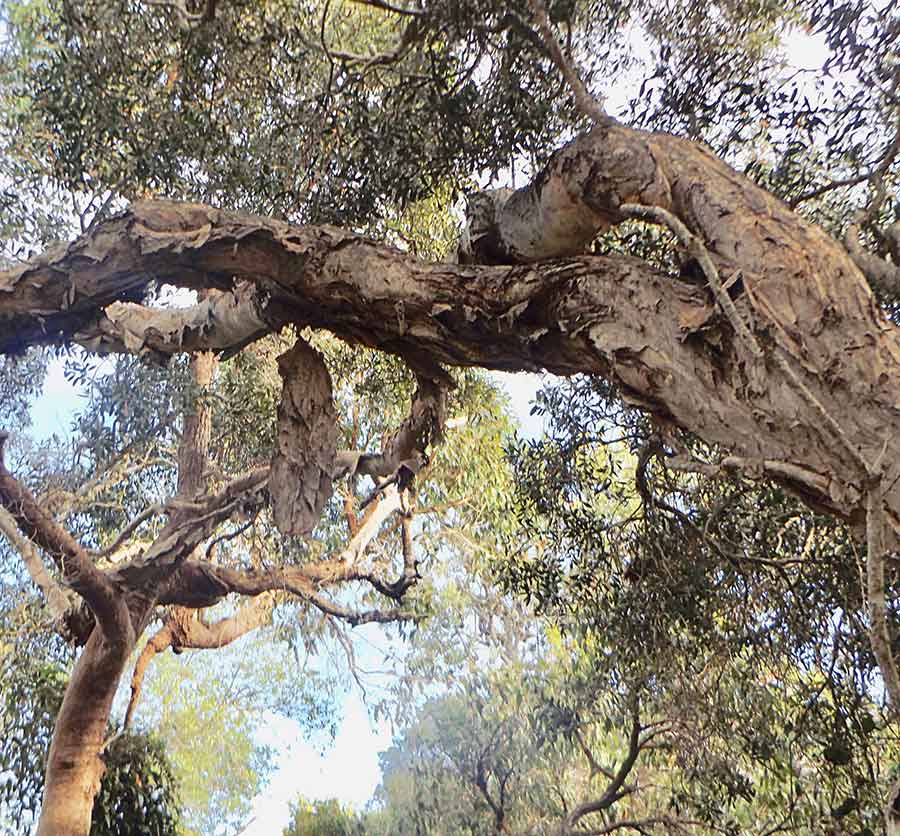
In one dry but sheltered swamp this big paperbark tree had a large section of bark hanging by a thread, spinning in the breeze like a top, or a banner saying, ‘Look at me’!
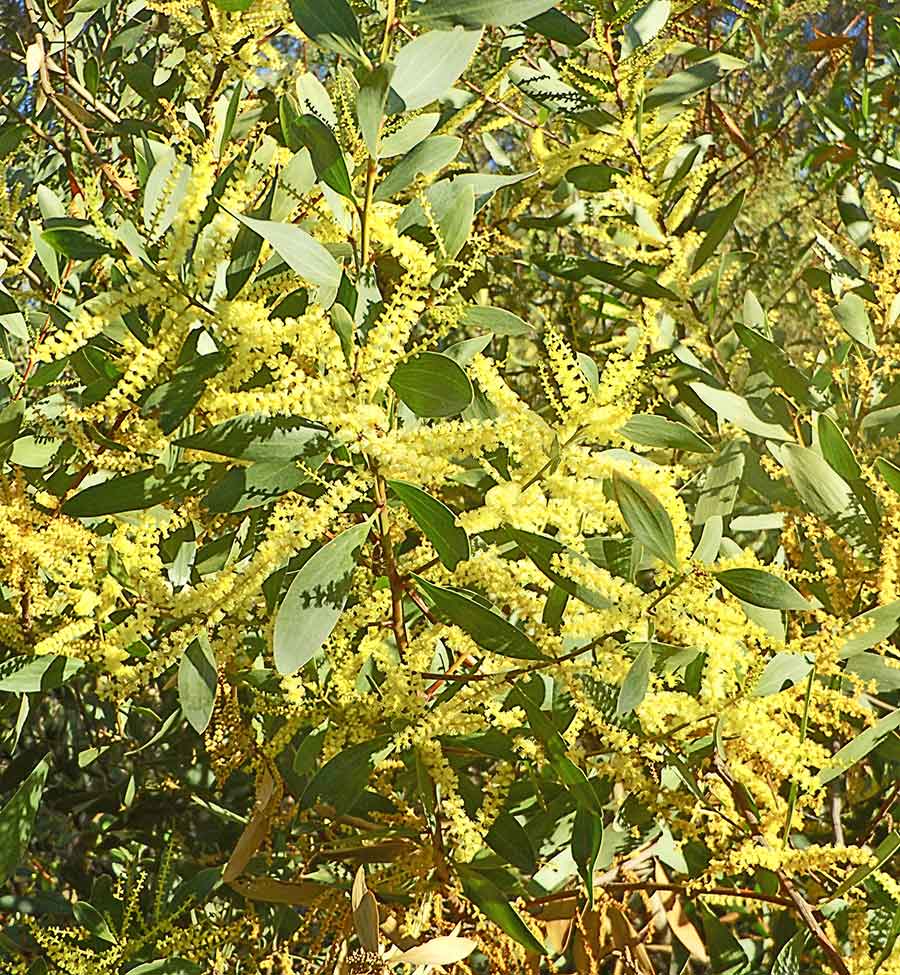
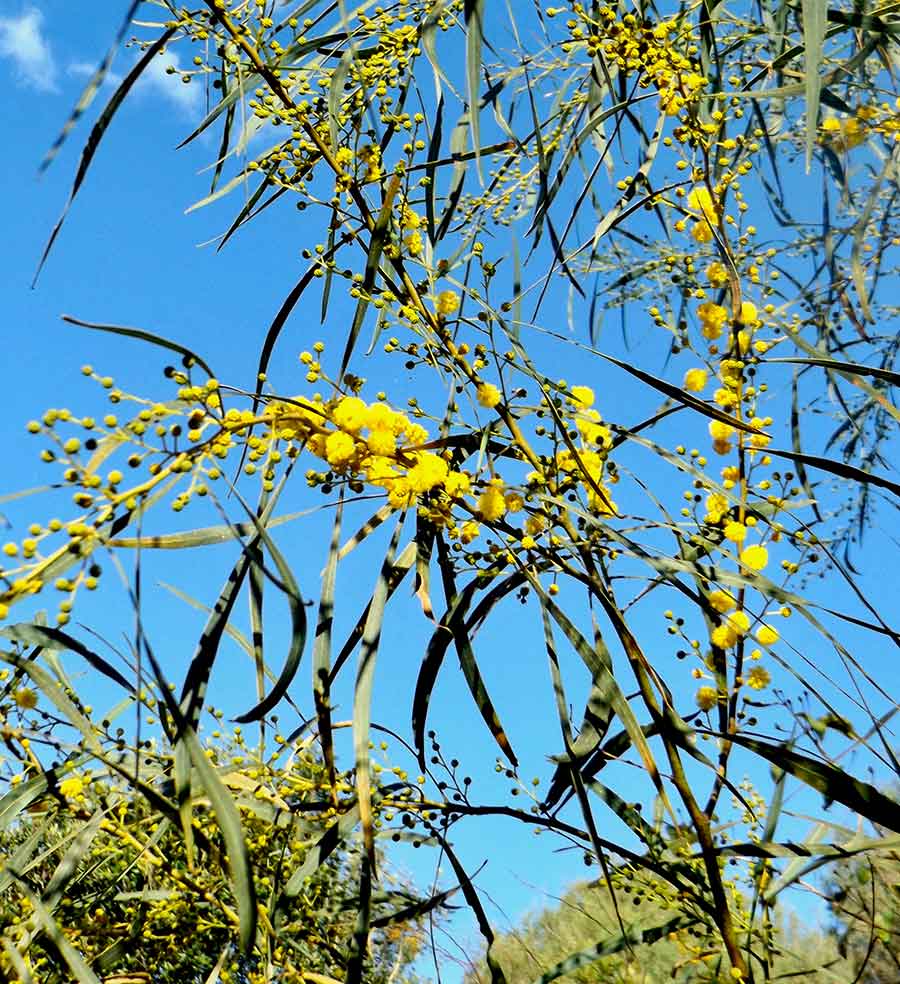
Of course there were wattles to greet me, as there were on my other favourite walk, to the beach near me, where two sorts thrive.
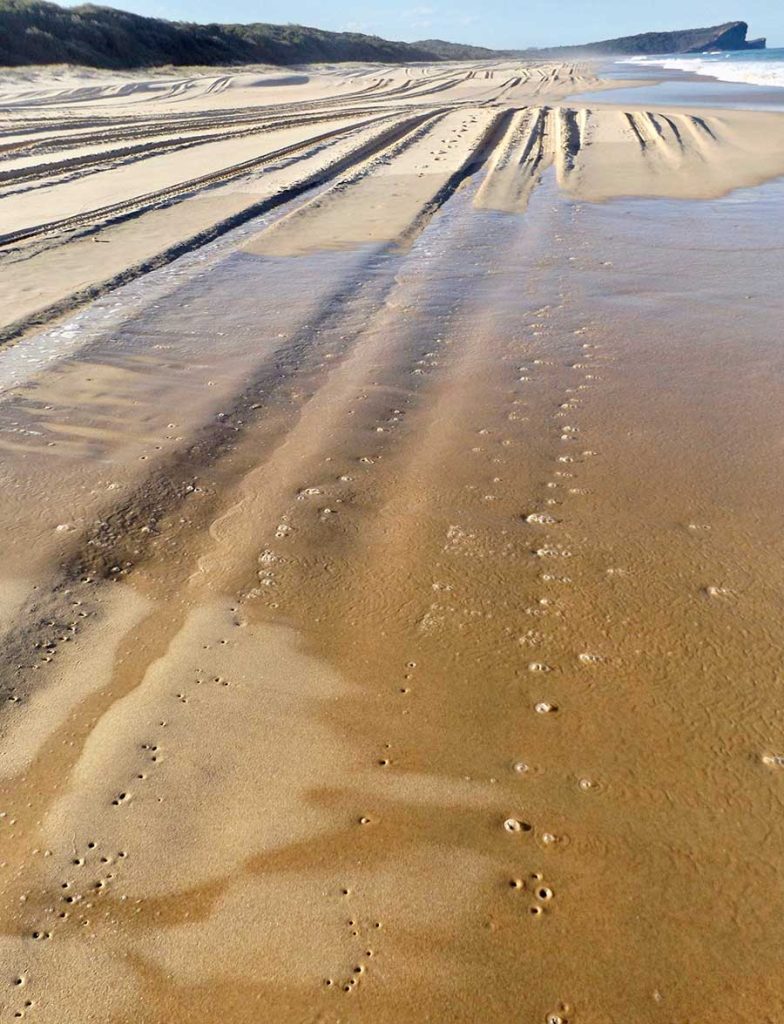
The beach itself was disappointingly but familiarly abused, scored by dozens of 4WD tyre tracks. I watched the air bubbles after each wave receded, and wondered what small creatures were taking refuge beneath the sand. No tiny ghost crab would be game to stick its head up here…
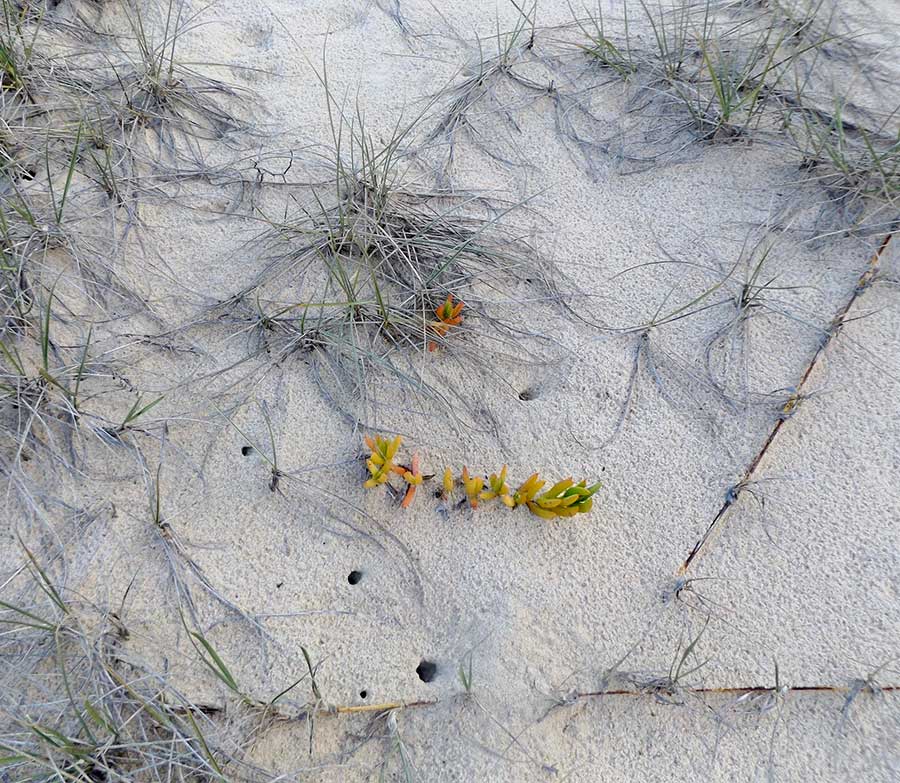
On the dry higher sand where grass is holding it all together, there were fewer tracks — although there should be none — and just an occasional spot of colour like this succulent, where another plant struggled to get going.

As I walked back, I felt truly home when this lone kangaroo stopped to watch me.
Nîmes nostalgia
This will be my last post from my travels. I could have done many more and will surely keep finding things I had wanted to share, but I thank those of you who have stuck with me.
I’d have to say that I was most impressed by the attention to what Roman relics remain… like this, preserved out the back of the very modern museum, in a garden of the typical plants of the time, especially aromatic ones.
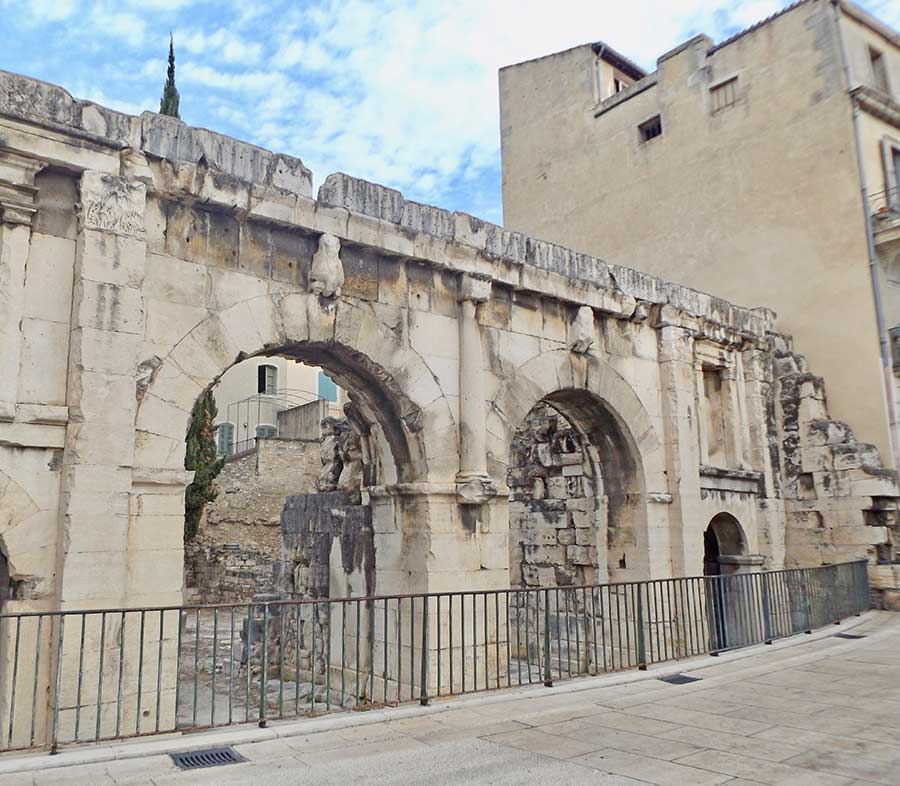
Or this, one of the two surviving main gates of the old Augustan walled town: 1st century, kept on what are now main streets.
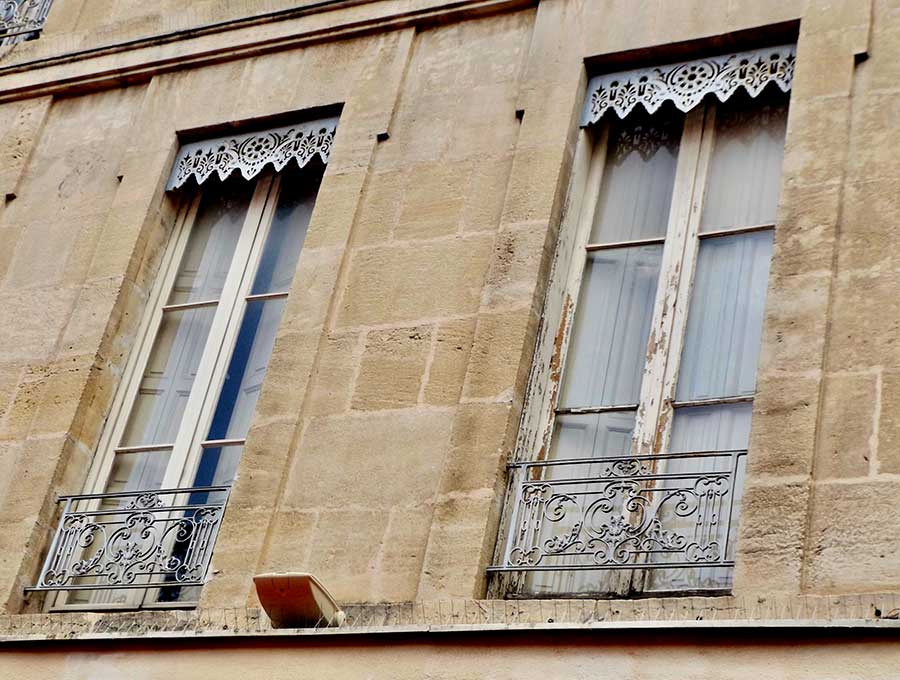
I also loved the charm of the later old streets and apartments, with their wrought iron balcony railings; this one was unusual in having a decorative upper trim, like a metal picot edge.
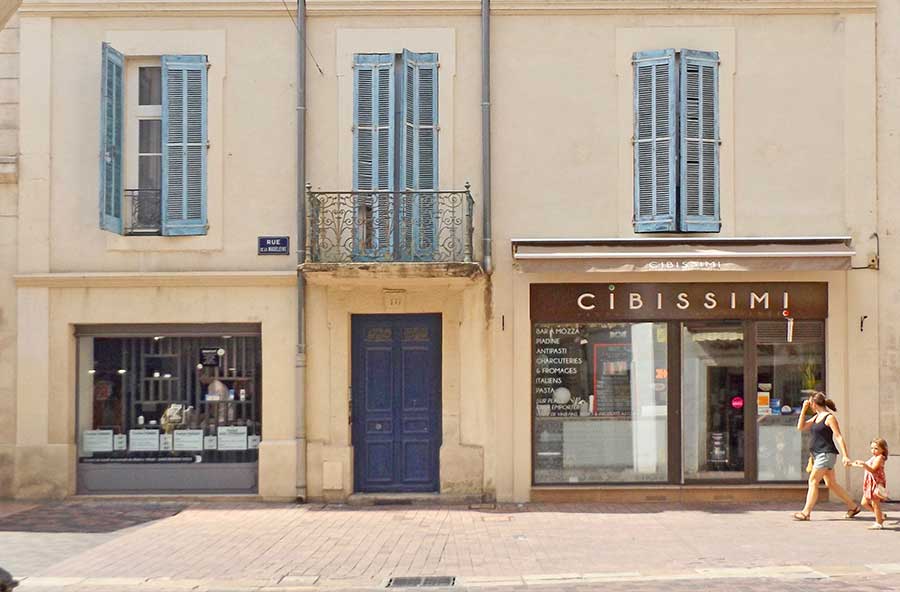
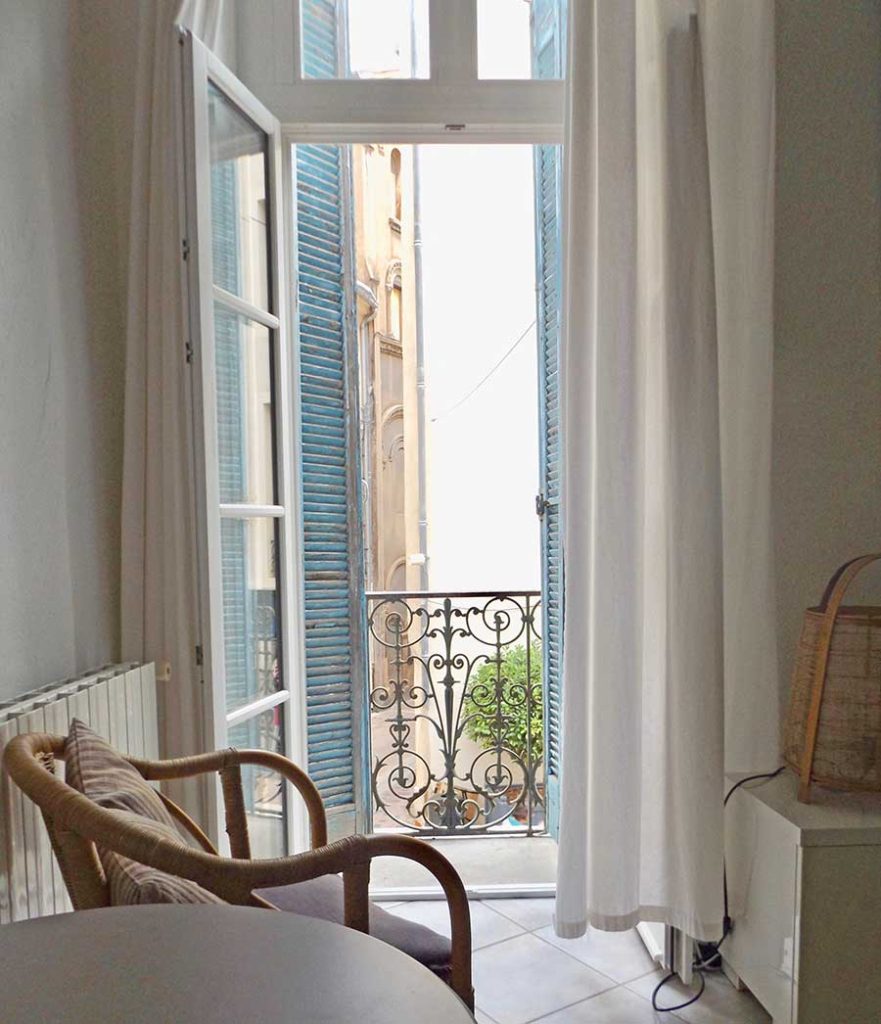
Where I stayed was a delight, with three French windows and aged blue shutters, right above a lively street, with buskers and bands, street stalls and crowded cafés. Being in the old town, no vehicle traffic… except for the small garbage trucks, collecting by hand in the wee hours.
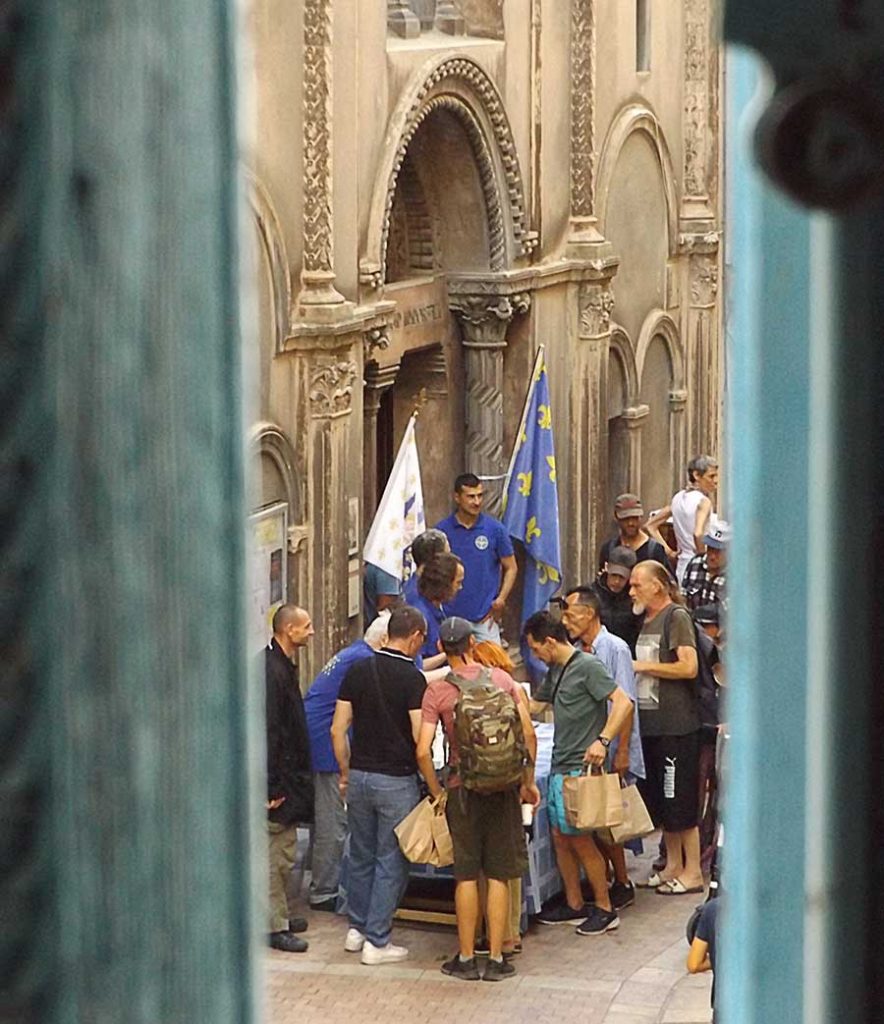
I saw a lot from my front row seat.
Just across the way, in the next little street, was a church which ran a soup kitchen once a week.
Nîmes was busy with shoppers for the many boutique offerings… but also regular beggars.
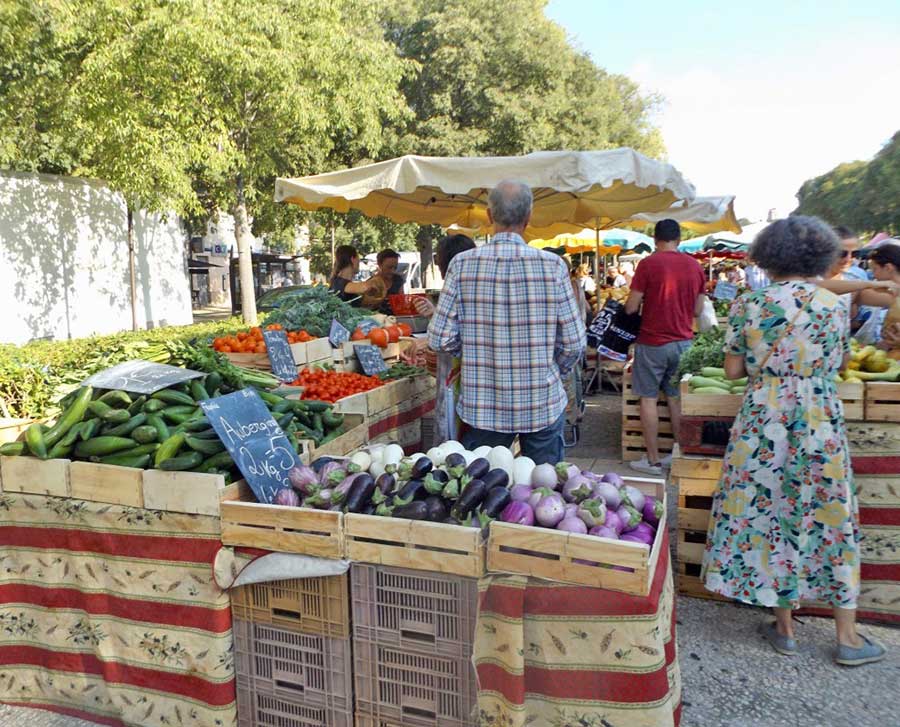
Although I had the wonderful big Les Halles covered market close by, I also went to this one on my last Friday. I loved that stallholders were by now answering my questions, asked in my Aussie French, with floods of French, so it can’t have been too awful…
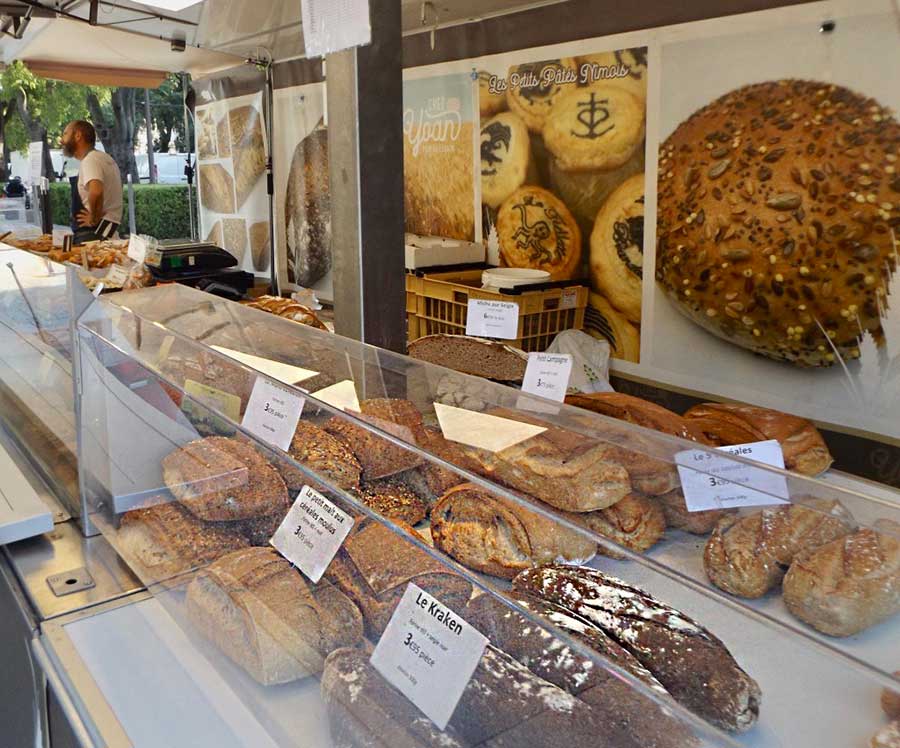
I could have stayed in France just to eat… the great variety of crusty breads in different flours; the aged cheeses with crusts like rocks and tastes I will forever miss.

There were many marvels in the museums, while not answering all my questions.
The Museum of Old Nîmes was unsatisfactory as to how and why and if ‘serge de Nîmes’ became the ‘denim’ of Levi-Strauss jeans.
The old wardrobes made me wonder how anyone slept in a room with such overly decorated monstrosities.
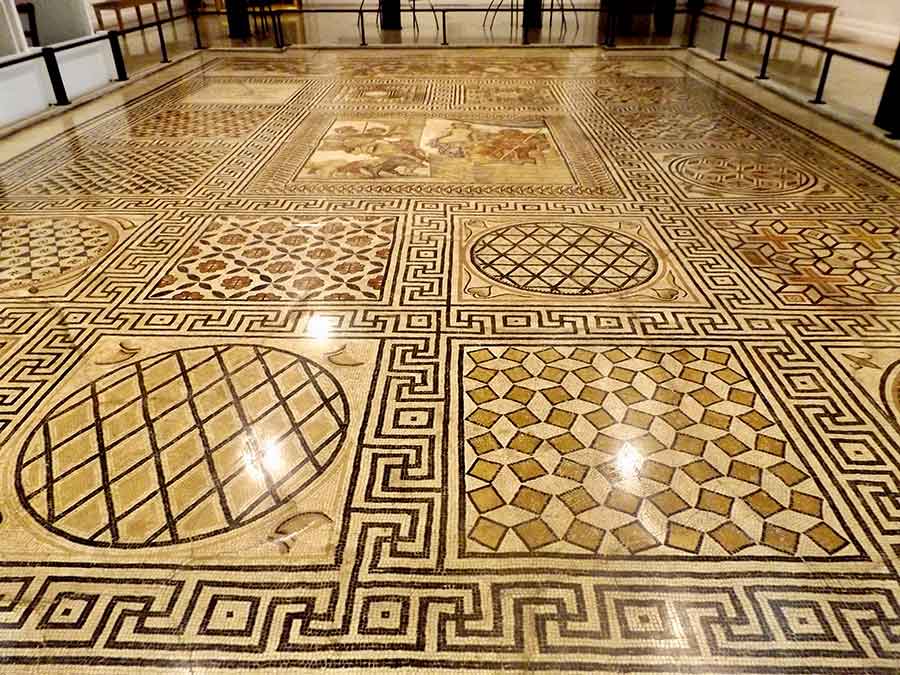
The Museum of Fine Arts had an amazingly intact Roman mosaic floor, discovered in the 19th century and relaid here. I noted that while the central piece is figurative, the rest is geometric, including several Escher-like patterns. Was there anything creative they had not thought of?

I enjoyed this Museum, but did wonder why the 18th century painters gave Cleopatra a perpetual wardrobe malfunction. No matter who she was meeting, like Mark Antony, she seemed unable to stop her dress slipping to expose a boob. Those handmaidens need talking to…
I come home with a head full of new understandings and images, so I thank the friends who made this trip possible, this experience of a lifetime, surreal though it seems in retrospect.
Ancient engineering marvel
This enormous 274m long stone structure appears in the landscape as if from nowhere. Cars are now held back from its proximity, so you walk –along with many others – and suddenly there it is: the Pont du Gard, the tallest and best preserved of all Roman aqueducts.
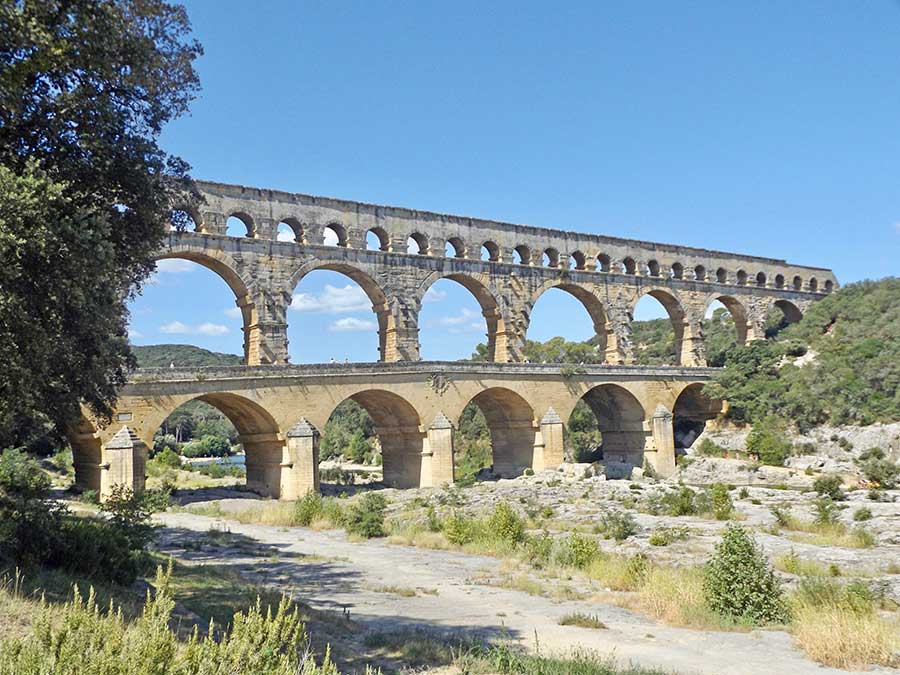
Built in the 1st century AD to carry water 50 kilometres to Nîmes from springs at nearby Uzès, it was designed to have an average fall of 7mm per 100 metres, and it worked! The top level was a stone-lidded conduit, smooth inside, which required much maintenance to keep clear of carbonates and vegetation over the six centuries of its use.
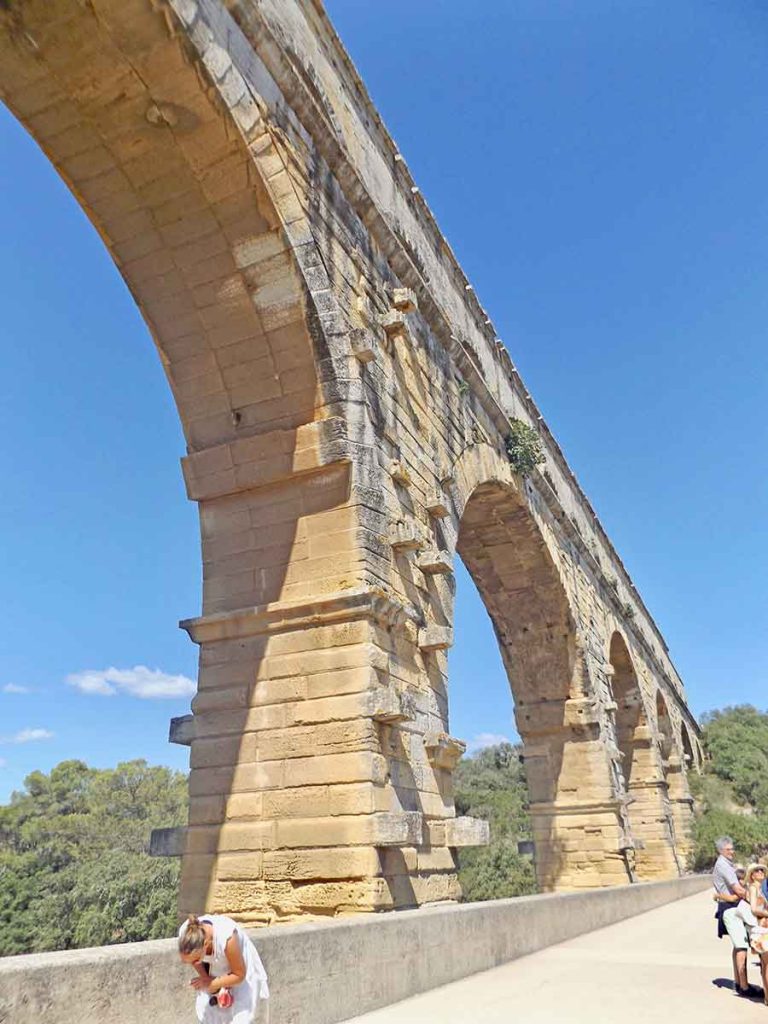
The actual 49-metre high structure is of rough limestone, no mortar. You can see the large projecting stones that supported the scaffolding as it was built. The lower level’s road bridge was added much later; water was the reason for this mighty undertaking.
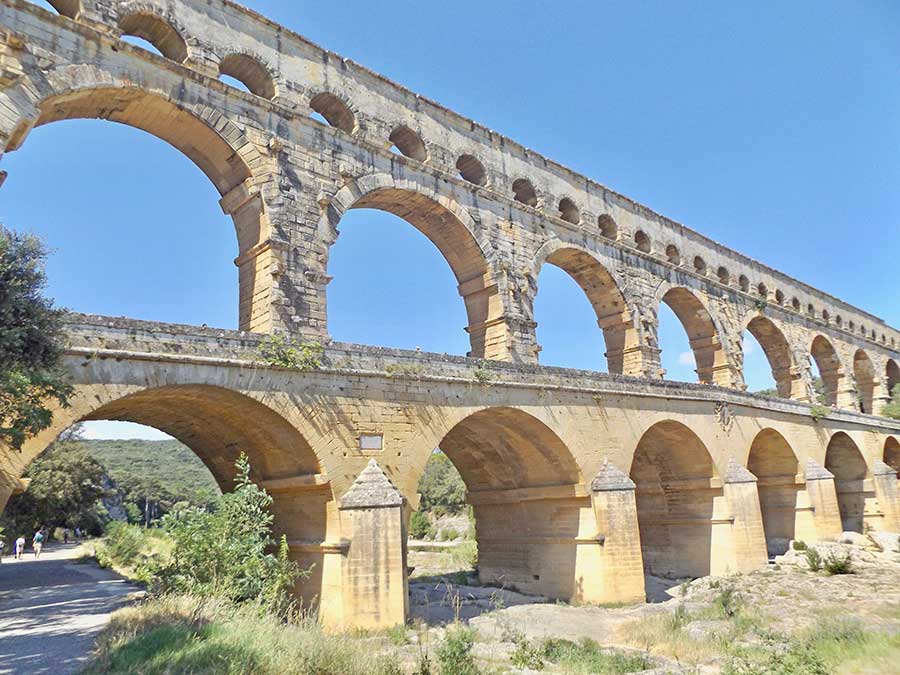
I had mistakenly thought it was built to bridge the River Gardon, but no, getting water to Nîmes was its main purpose. The six arches of the lower level are six metres thick to cope with that river’s flood. The history of the Pont is chequered, but Napoleon figures large in taking on its restoration.
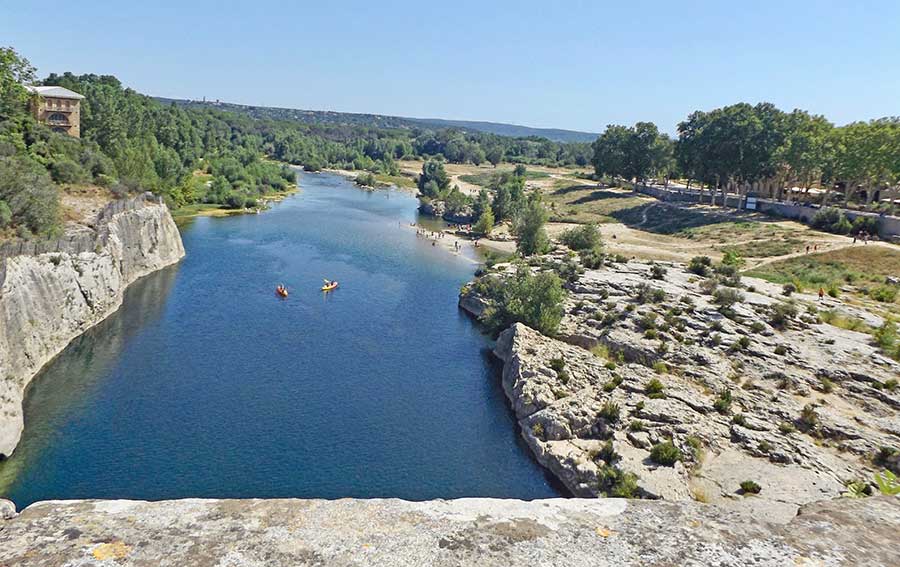
The river is treated as a swimming and boating place by many and as cars can access each side of the river, people can walk to its sandy beaches.
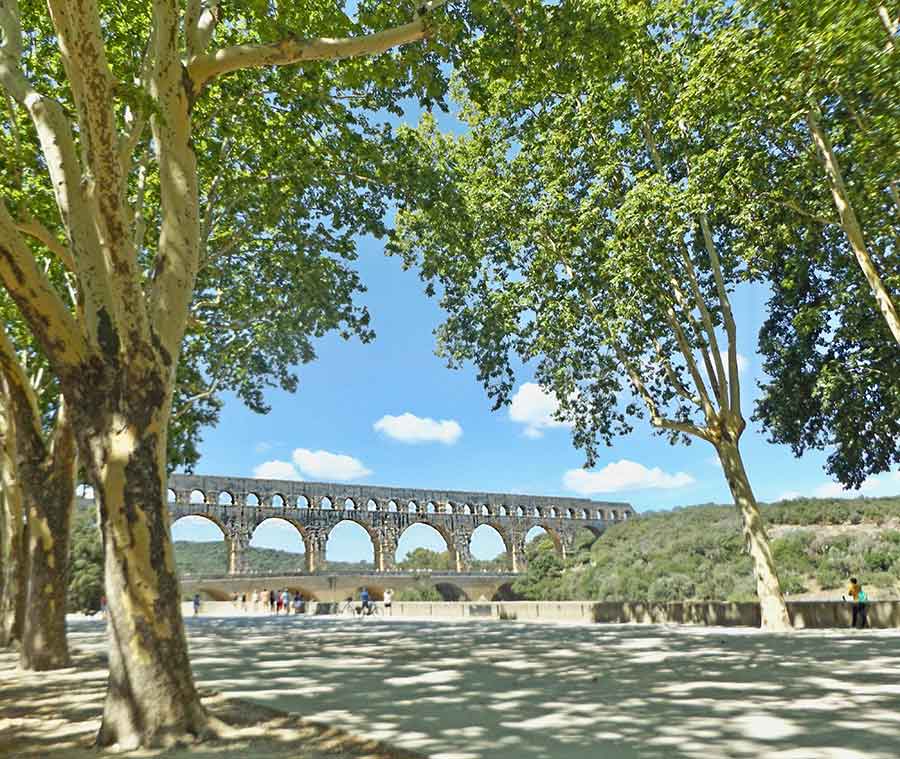
On the far side is a large park and promenade, with cafés and seating and playground, and walking access to the beaches. It seemed a very popular place for families.
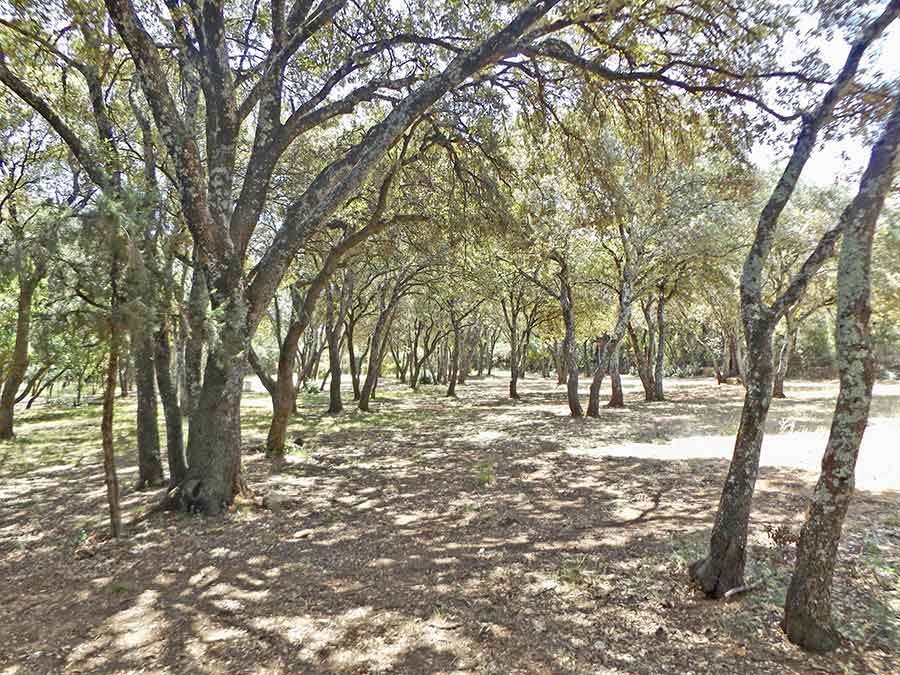
Back on the main tourist access side, I briefly visited the Memories of the Garrigue park, where the original ‘garrigue’ vegetation and the typical early land use, of grain and vines, as well as making charcoal, was commemorated.
Garrigue vegetation is Mediterranean, likened to our mallee, as its trees are low growing. It can have dense thickets of kermes oak, stunted holly and holm oaks, with lavender, sage, rosemary, wild thyme and artemisia common.
It reminded me of Bimblebox, although many trees there are taller, in its dry grey-green nature, compared to the lush chestnut, oak, lime and plane tree forests I had become used to in Italy.
Many famous people visited this Roman marvel, and many have written of it in awe. UNESCO considers it a ‘testimony to human creative genius’… as do I. The architectural and engineering skills that devised it are astonishing; once more I am struck that such a civilisation was wiped out, and really by greed, for conquering more and more. Greed remains; will we?
City of water
To replace the ancient water sources that had supplied Nîmes for centuries, the huge Fountain Gardens were built in the mid-18th century.
Remnants are still there of the original water holding basin on the hill, which would have received the water via aqueducts, including the Pont du Gard where I will take you next. As these remnants, like those at Pompeii, are extremely rare, I tried to visit, but it was closed on a Sunday.
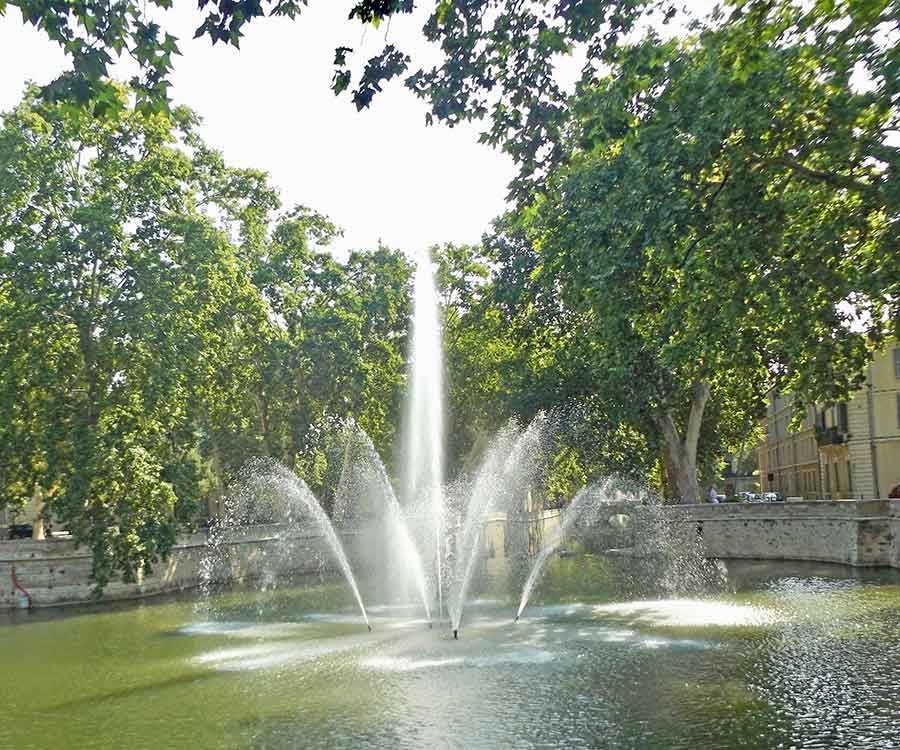
Fountains abound, with walkways shaded by large plane trees.
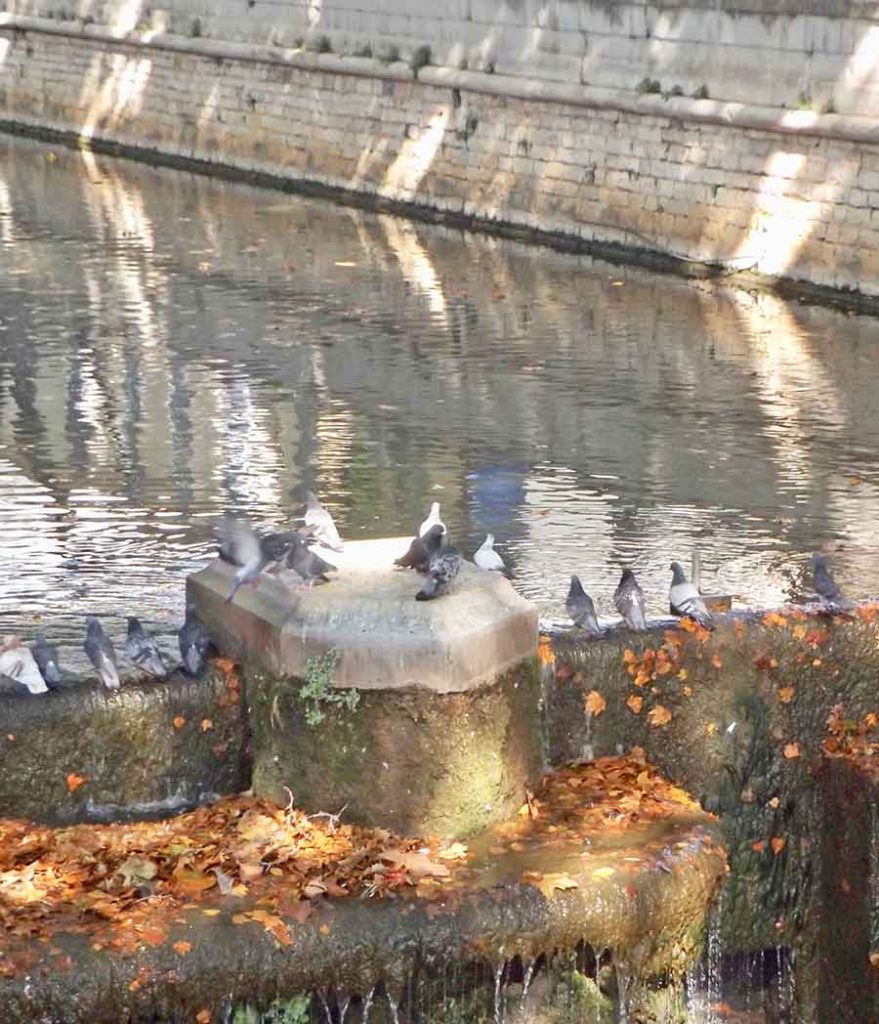
Fish and ducks and pigeons make use of the water, as does the occasional frolicking dog, and once I even saw a swan.
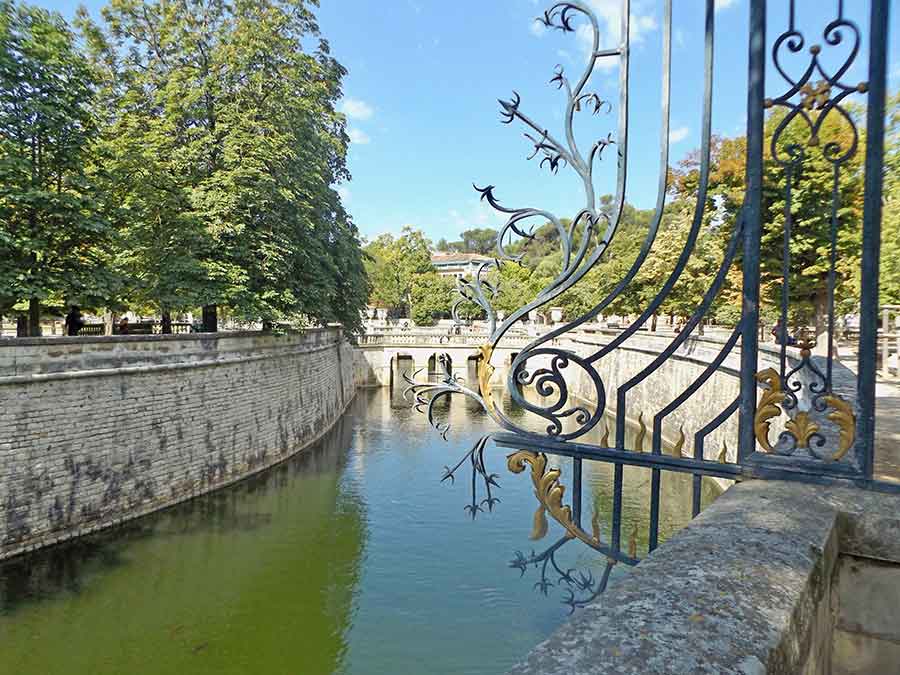
Even the gates are guarded from climbing trespassers by decorative extensions – rather more attractive than rolled barbed wire.
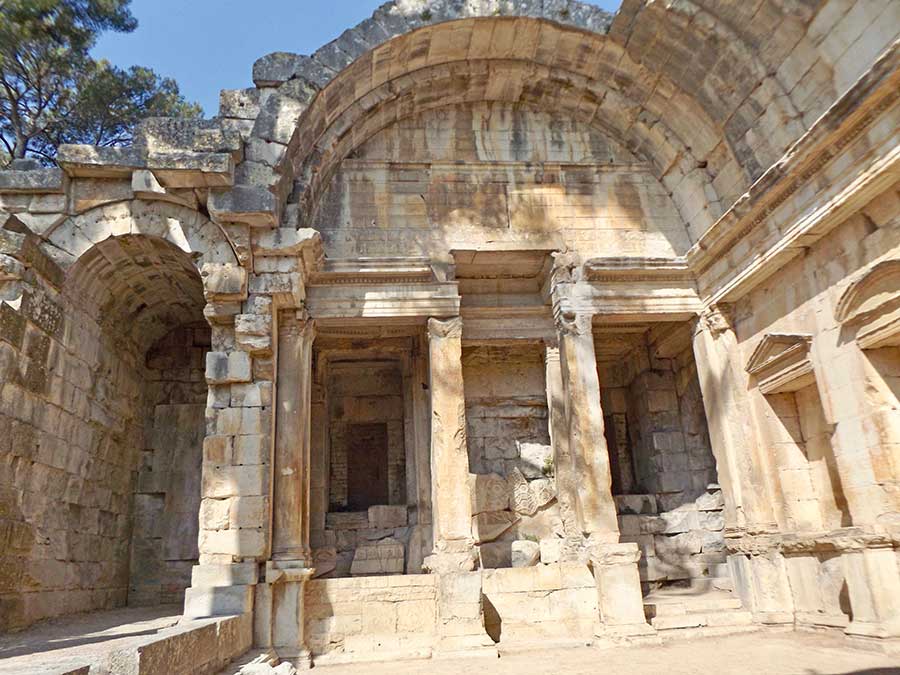
My favourite ruin was this Temple of Diana, from the 1st century BC: possibly not to Diana, possibly not even a temple. Romantically shrouded in mystery and time…
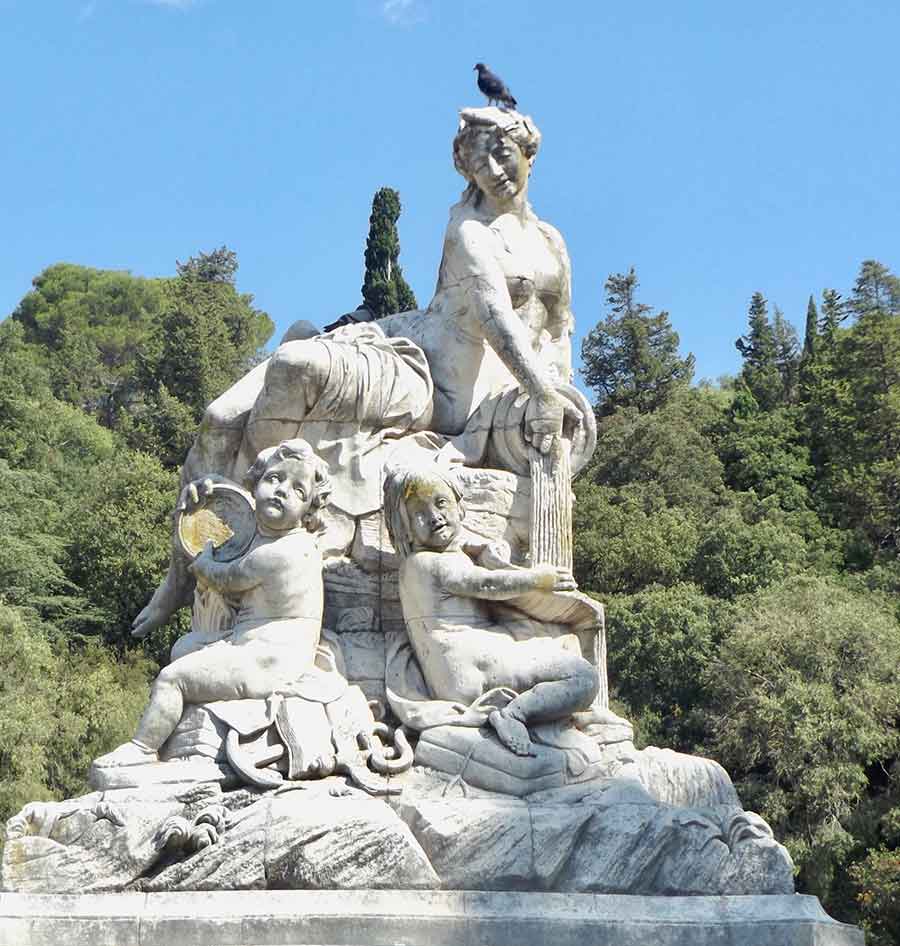
The central basin has this Nymph statue… with attendant pigeon, but as usual I wonder why the wingless cherubs below look so miserable.
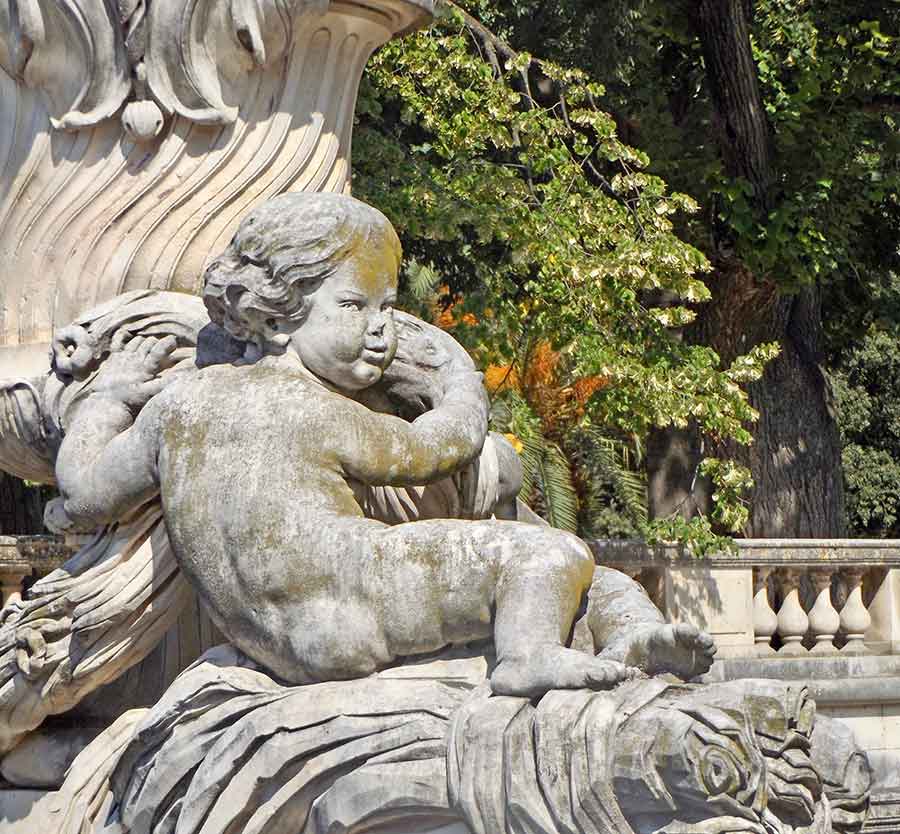
This one looked positively demonic.
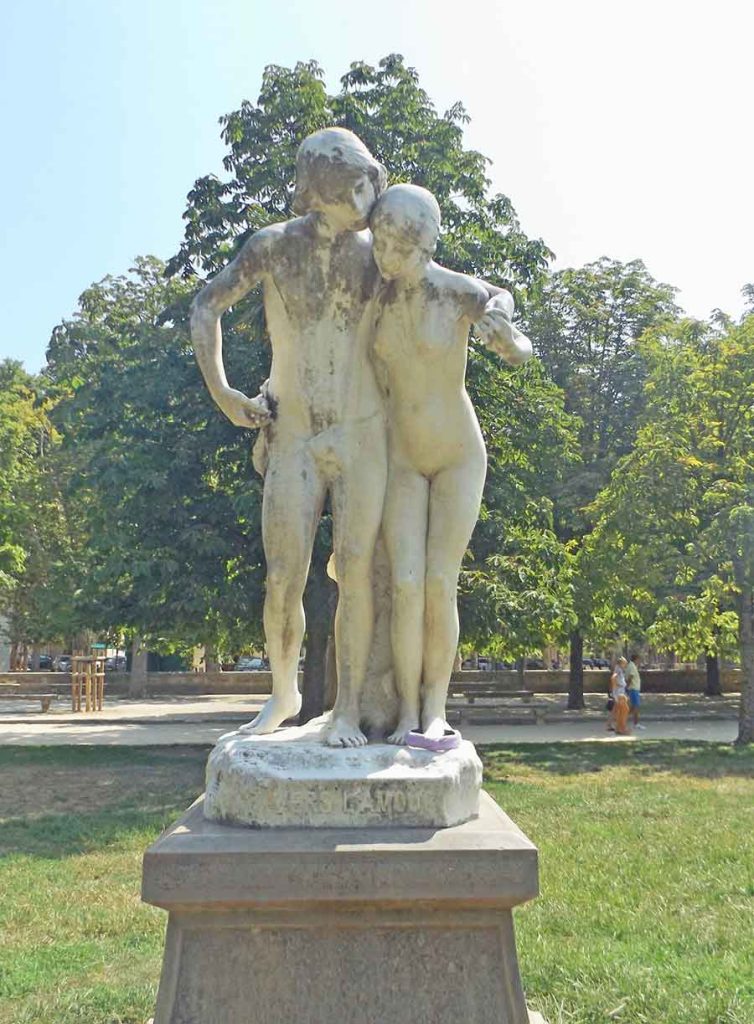
The Gardens were full of statues, but I especially liked this gentle one to Love… quite young love too.
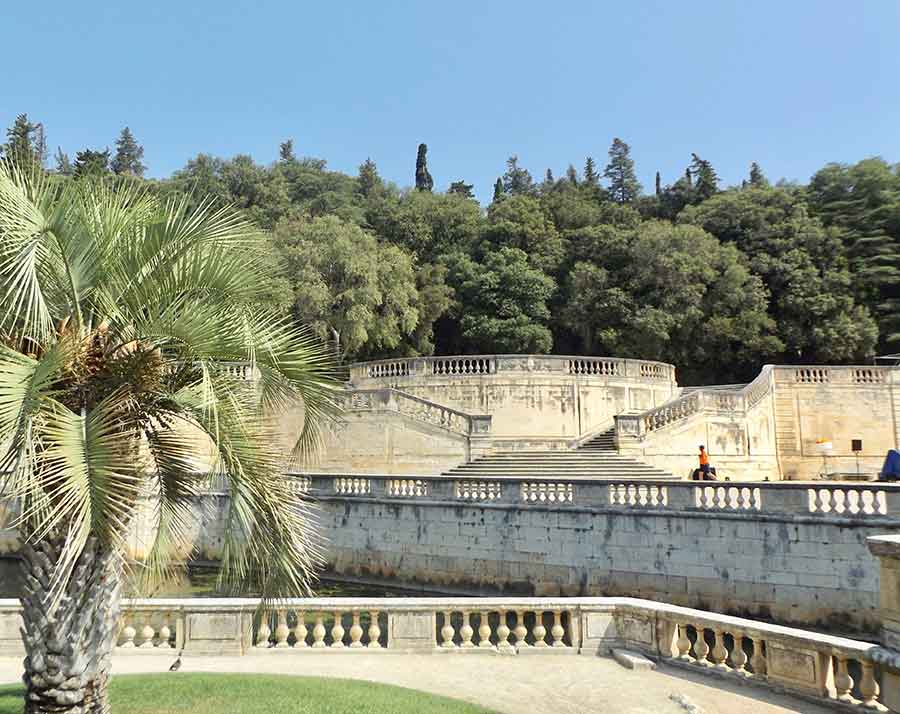
From the formal pools and waterways, paths wind up through a shady forest to the 36 metre high Tour de Magne, once part of the defensive Roman walls around the city.
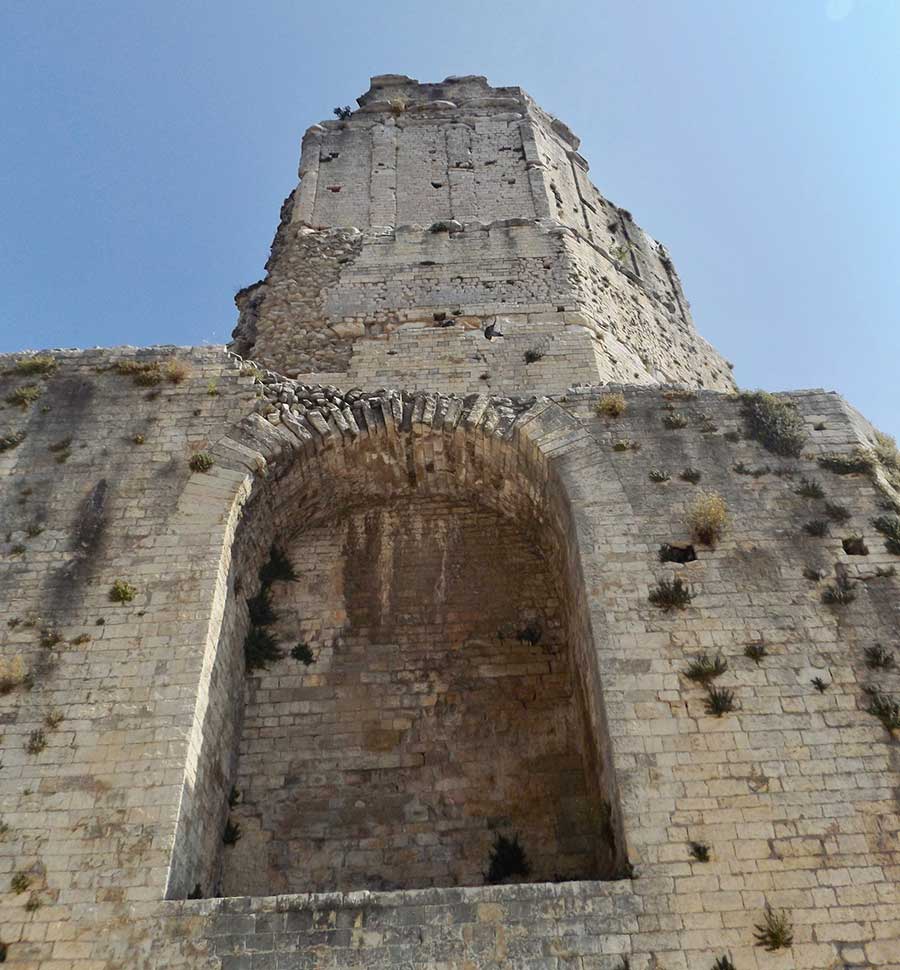
I had intended to climb up the internal spiral stairs, but I chickened out. From the outside, looking up at those who had made it, I knew I’d been wise. Bugger the view.
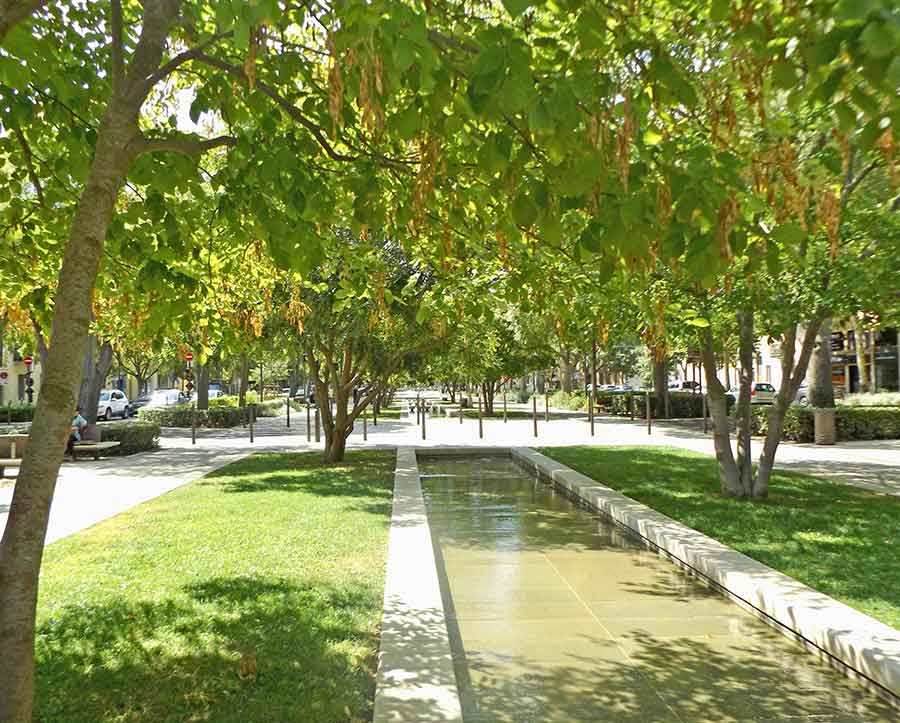
But even away from the Fountain Gardens, in the centre of main avenues there is water, shallow, unpretentious, just coolly flowing along.
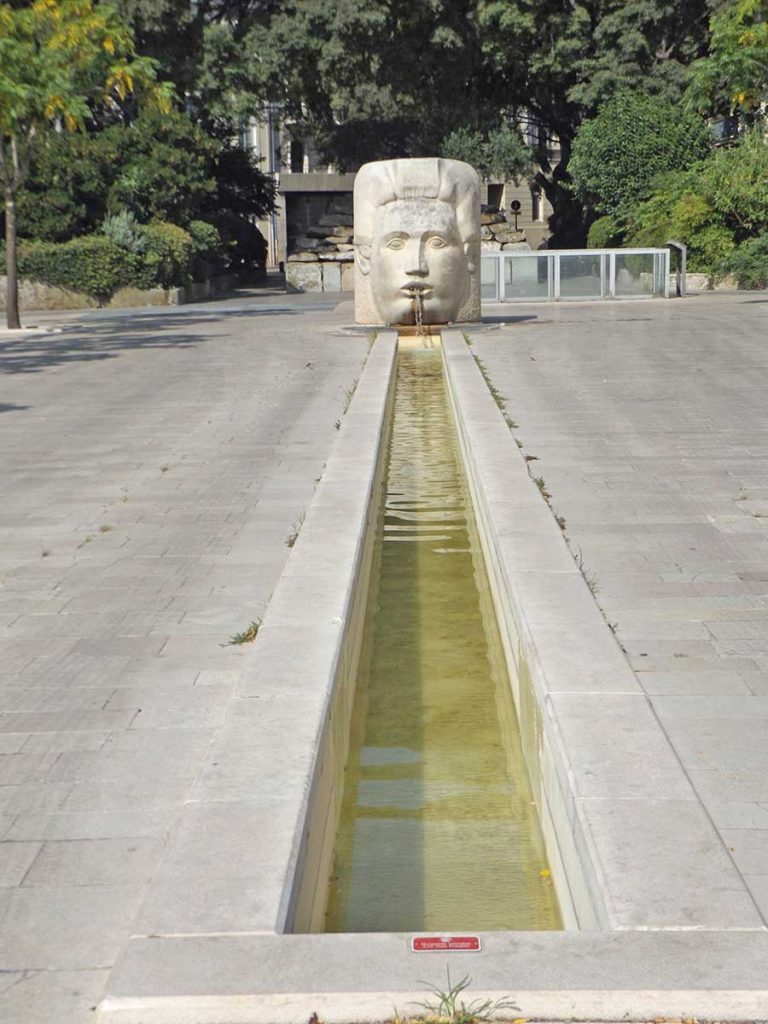
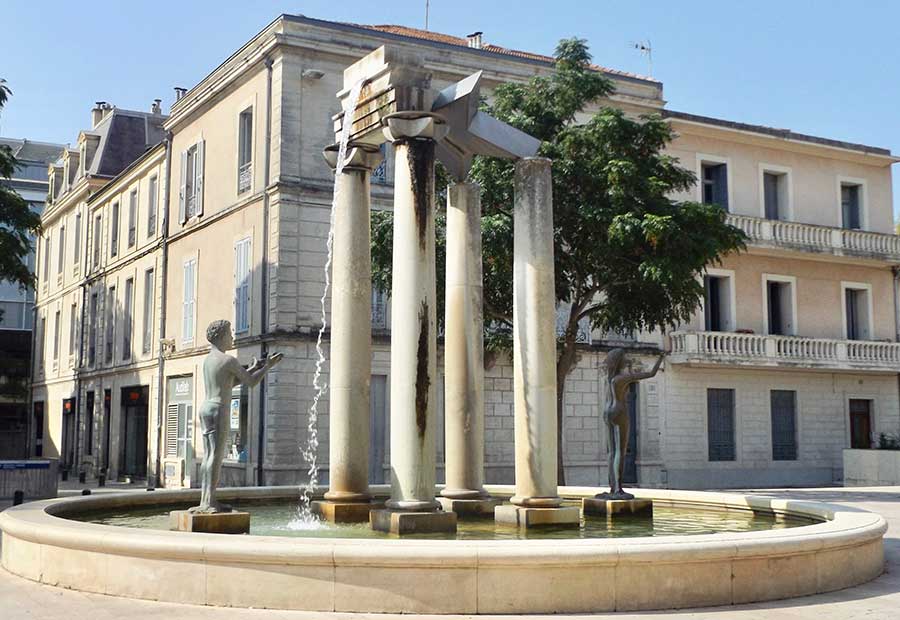
Sometimes, as in the modern Place d’Assas, it is combined with statuary, non-mythological, but still symbolic.
Nîmes still appreciates its water origins. So do I.

